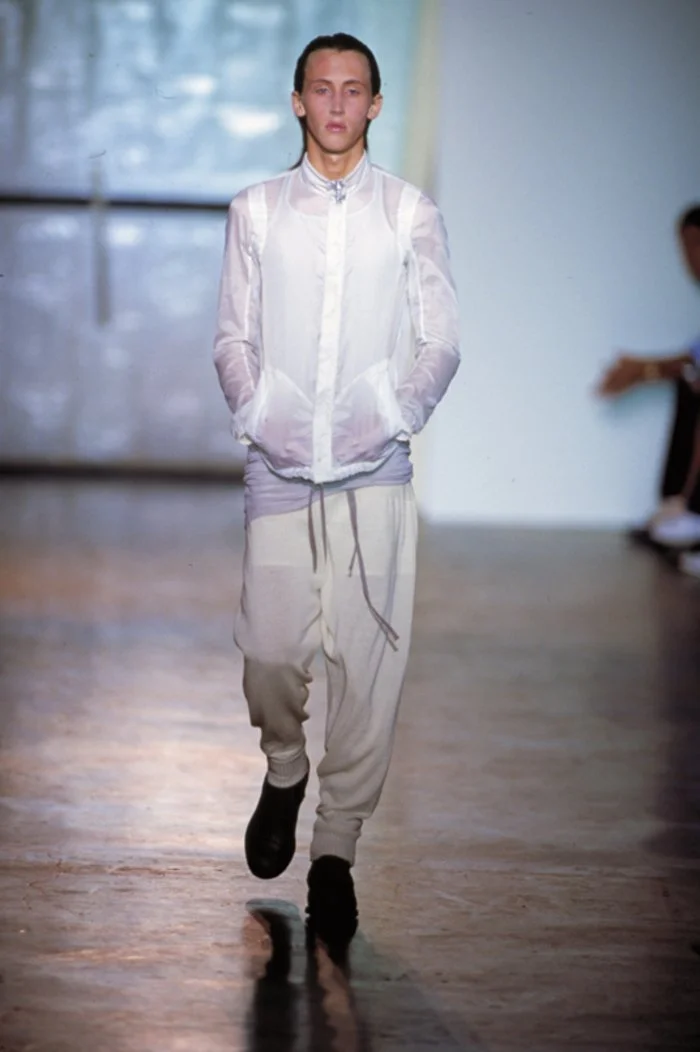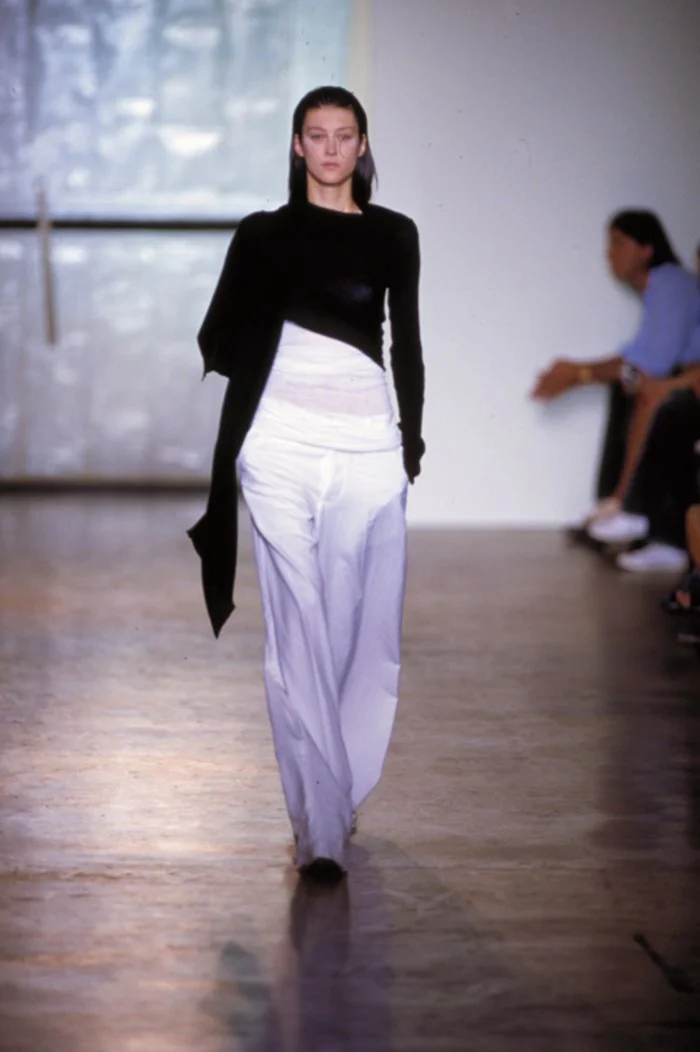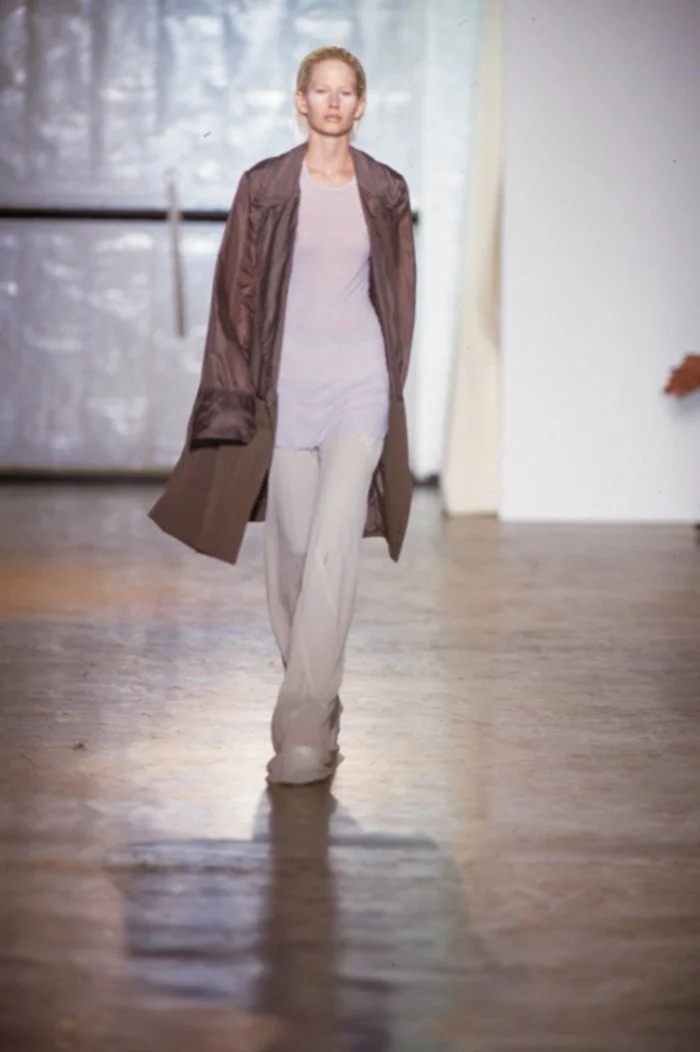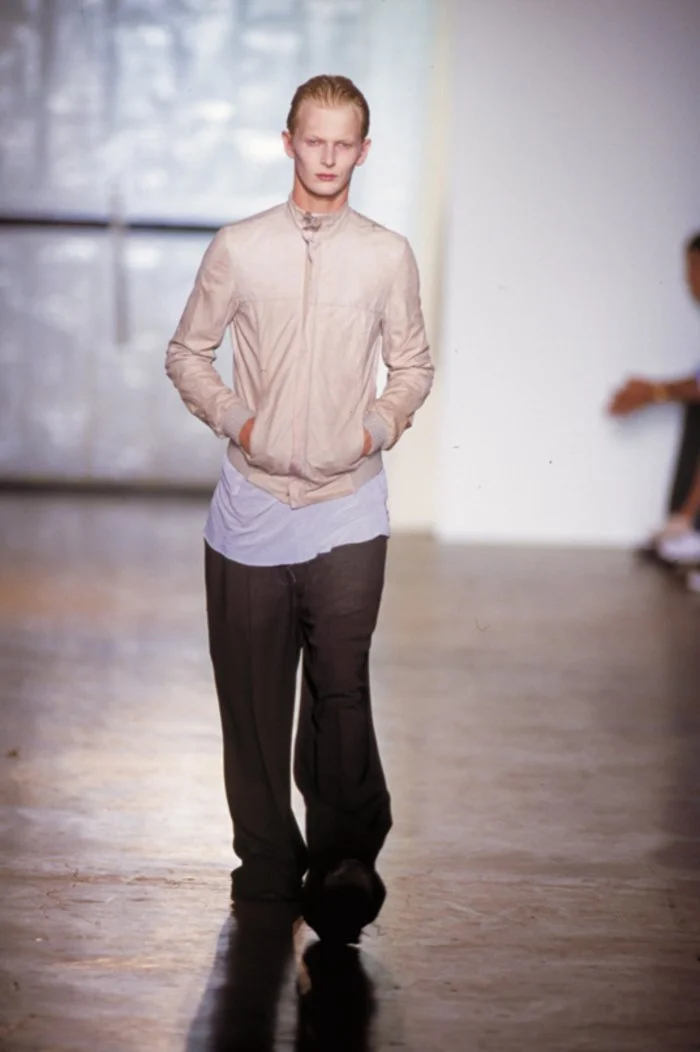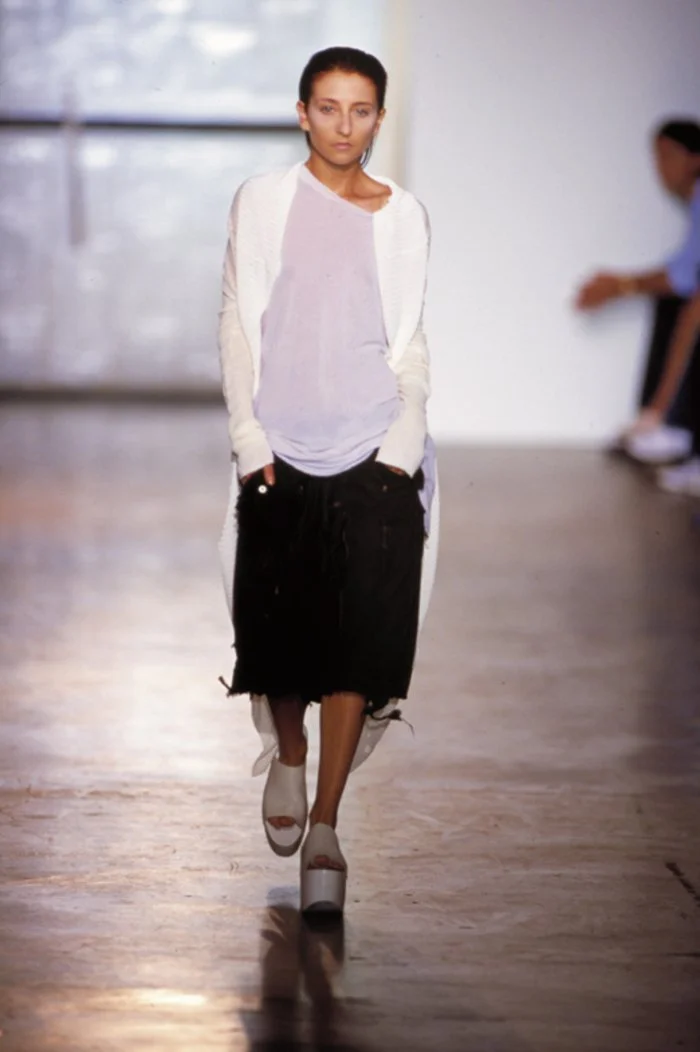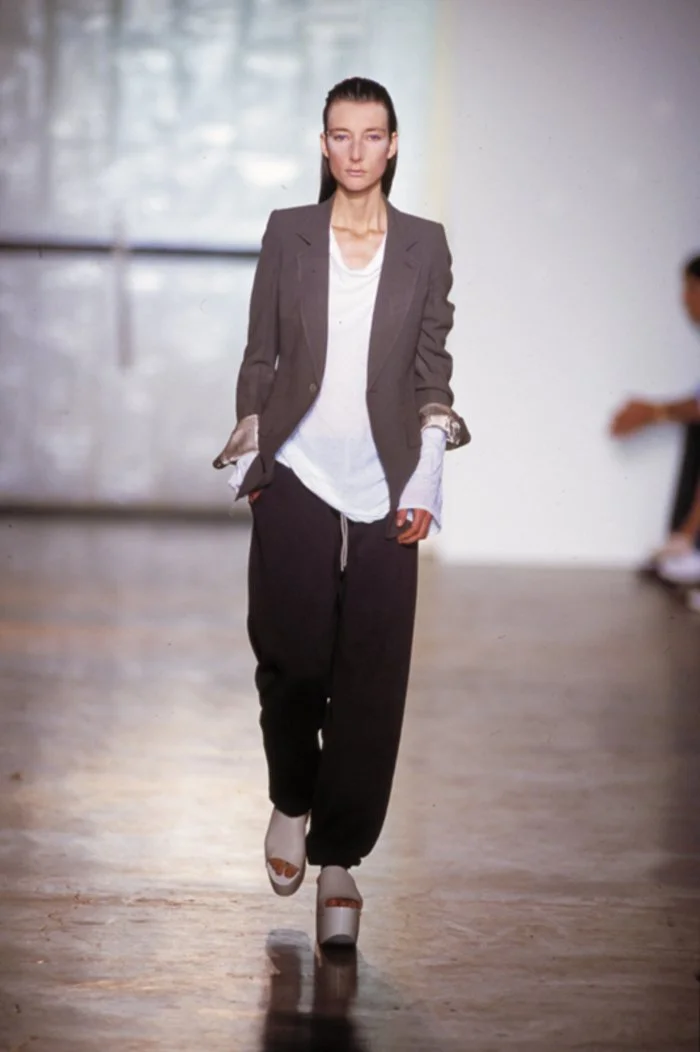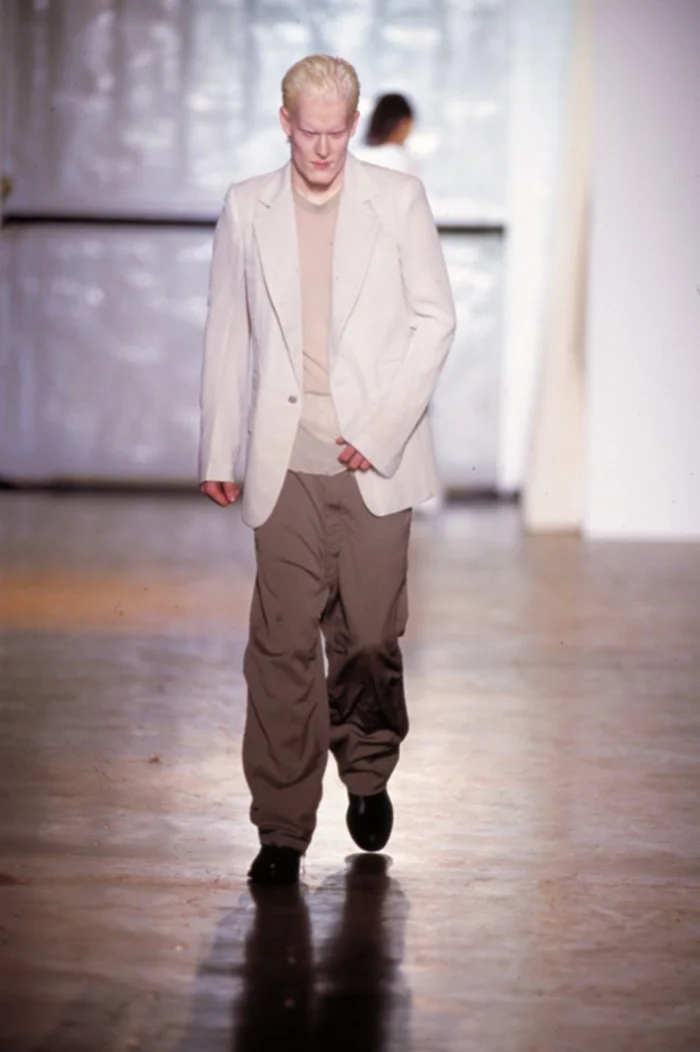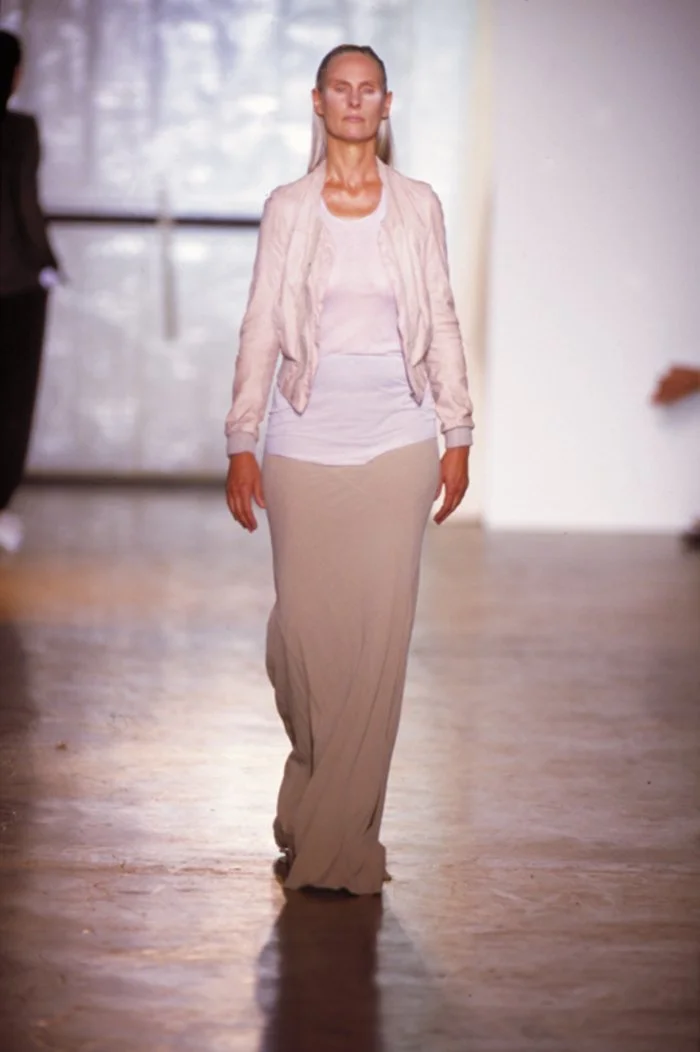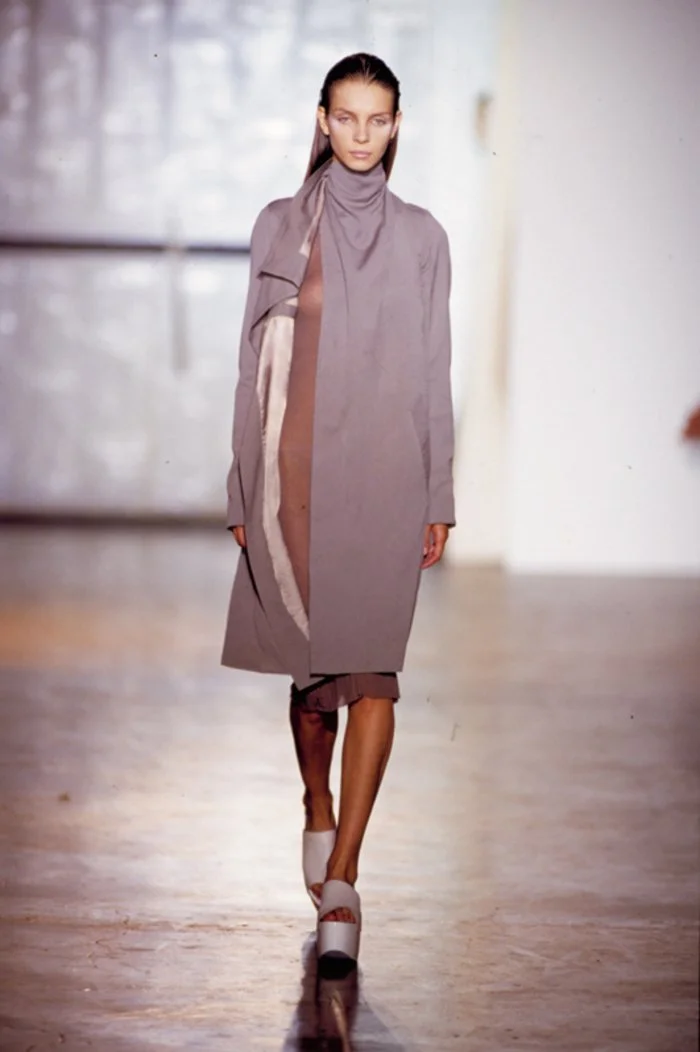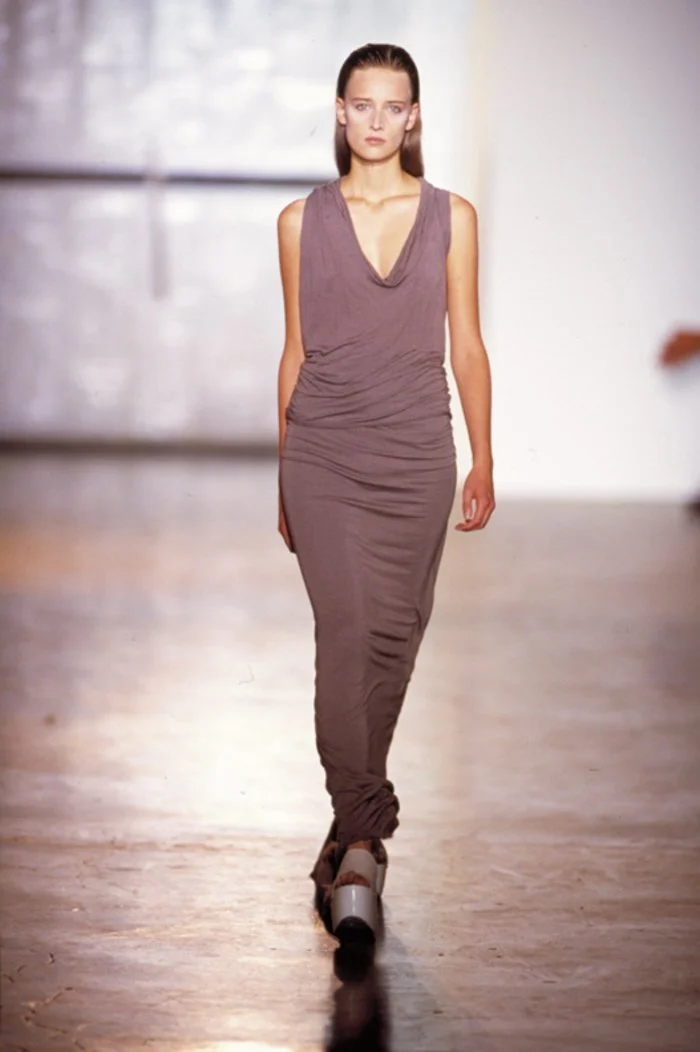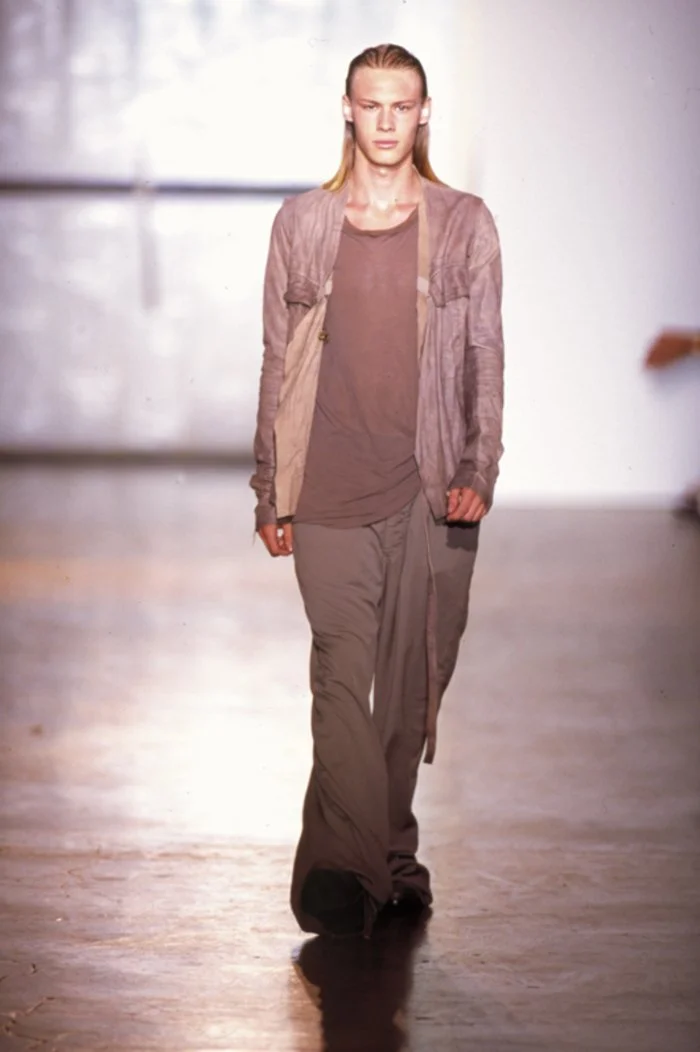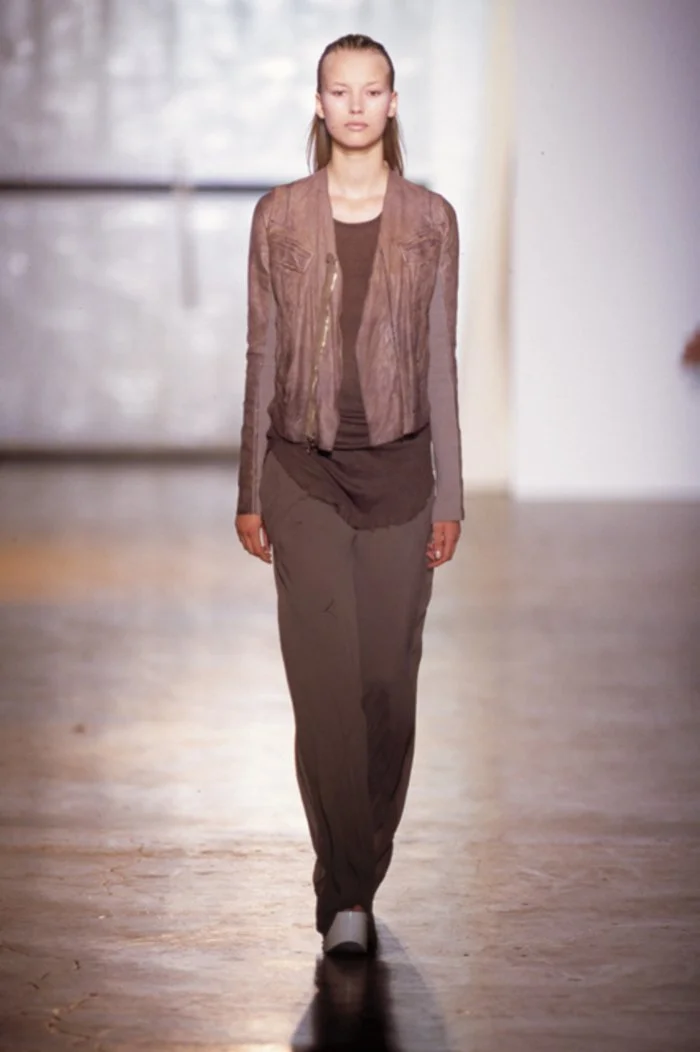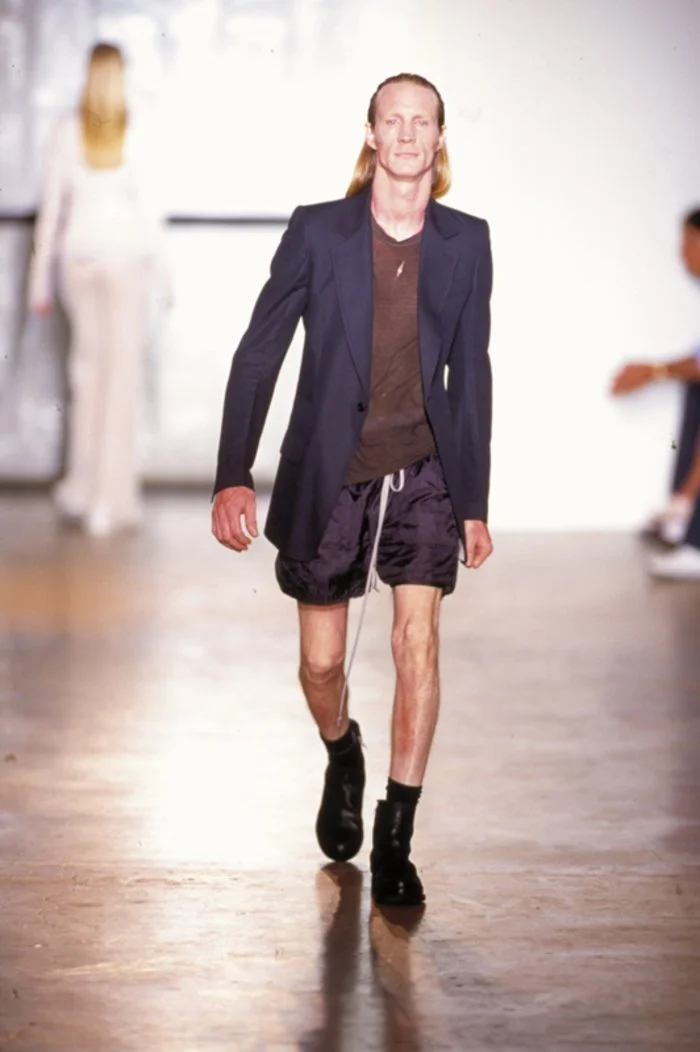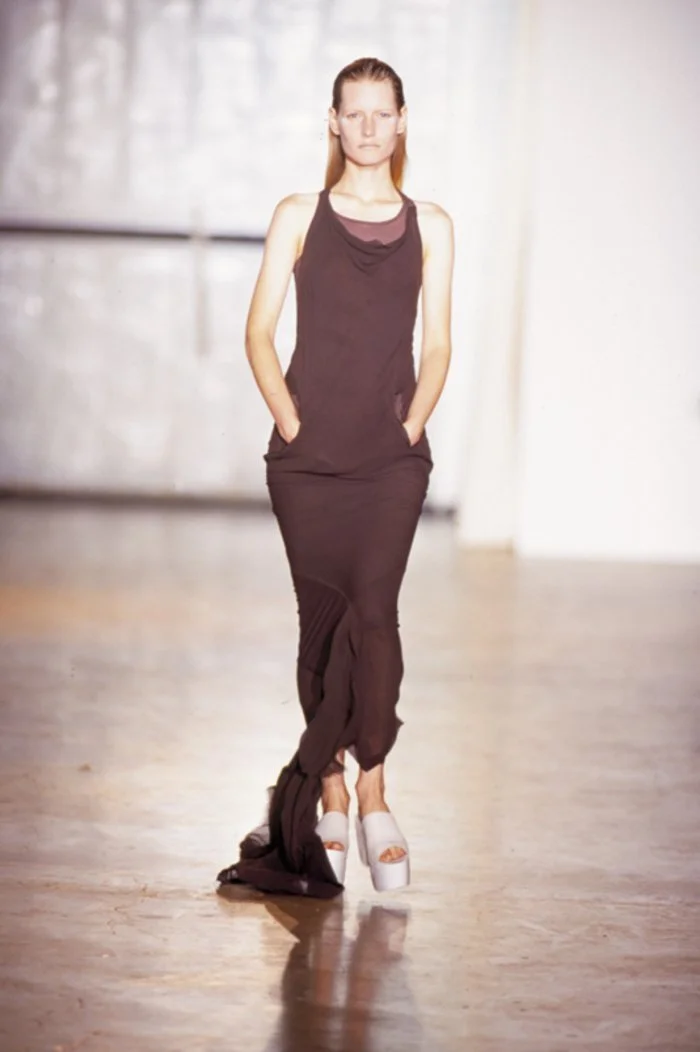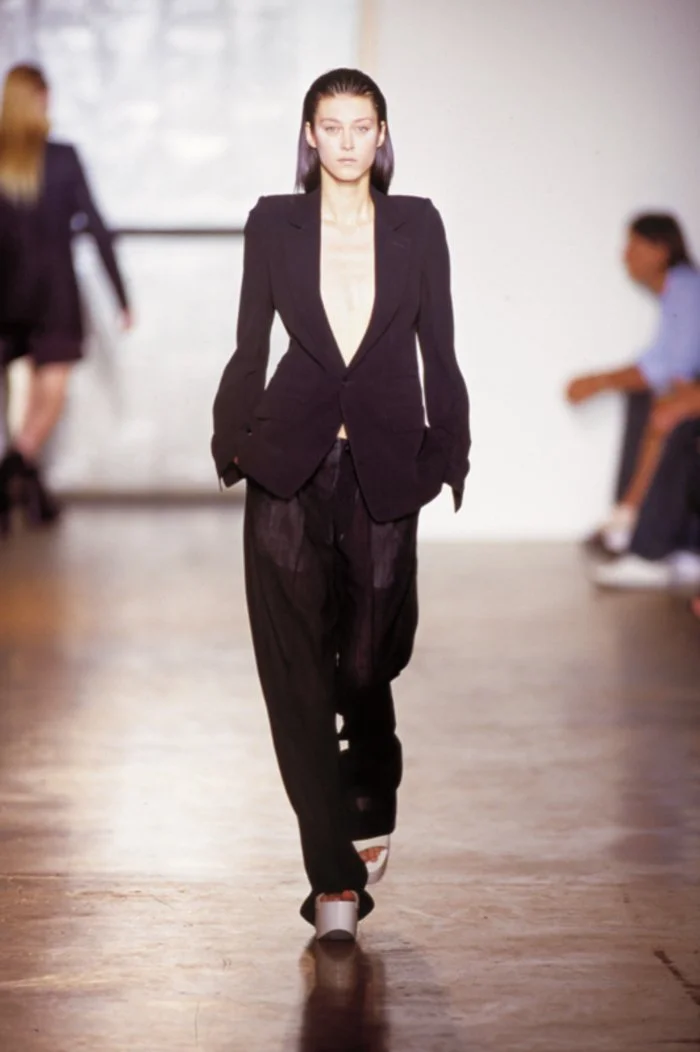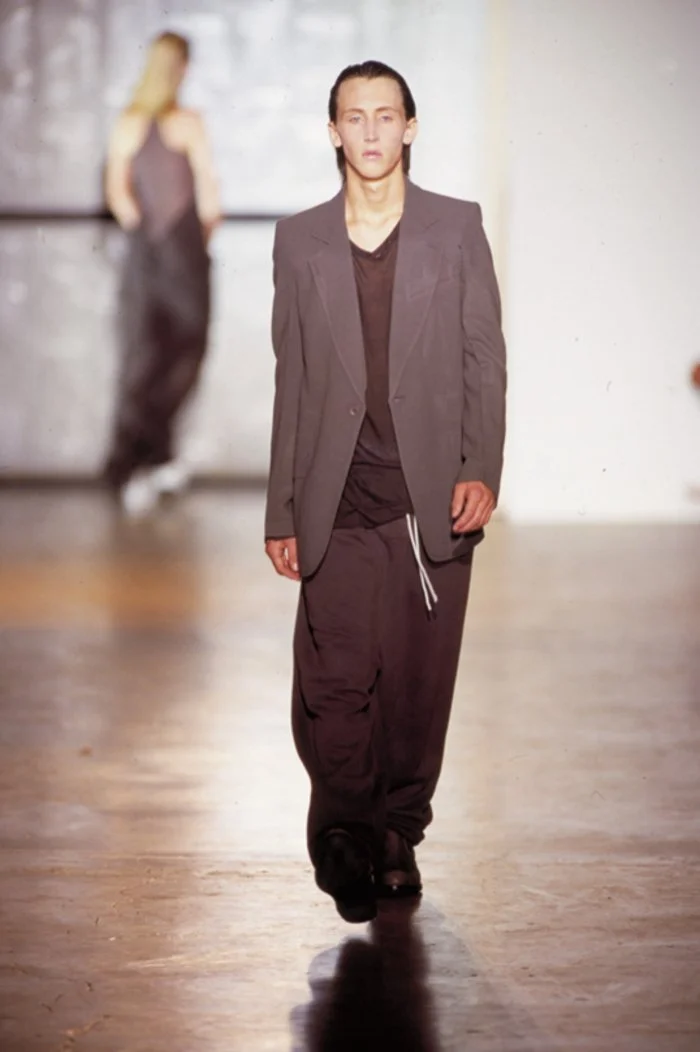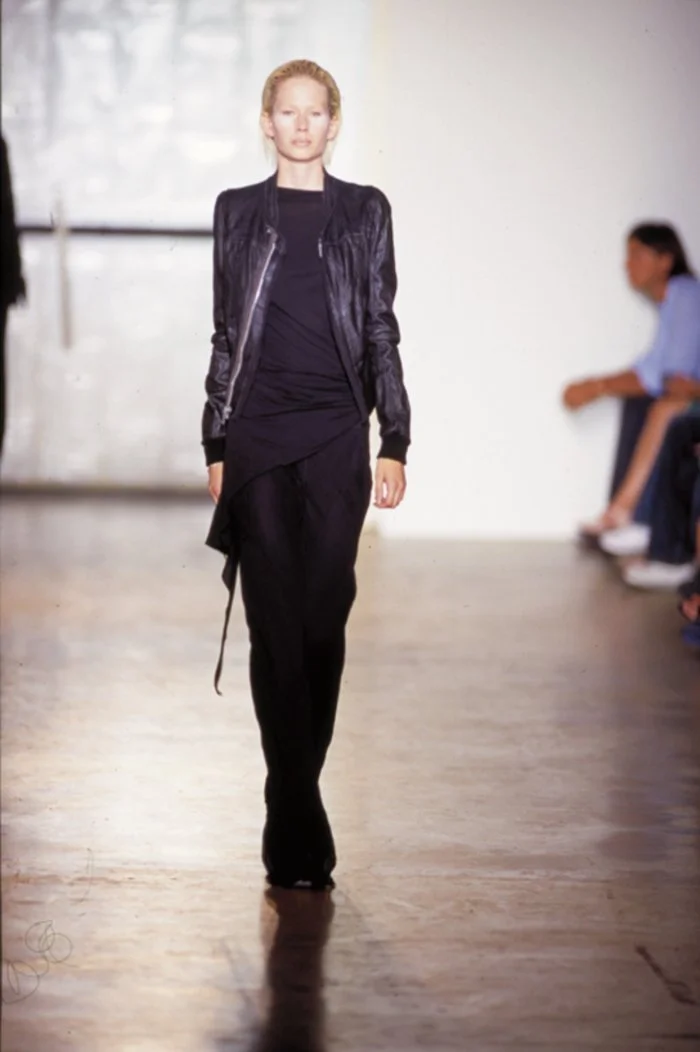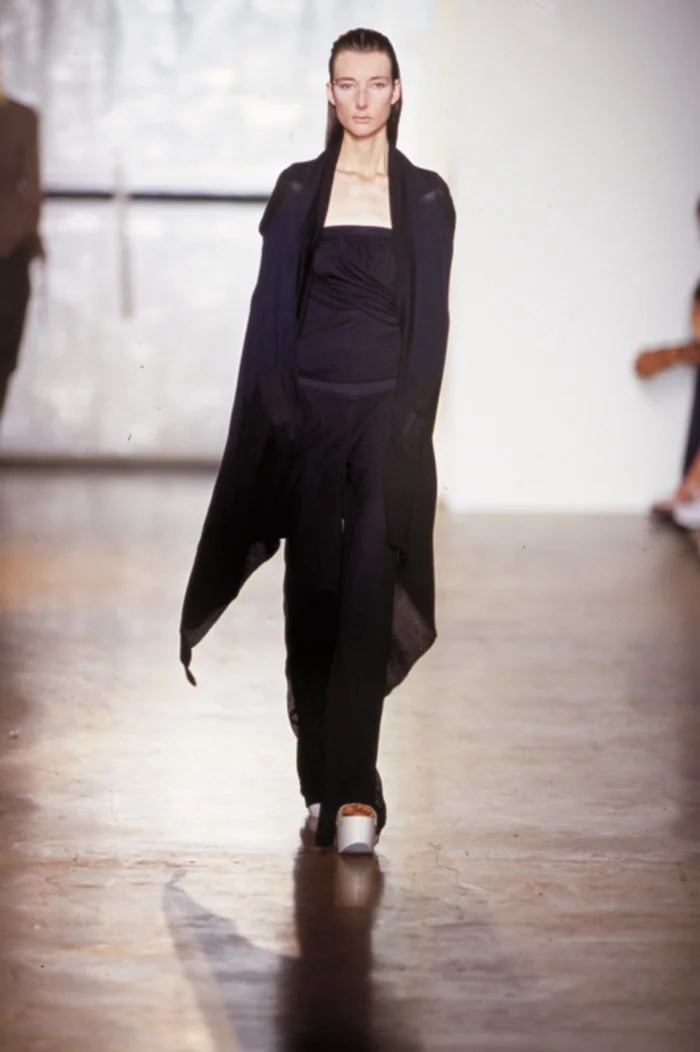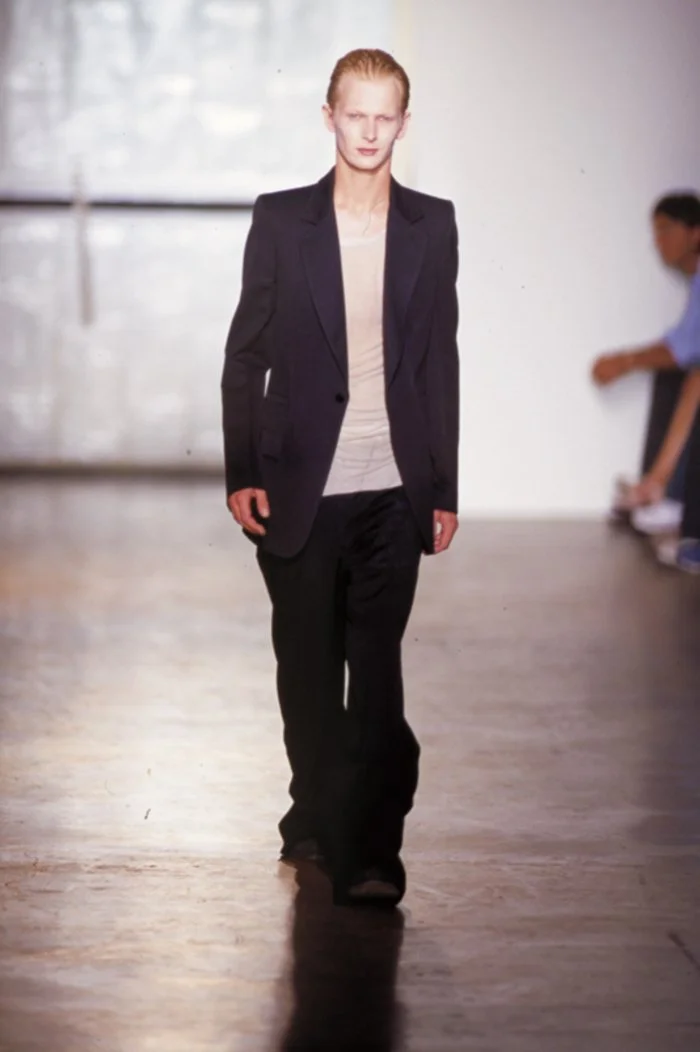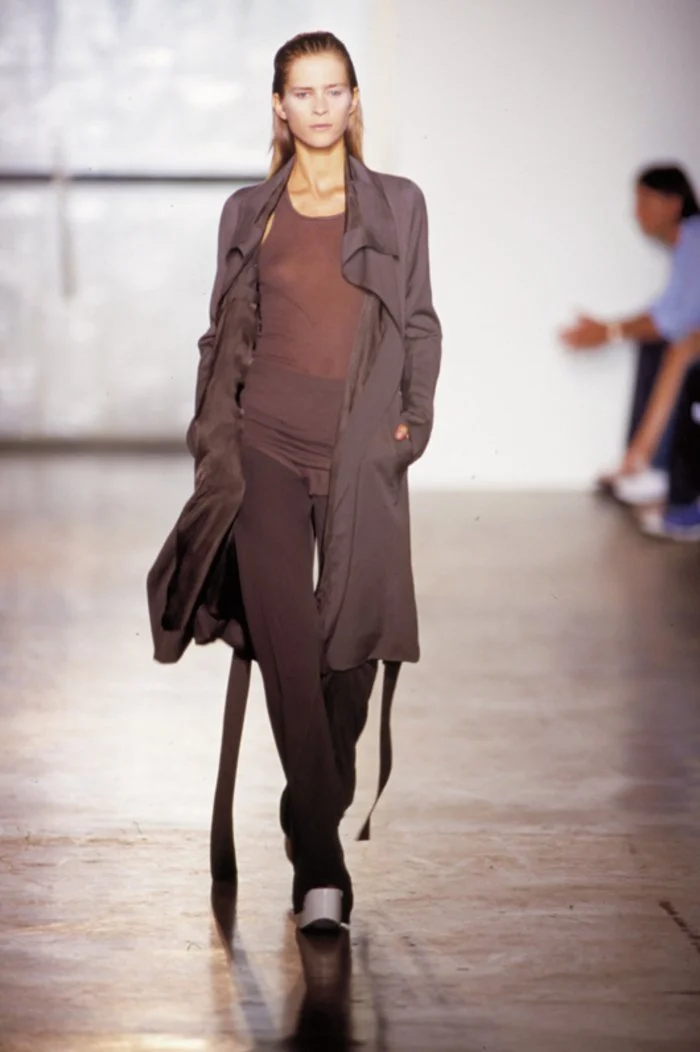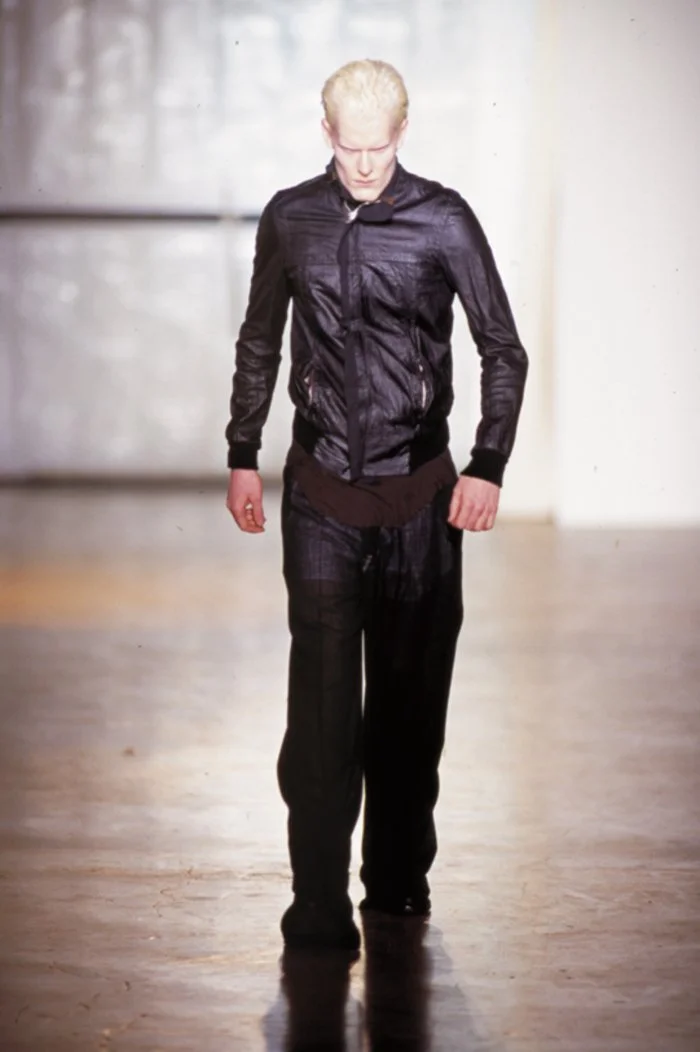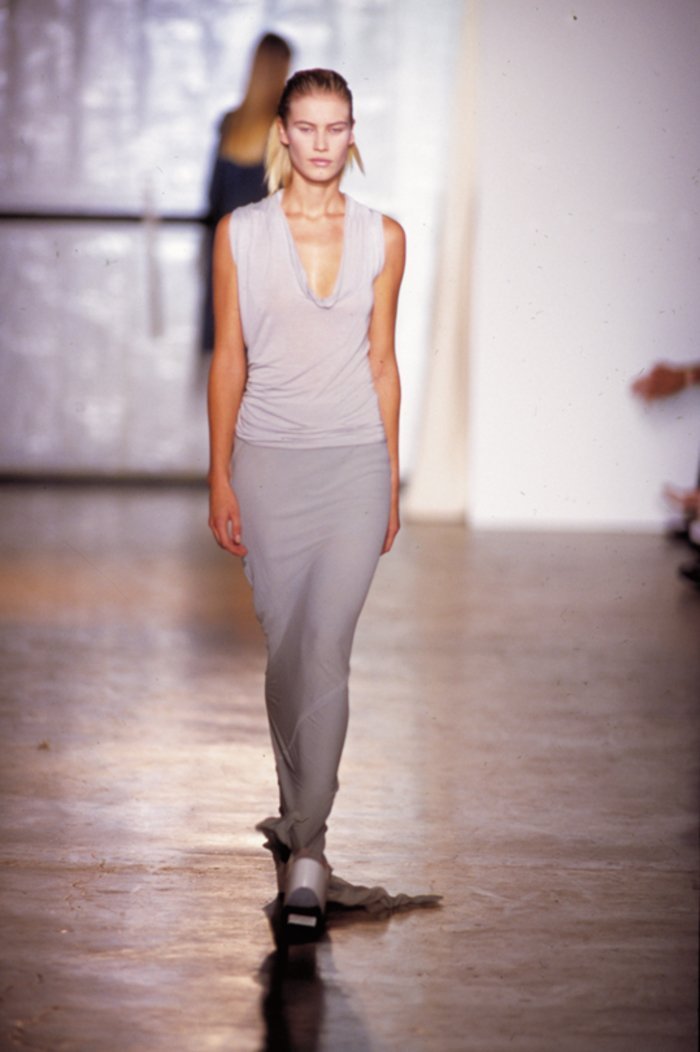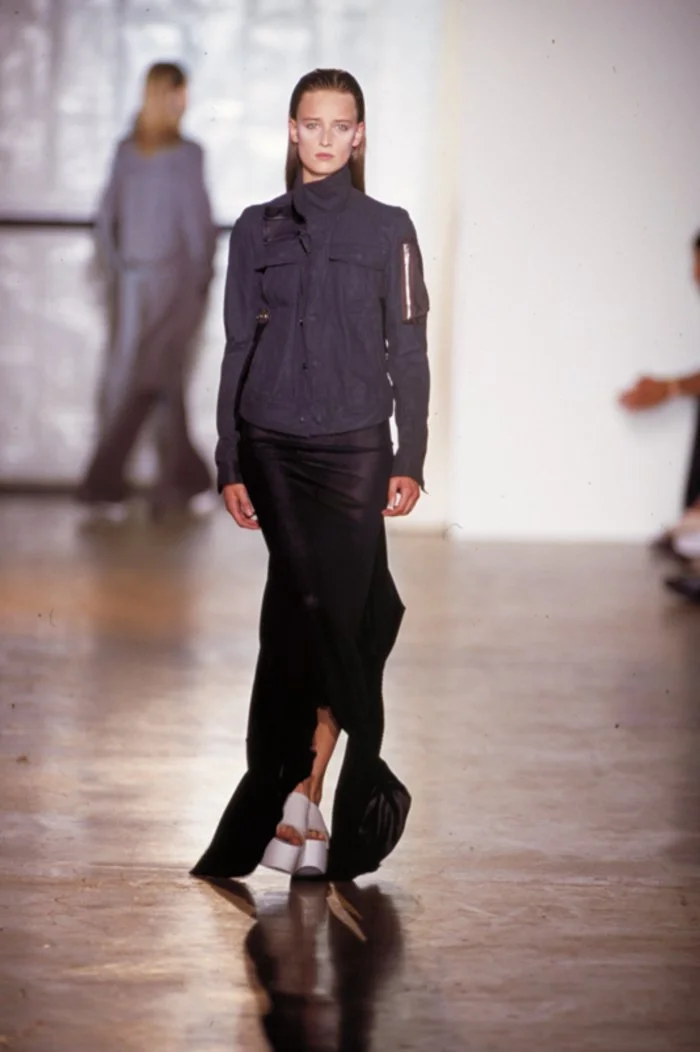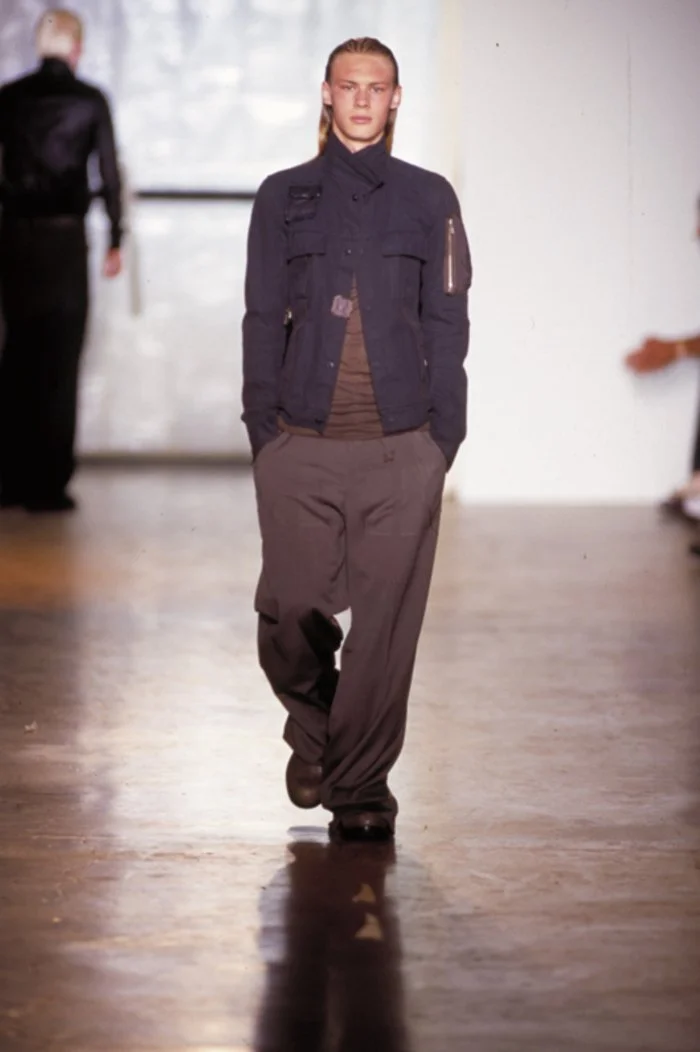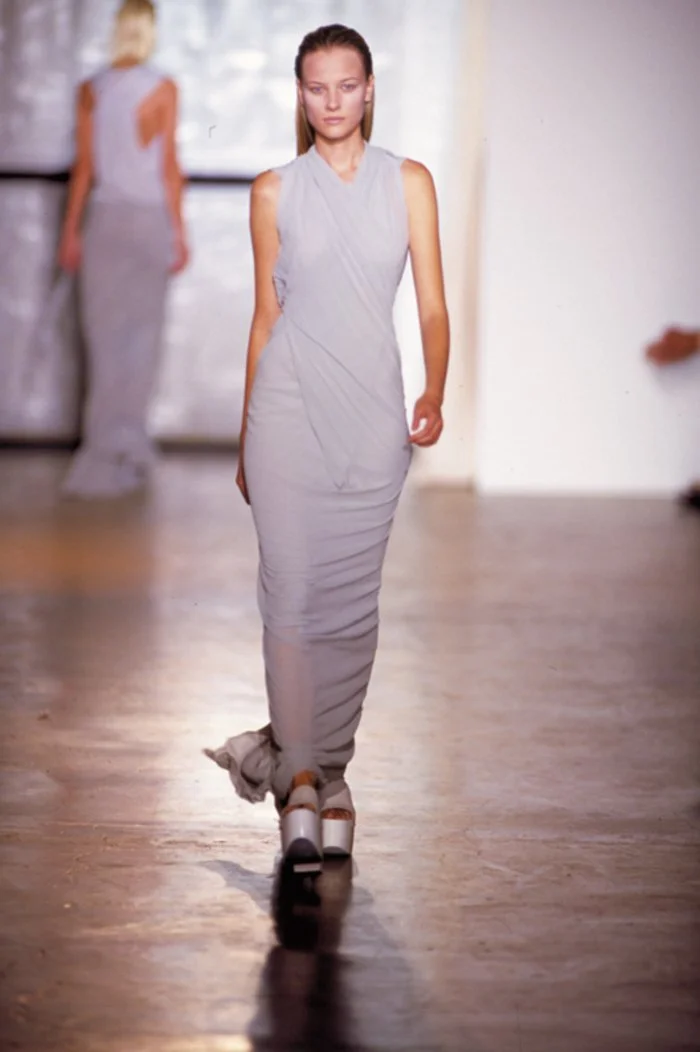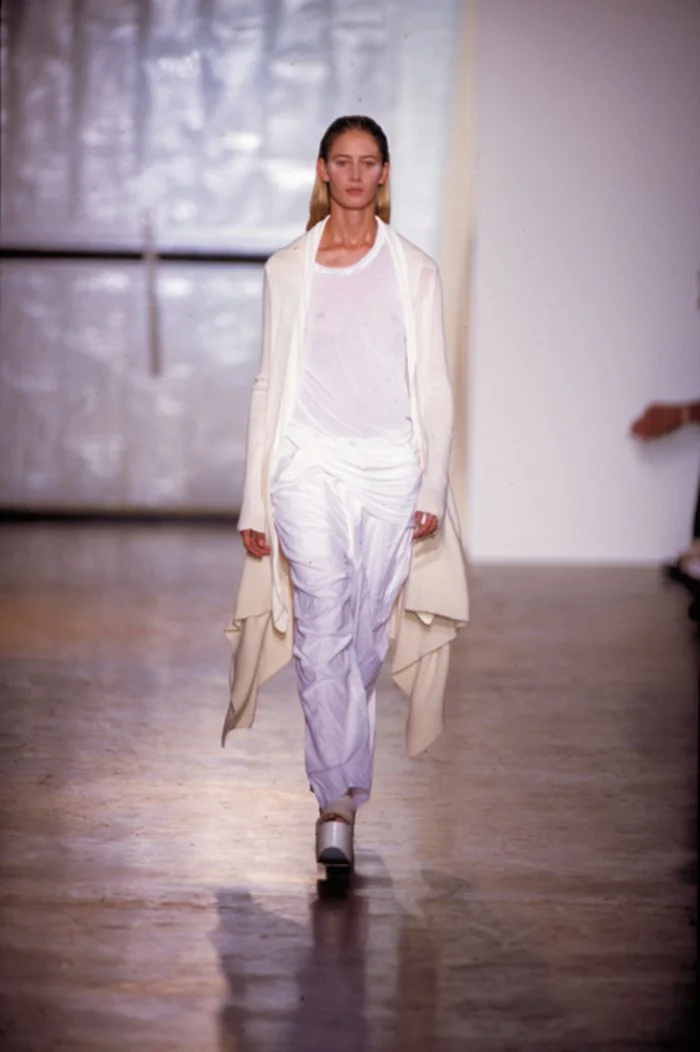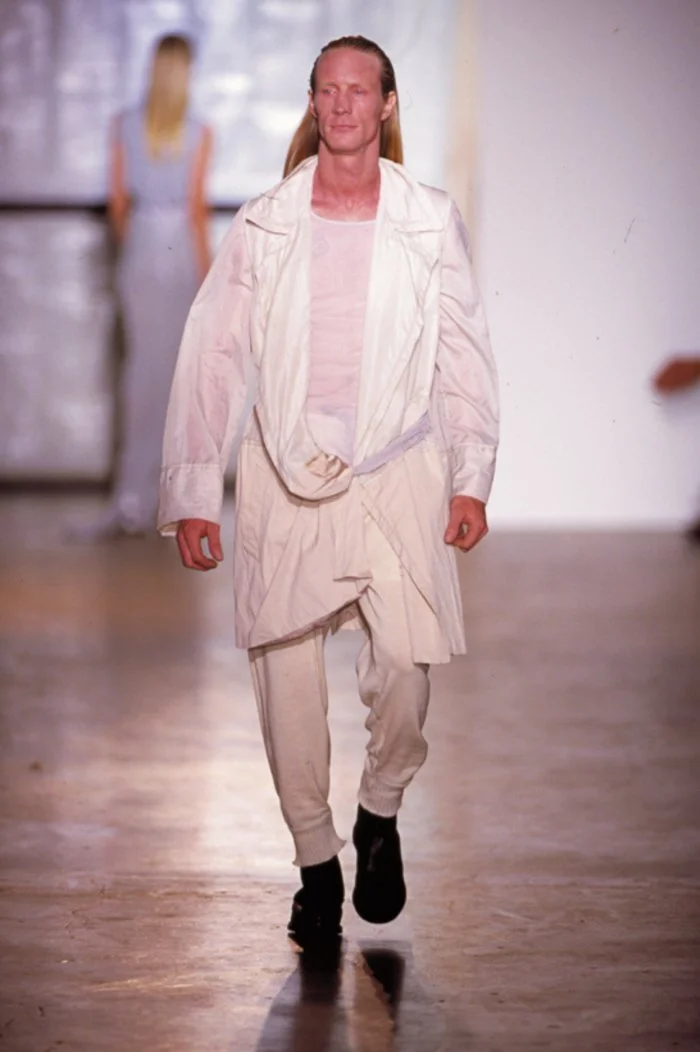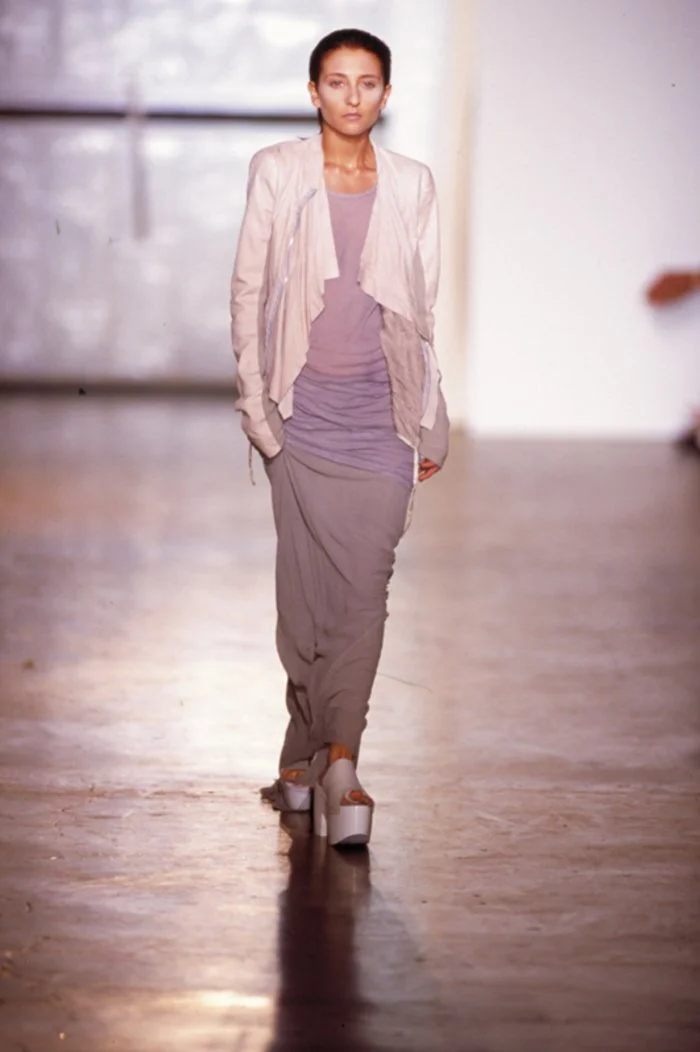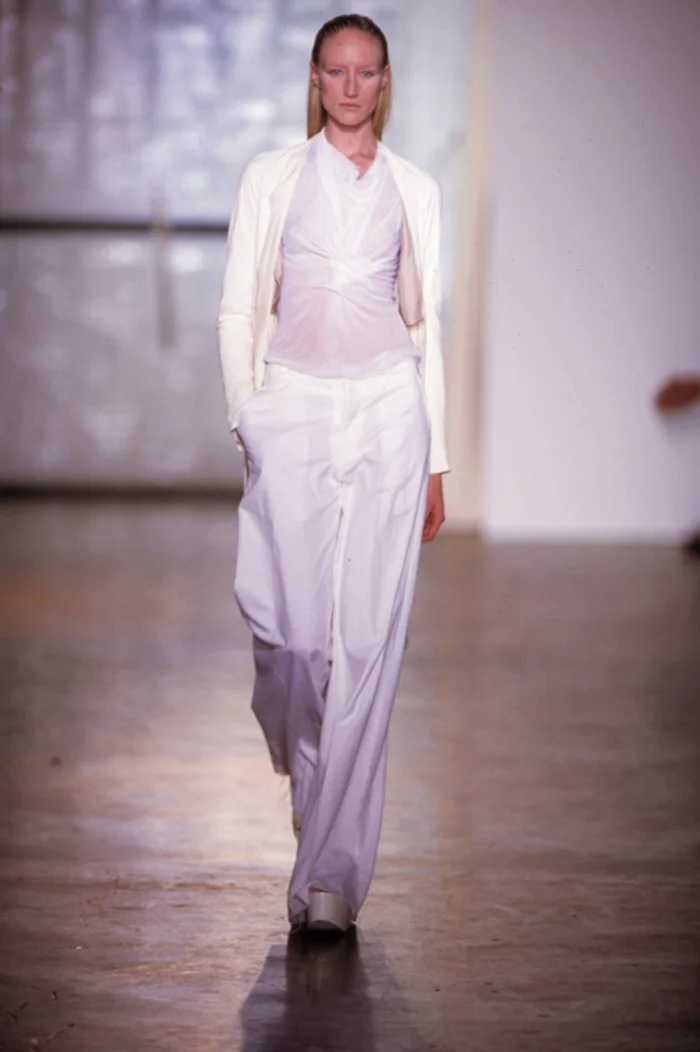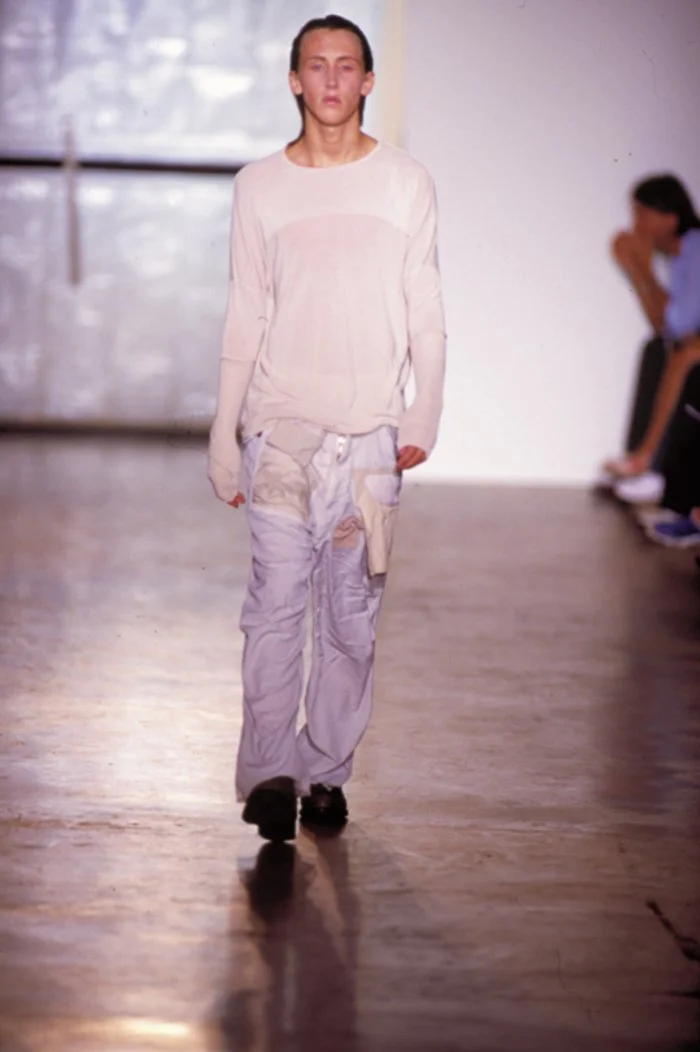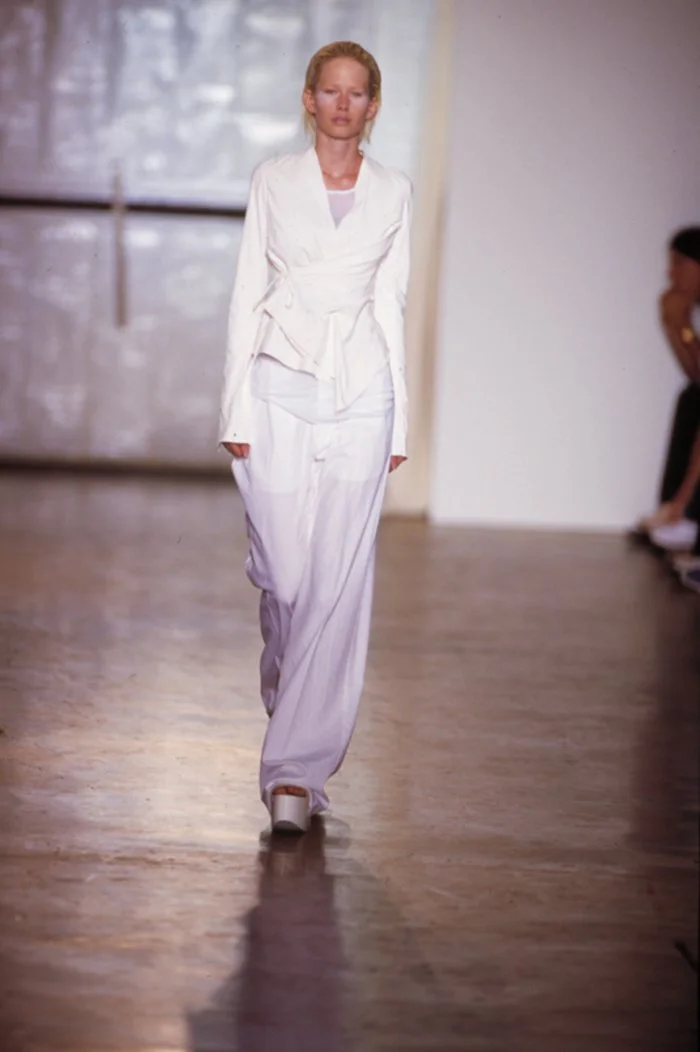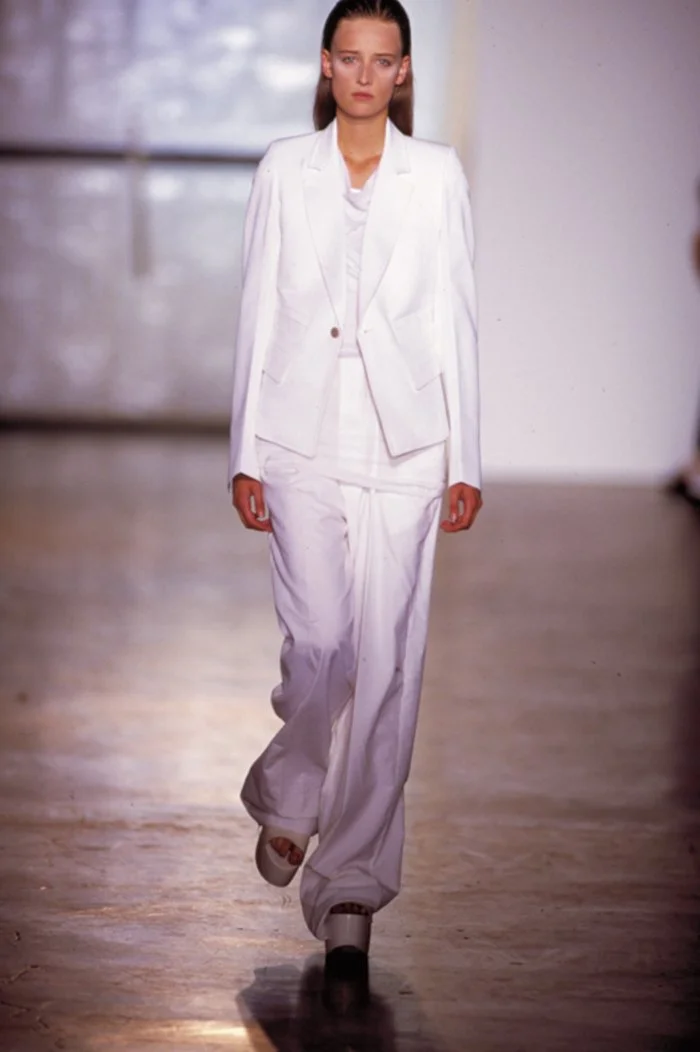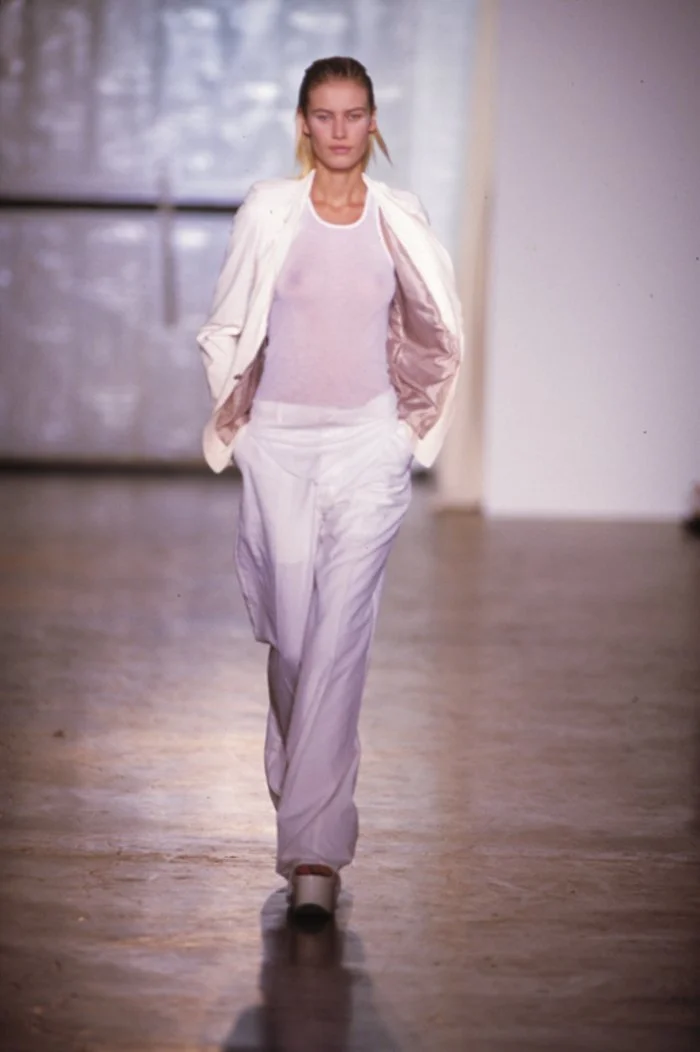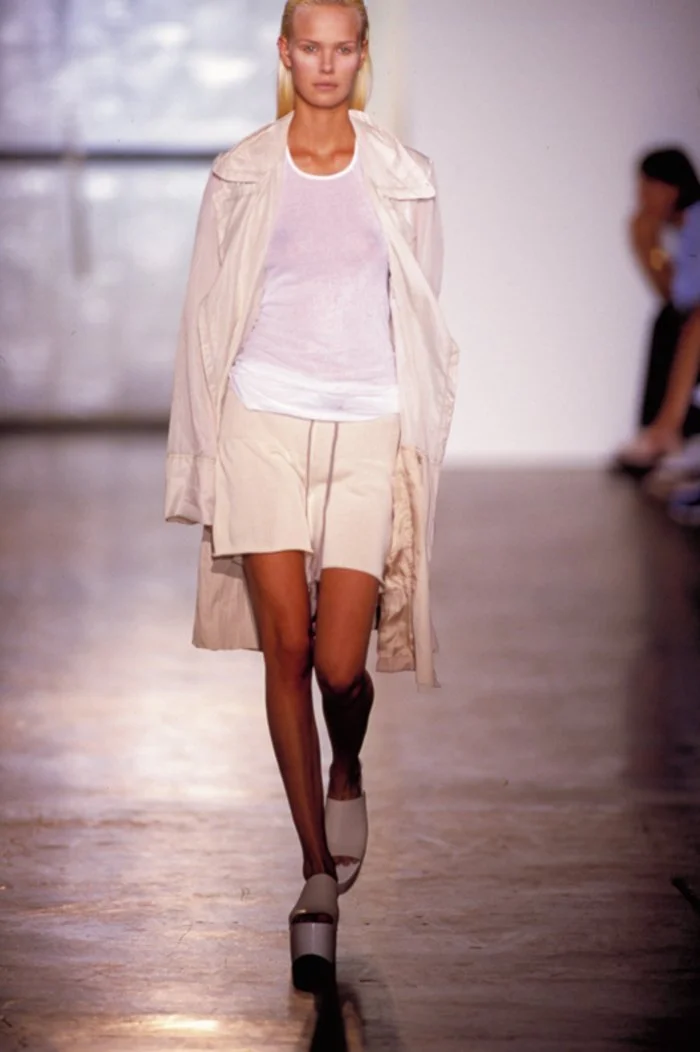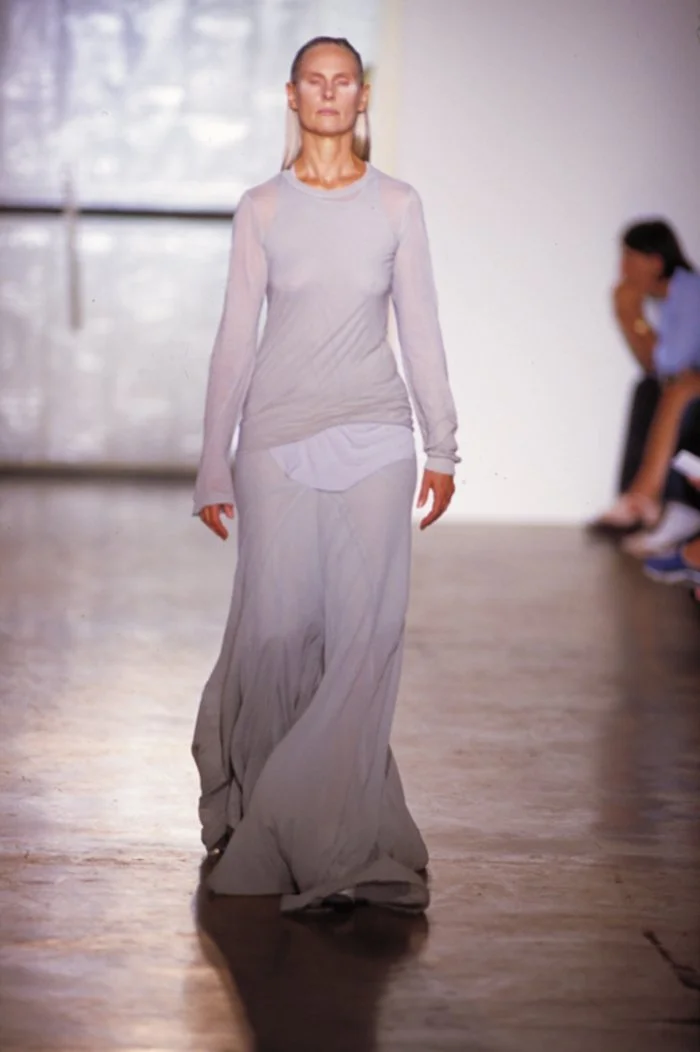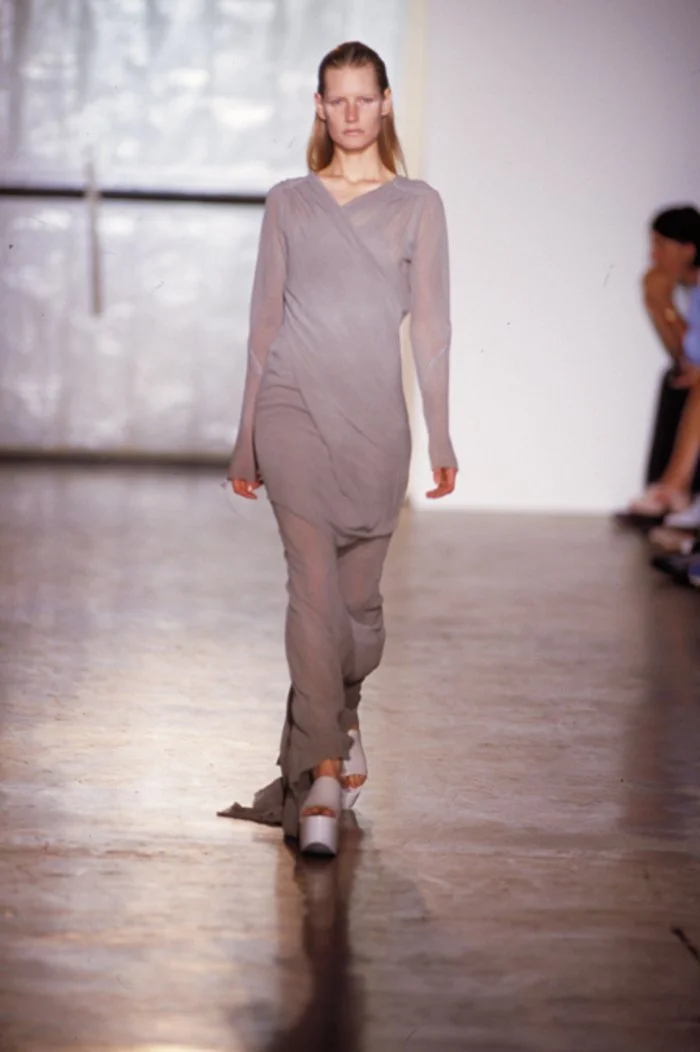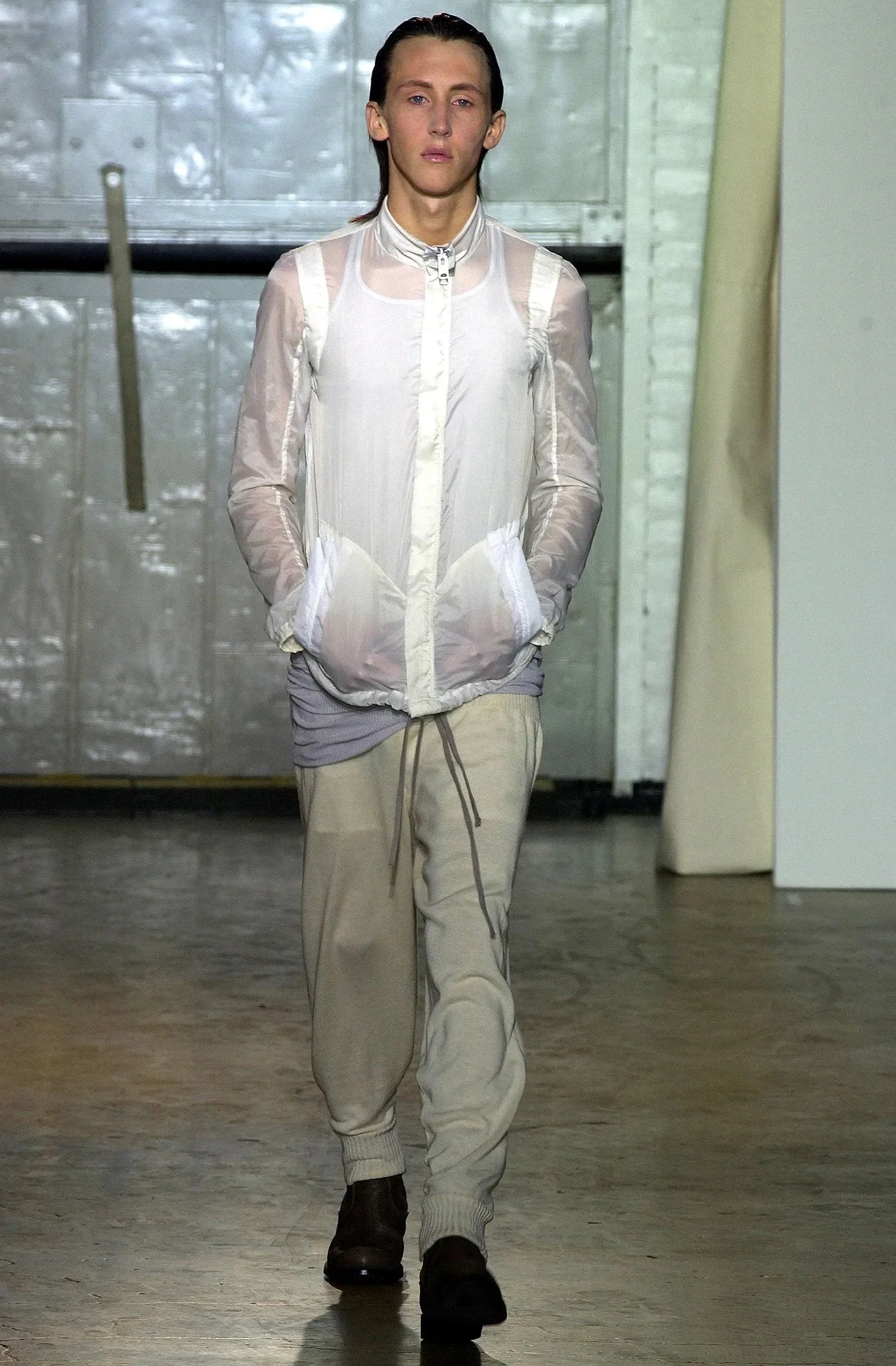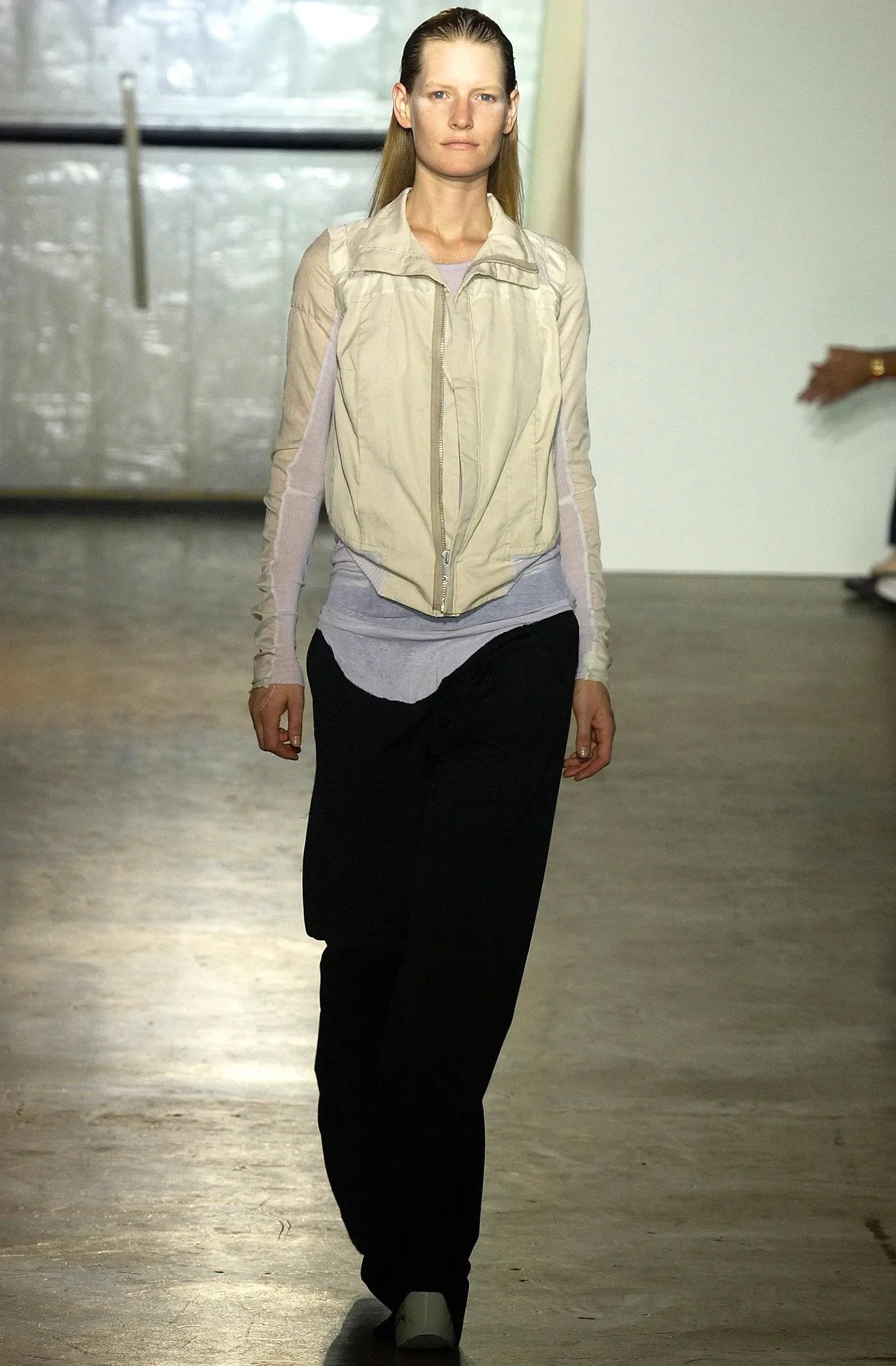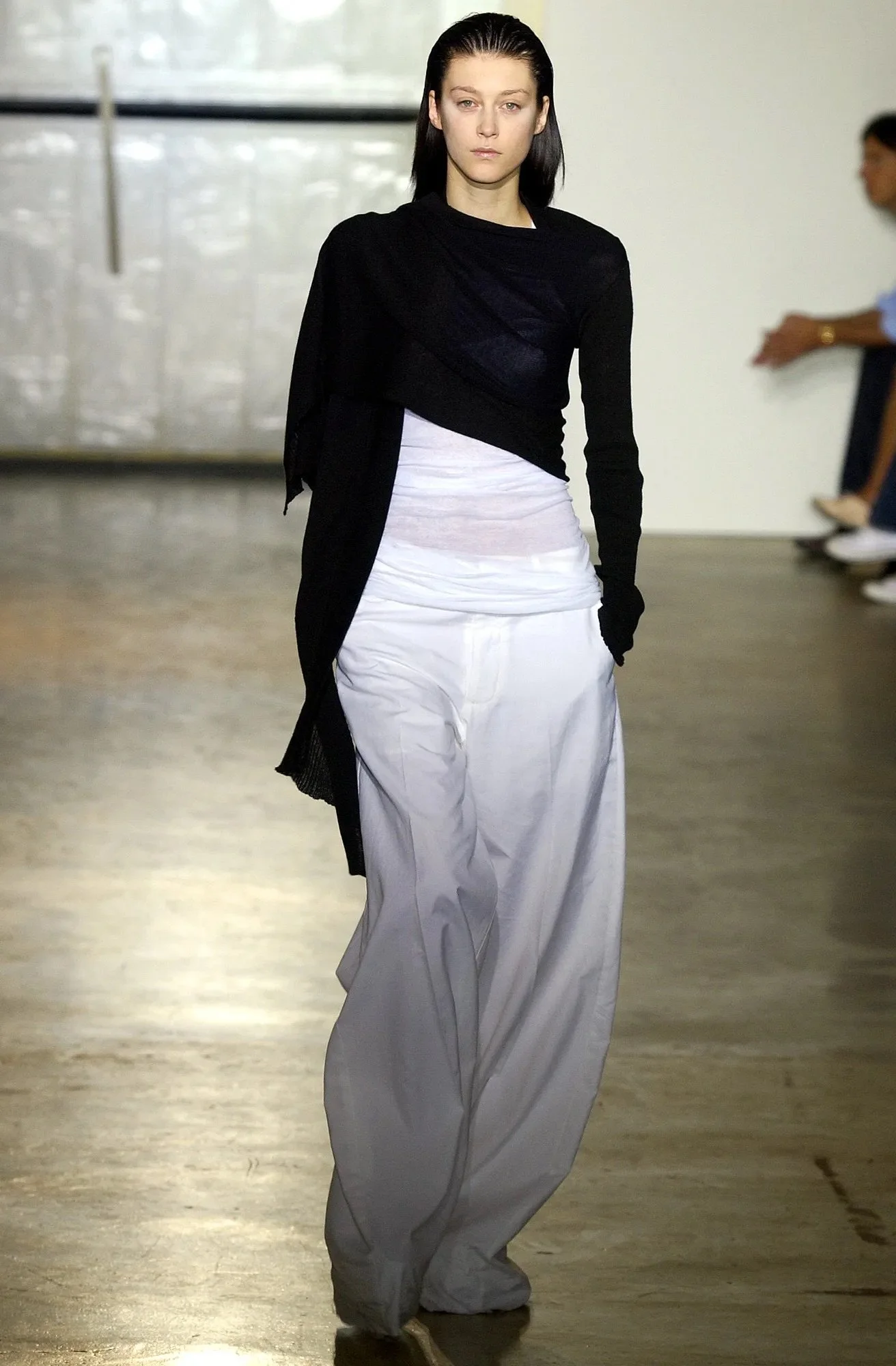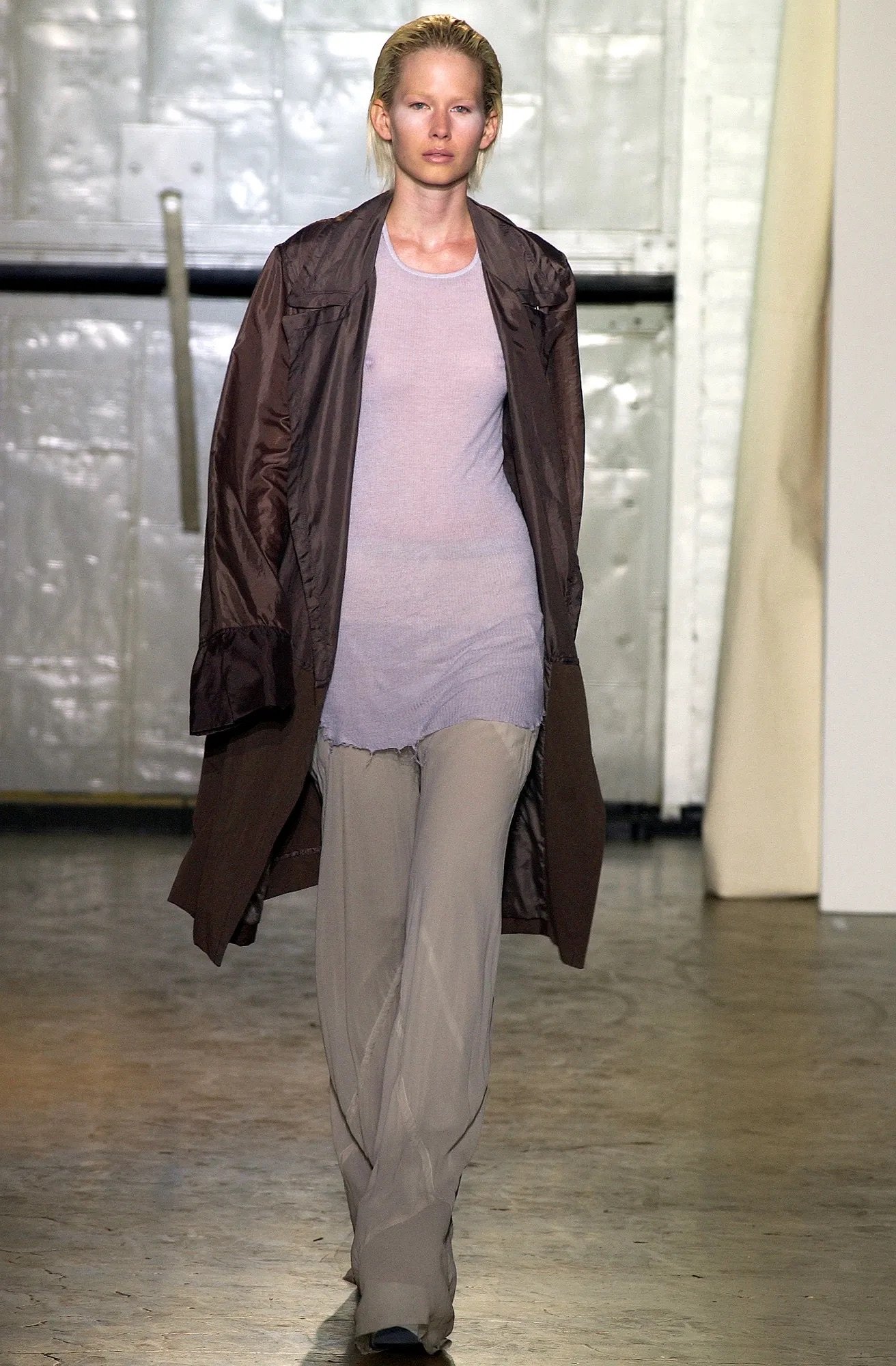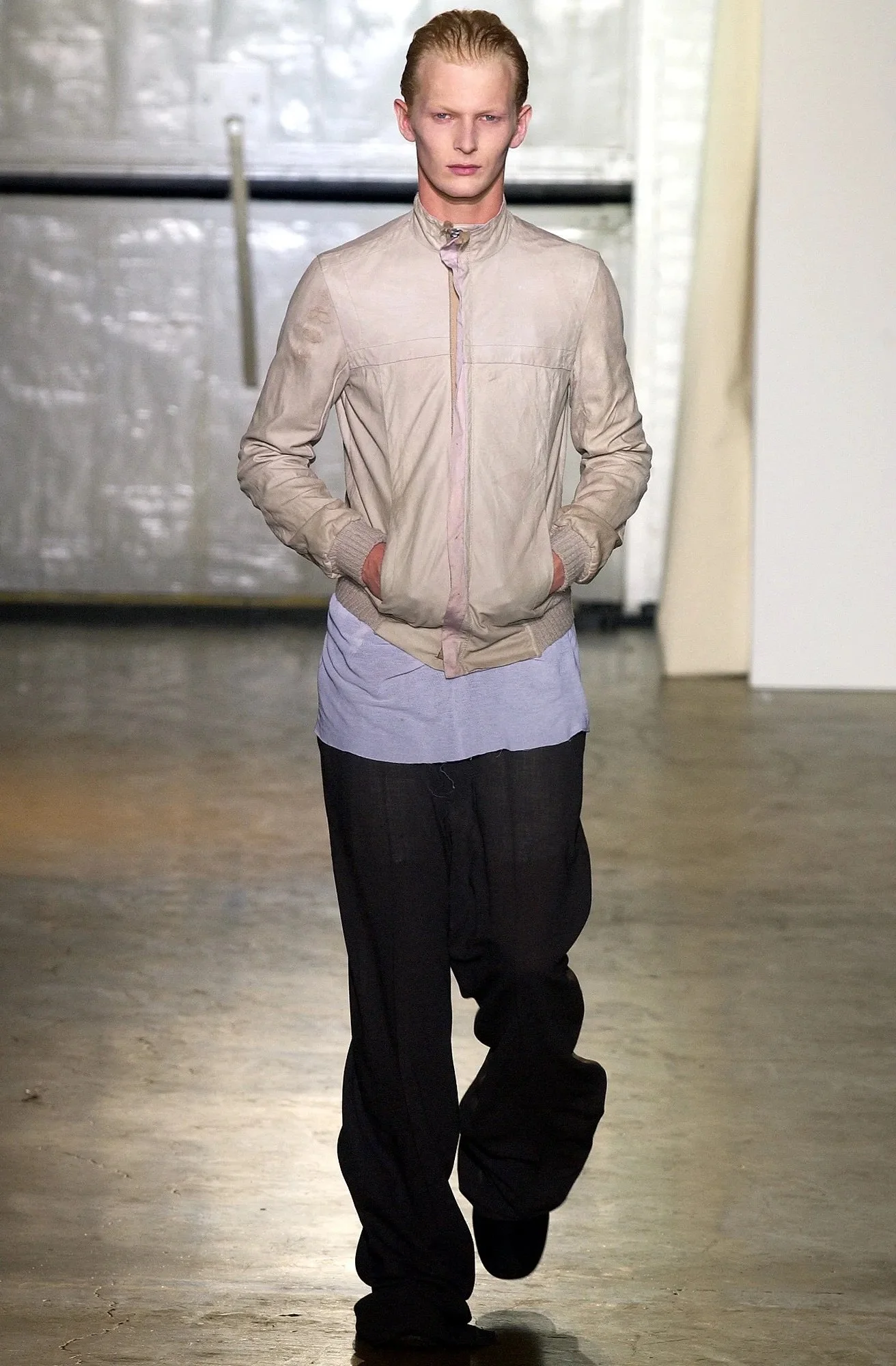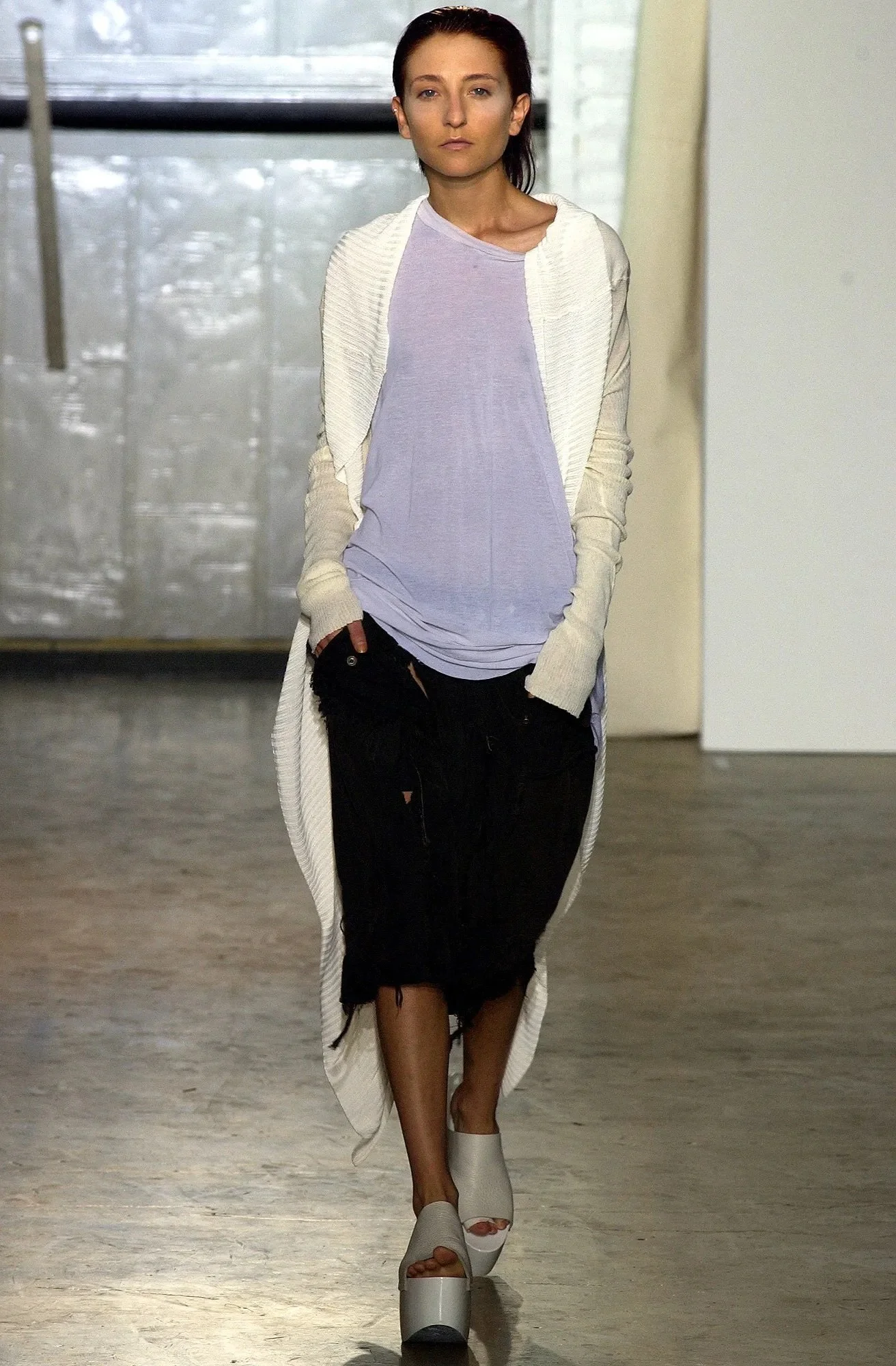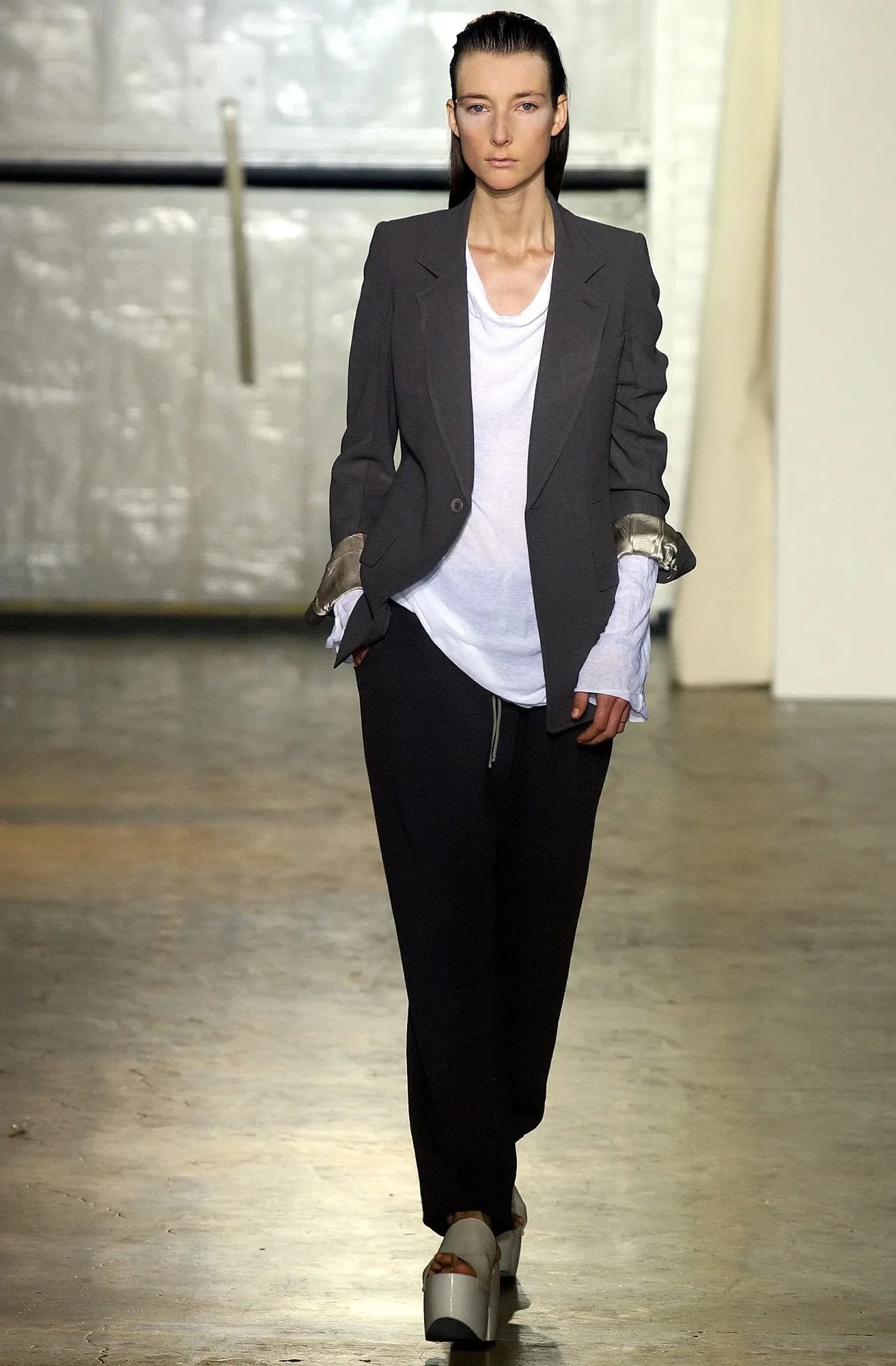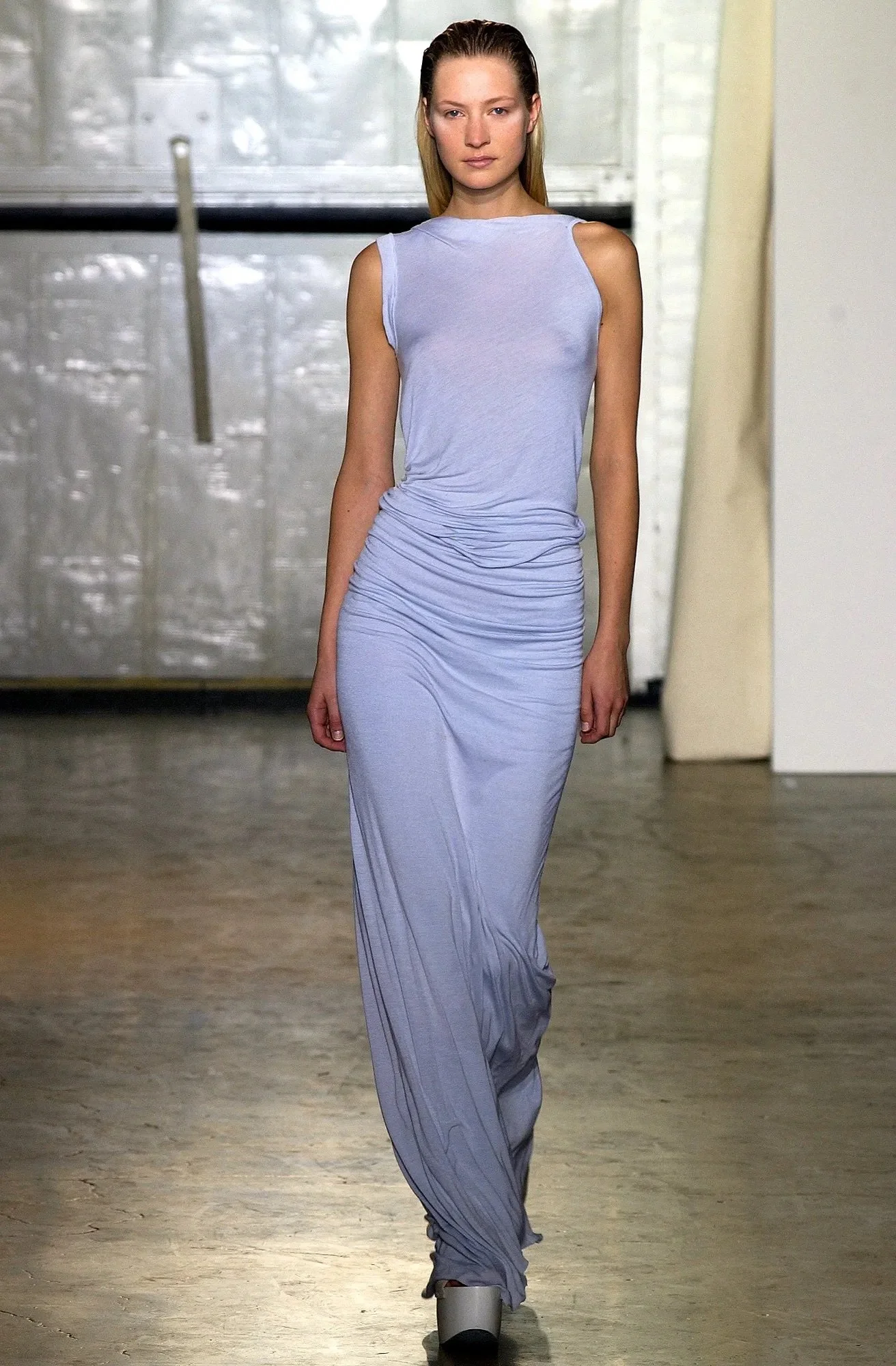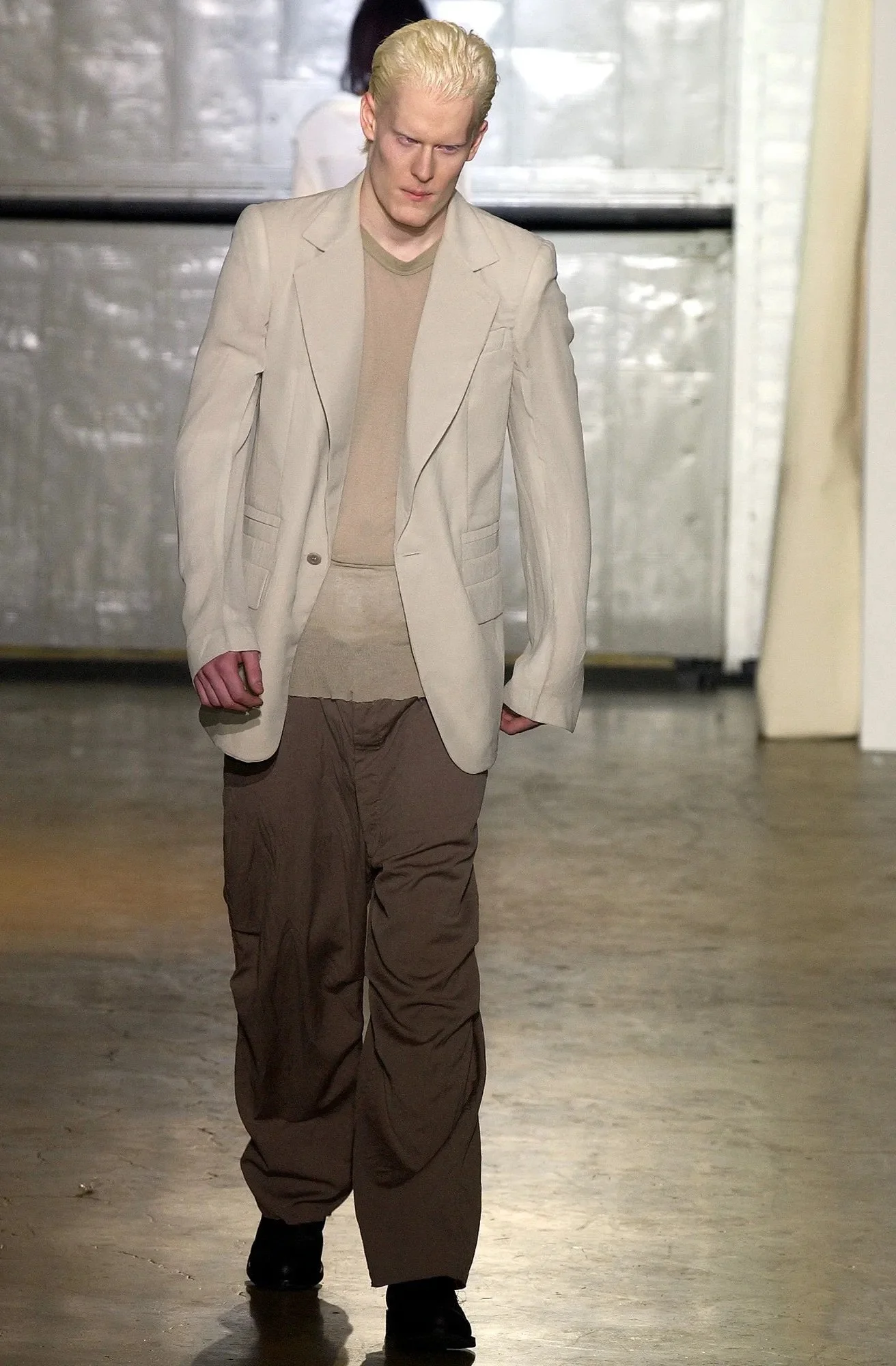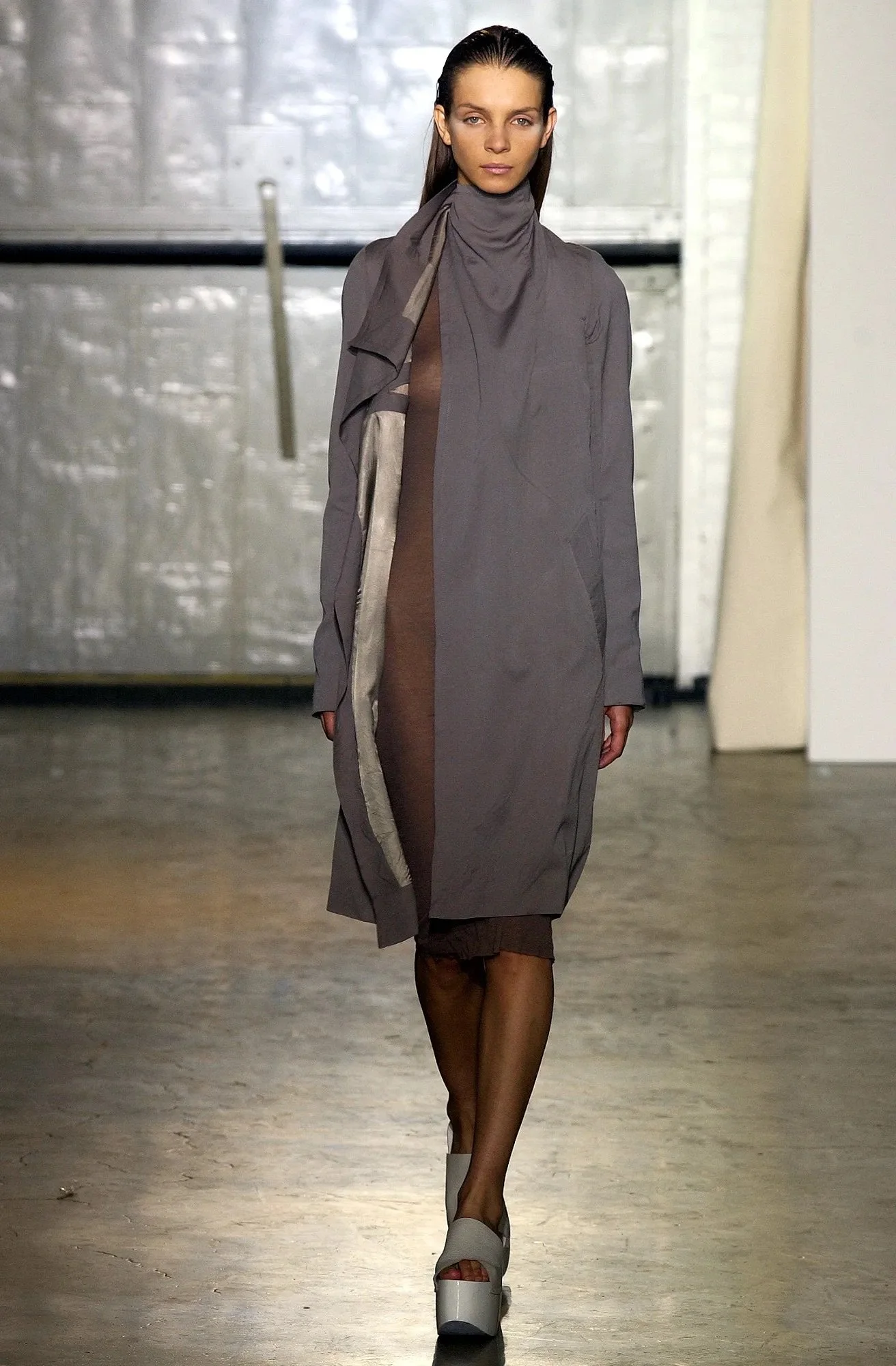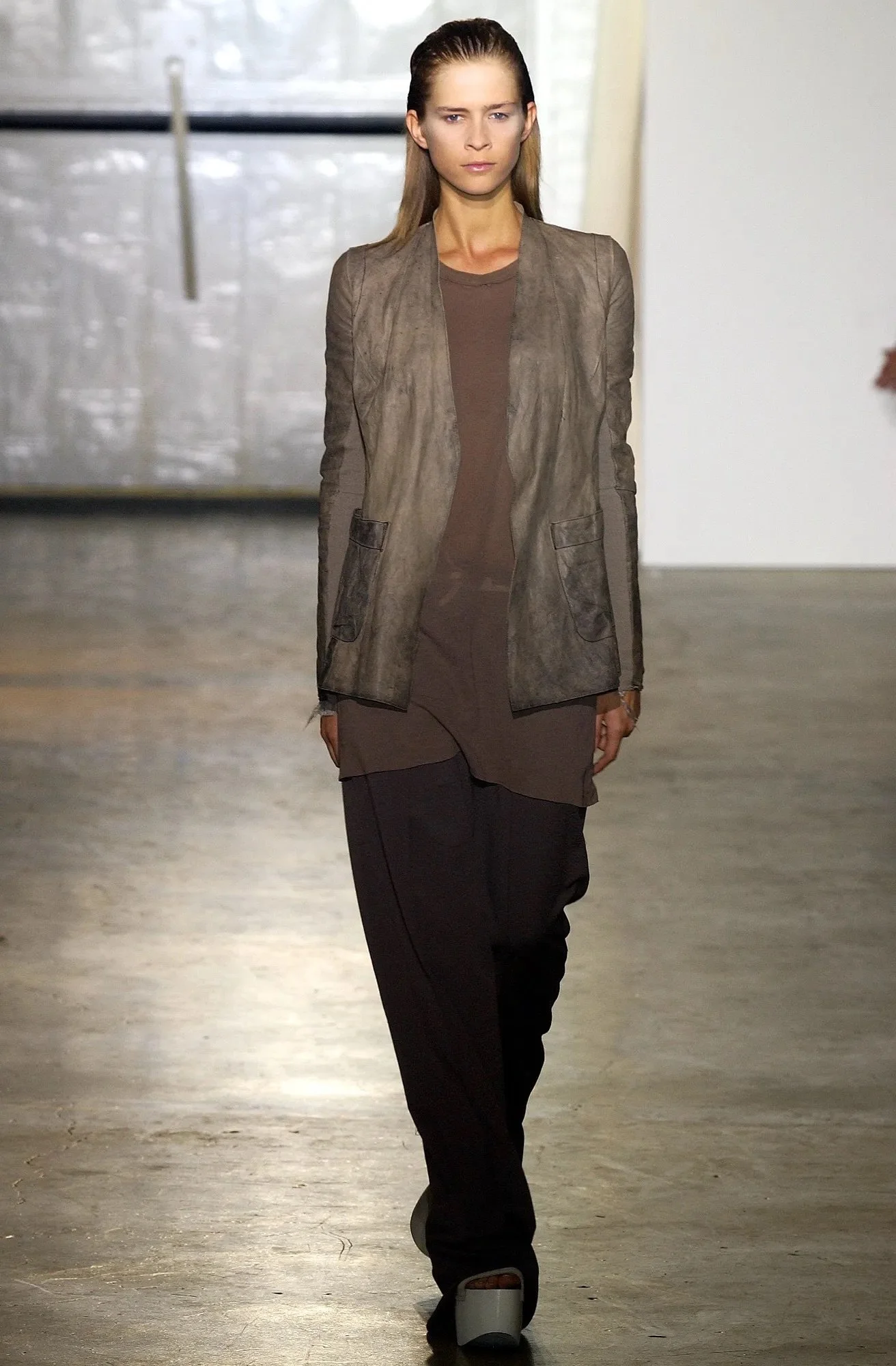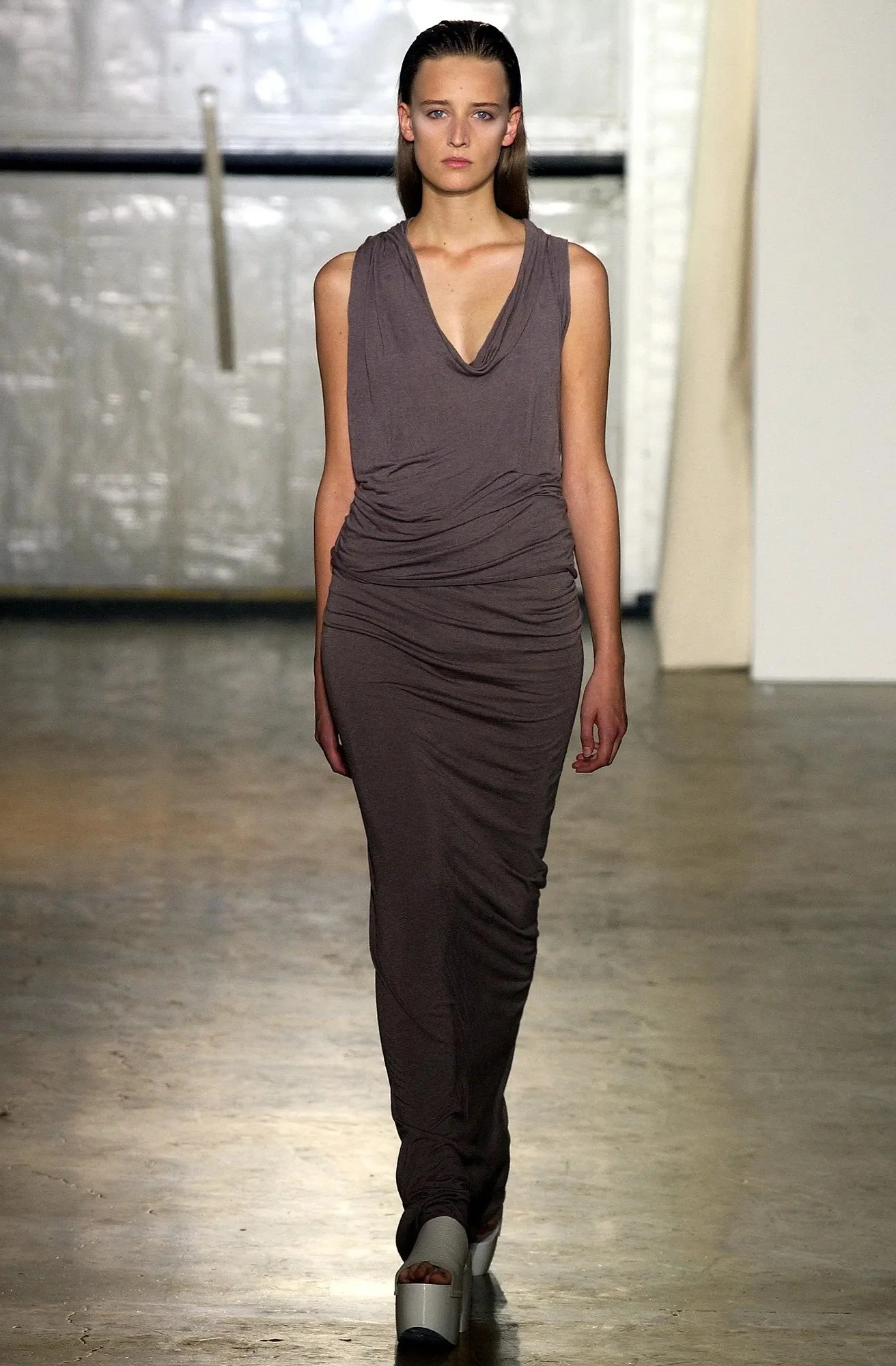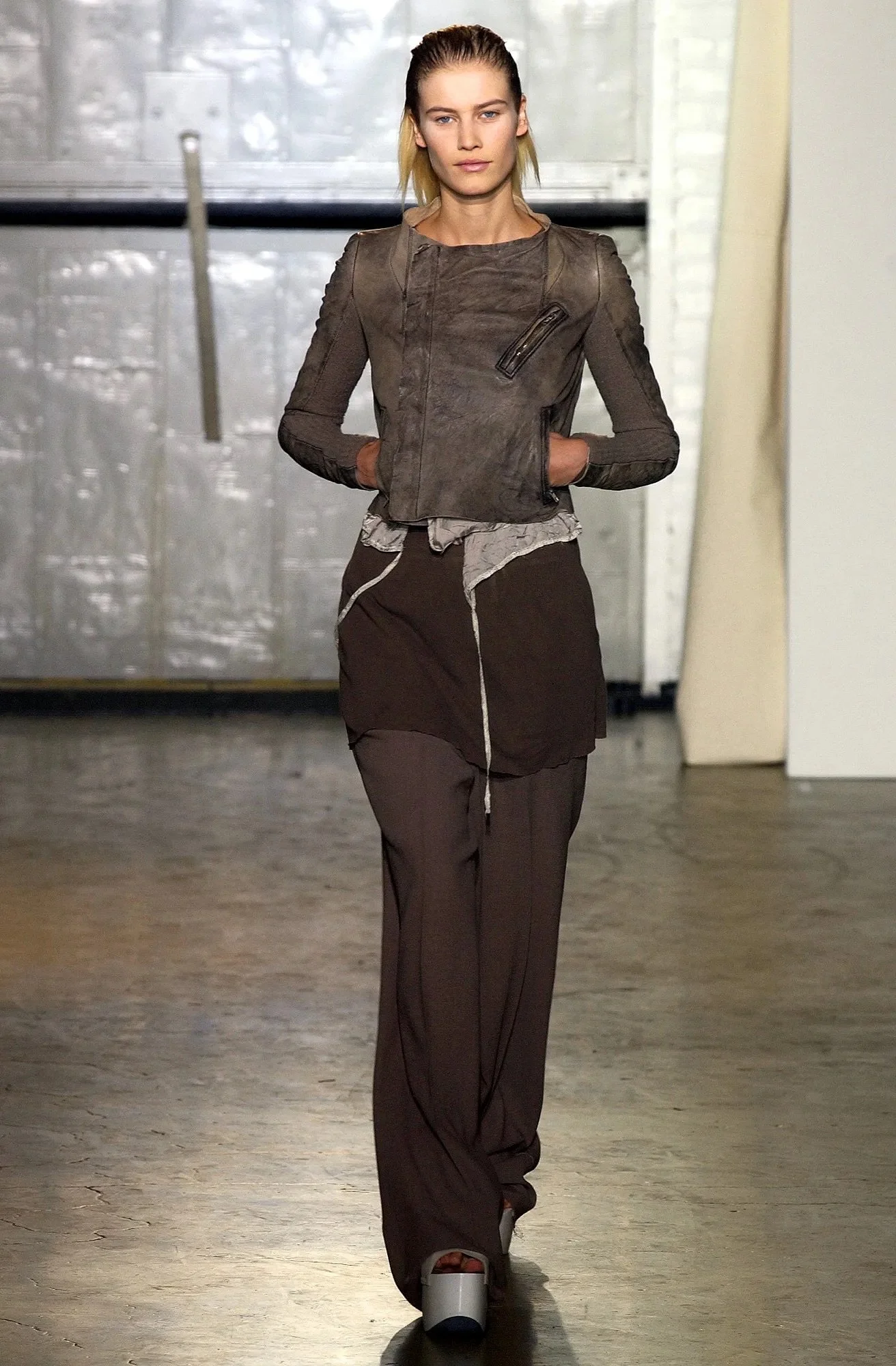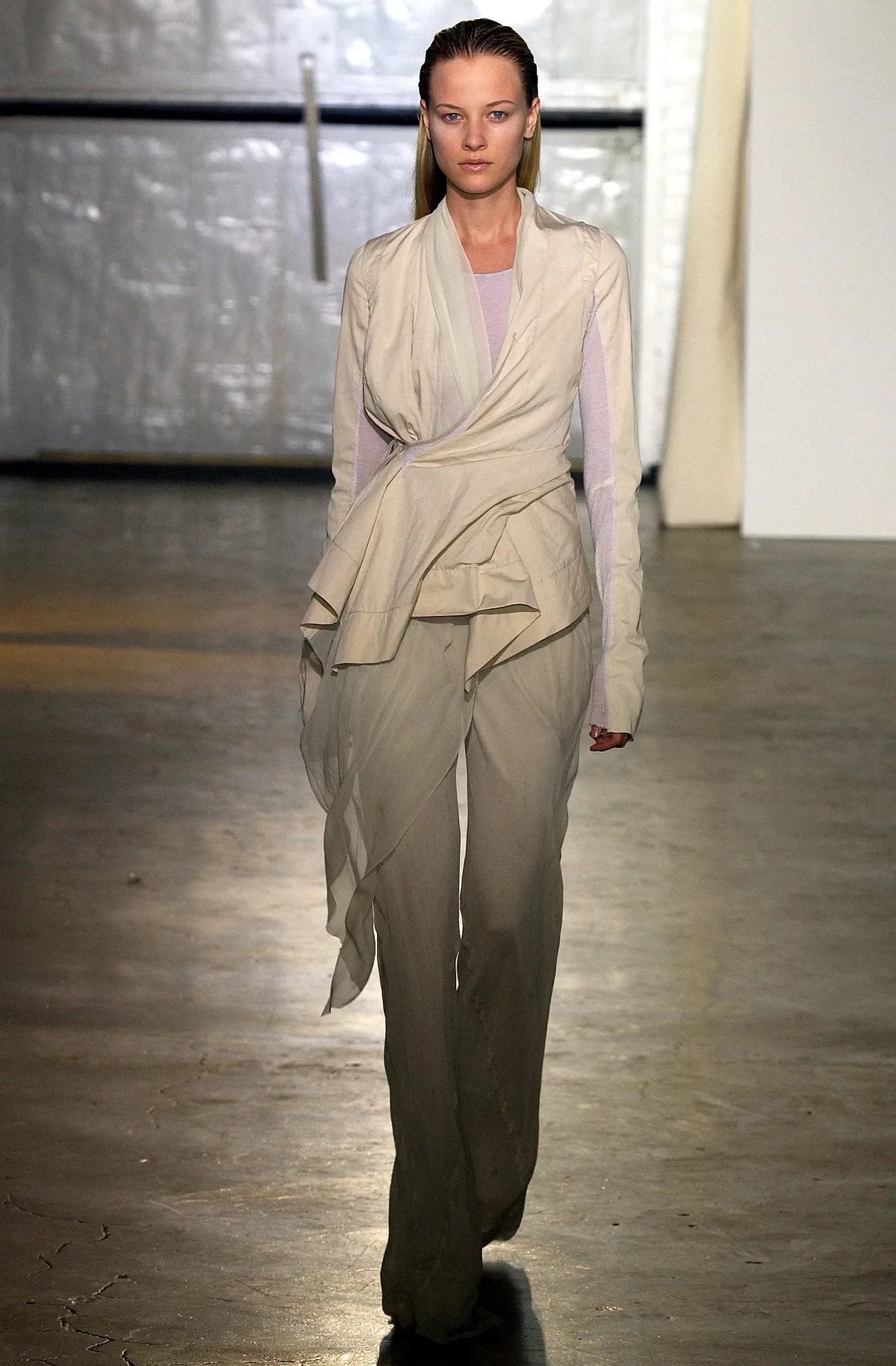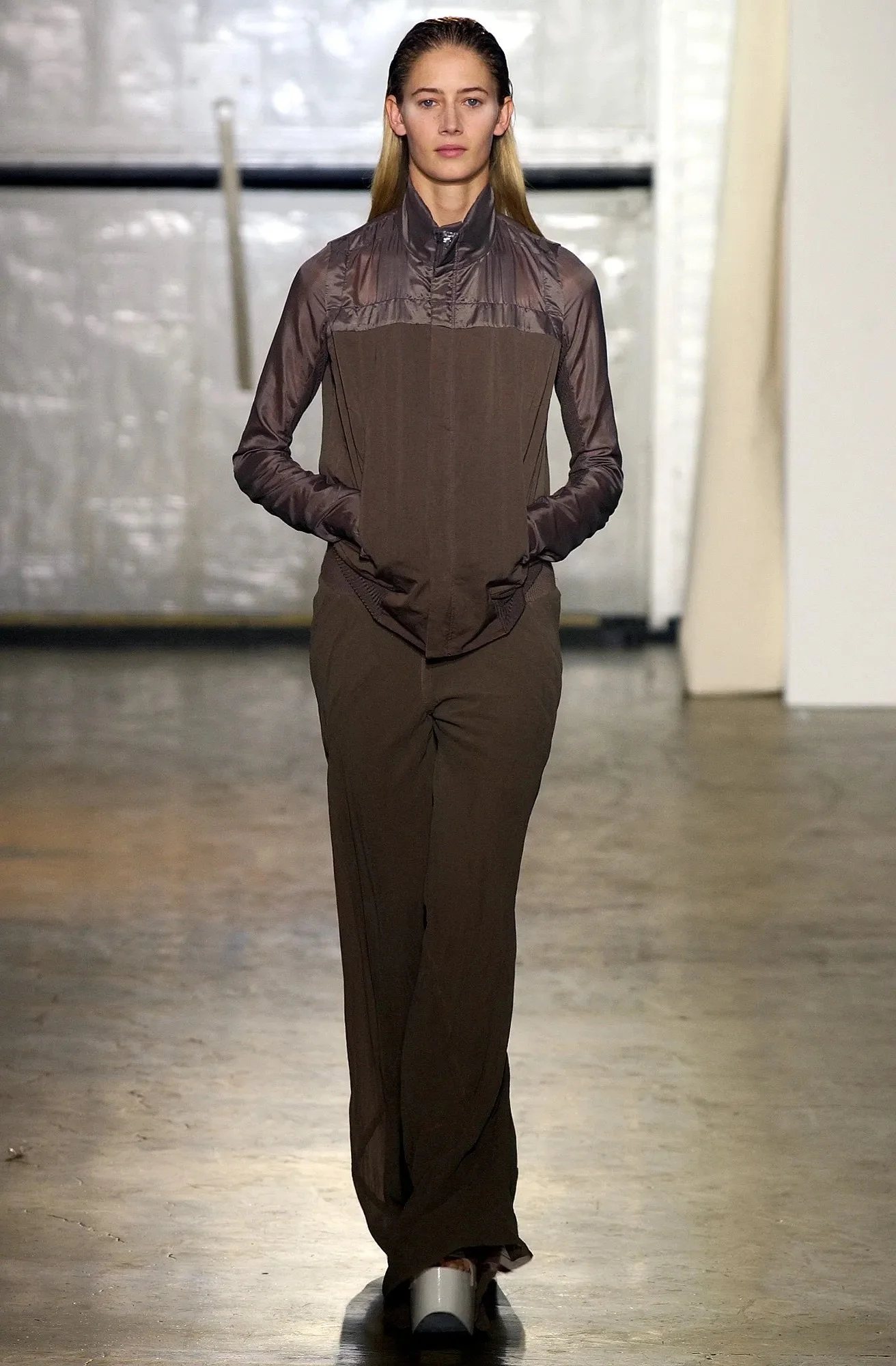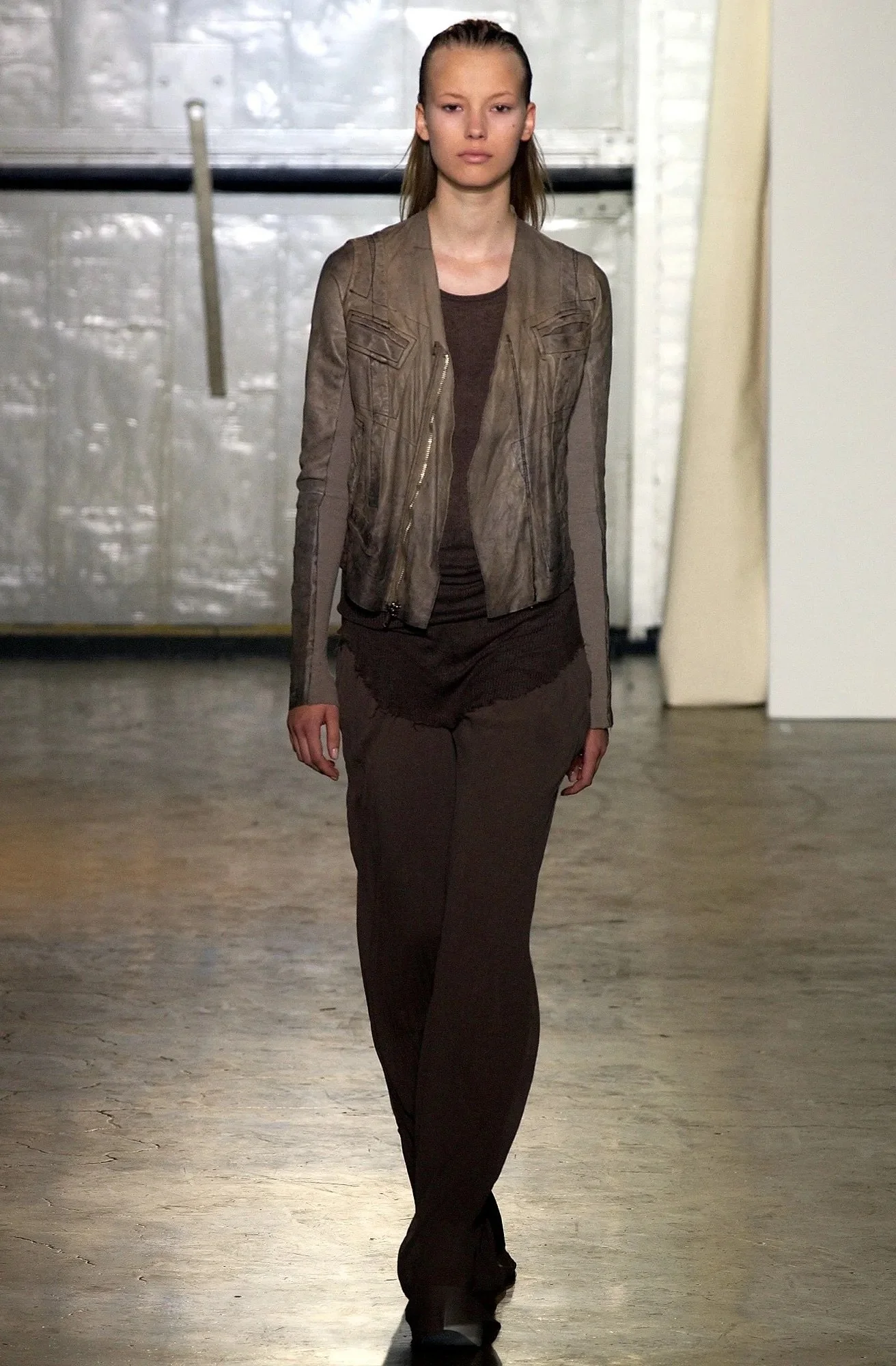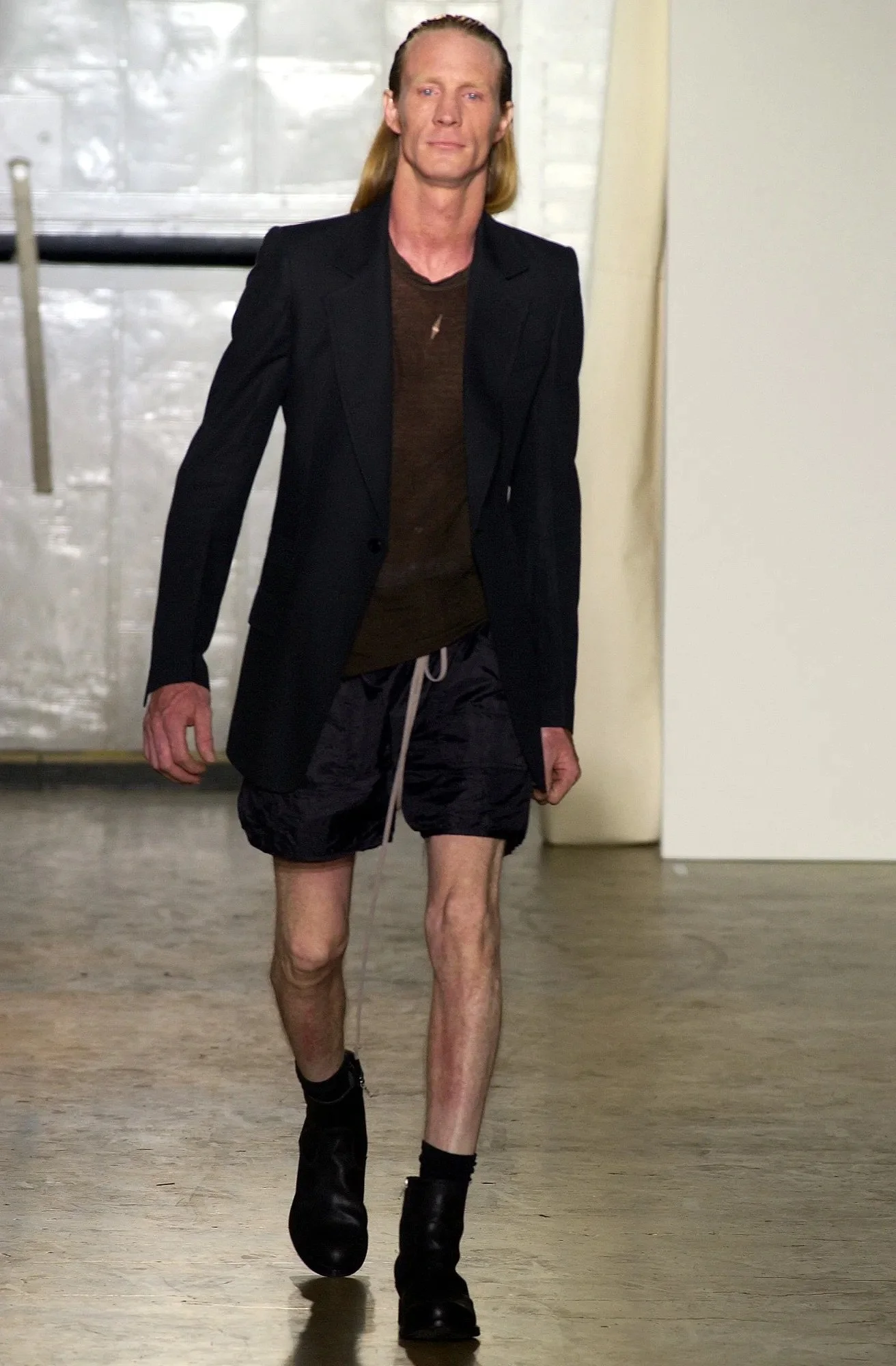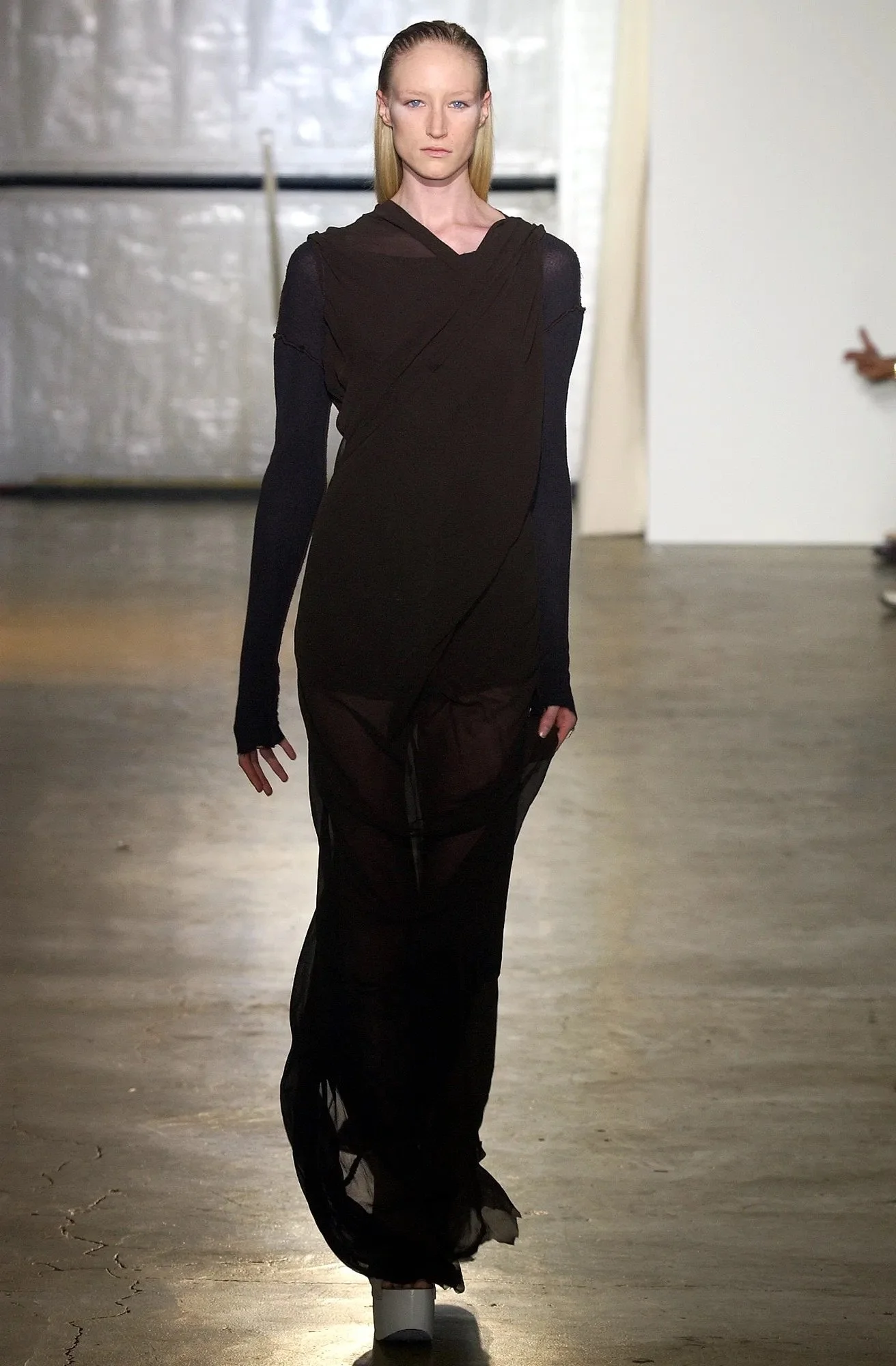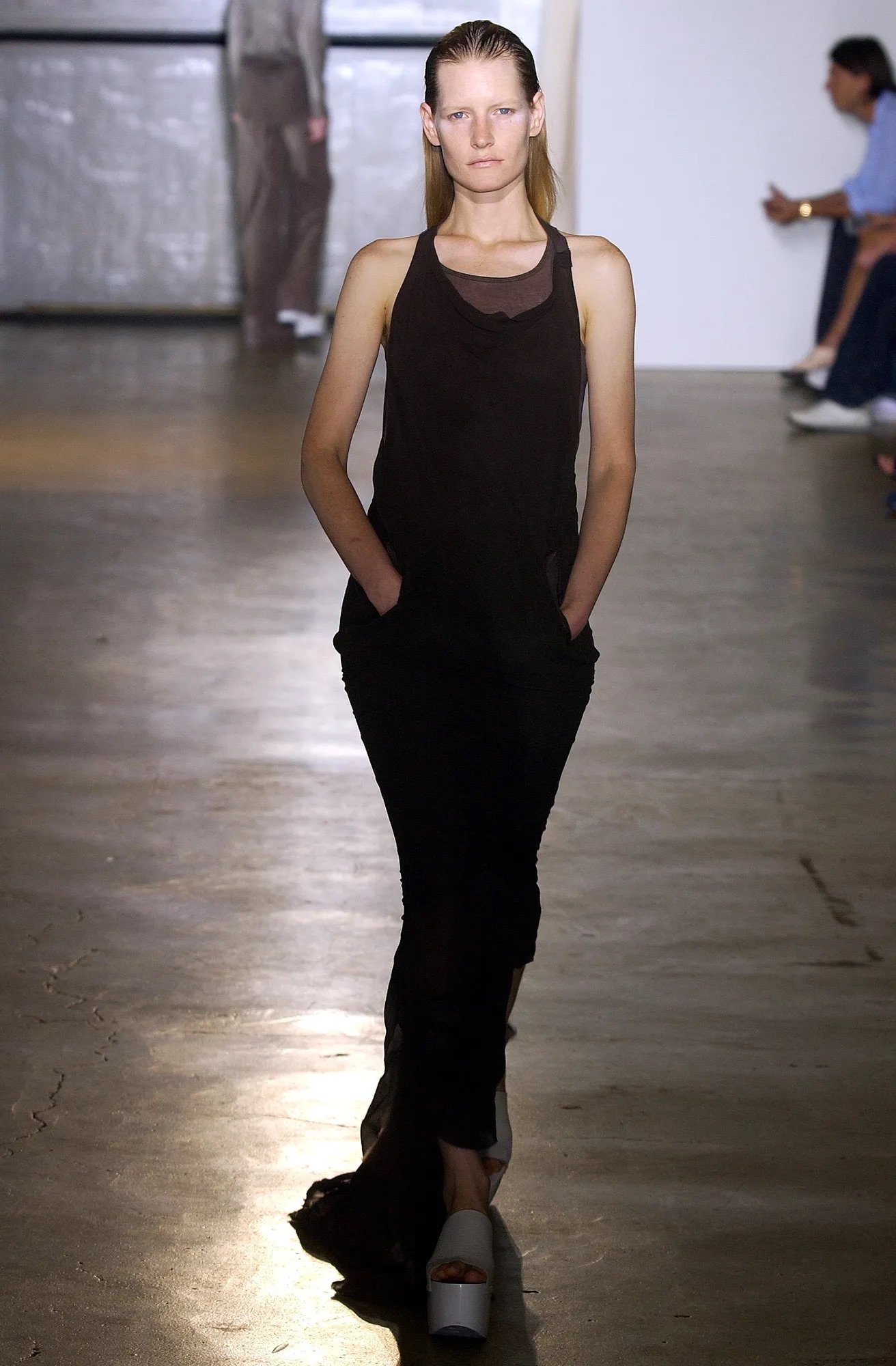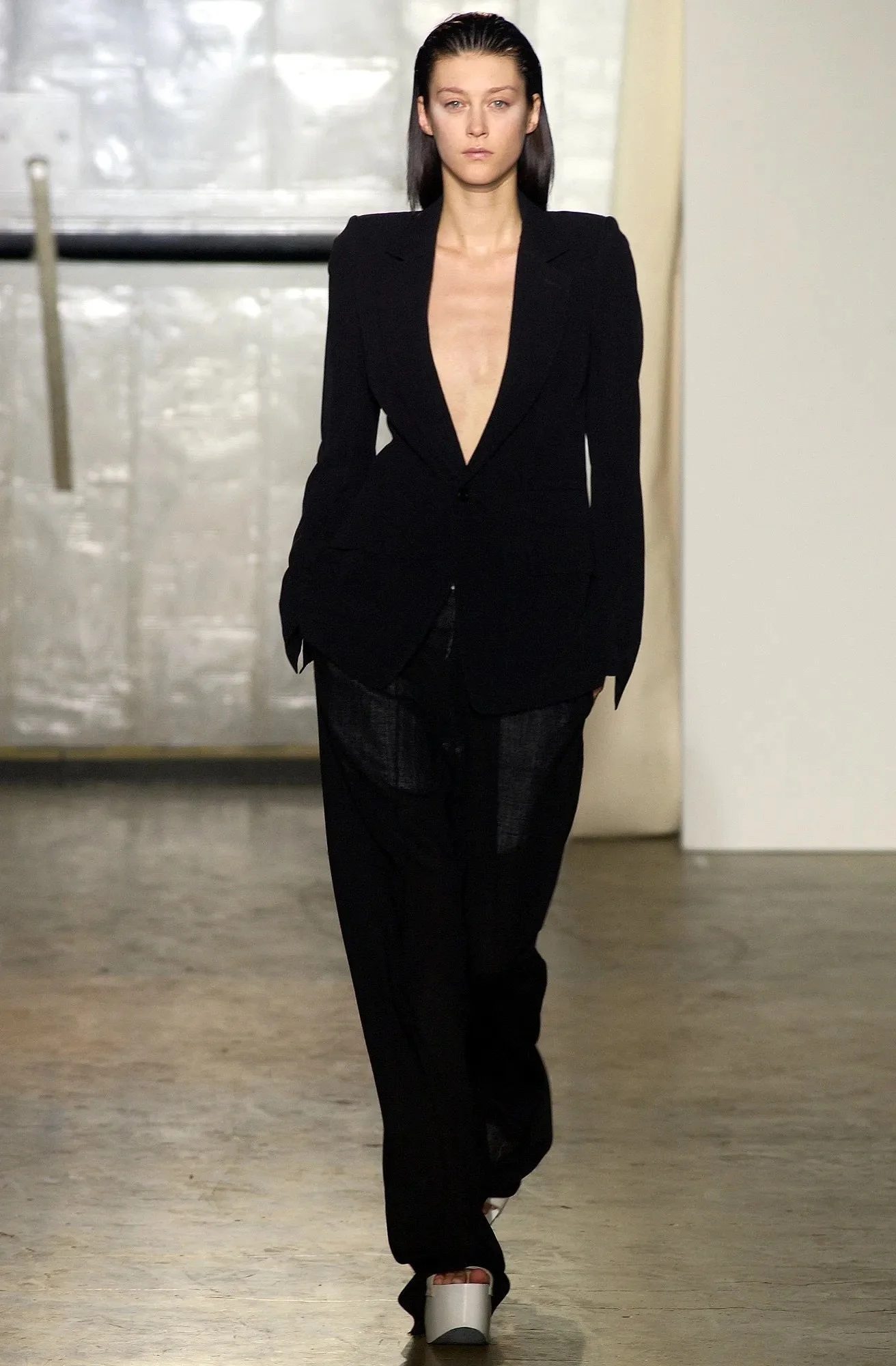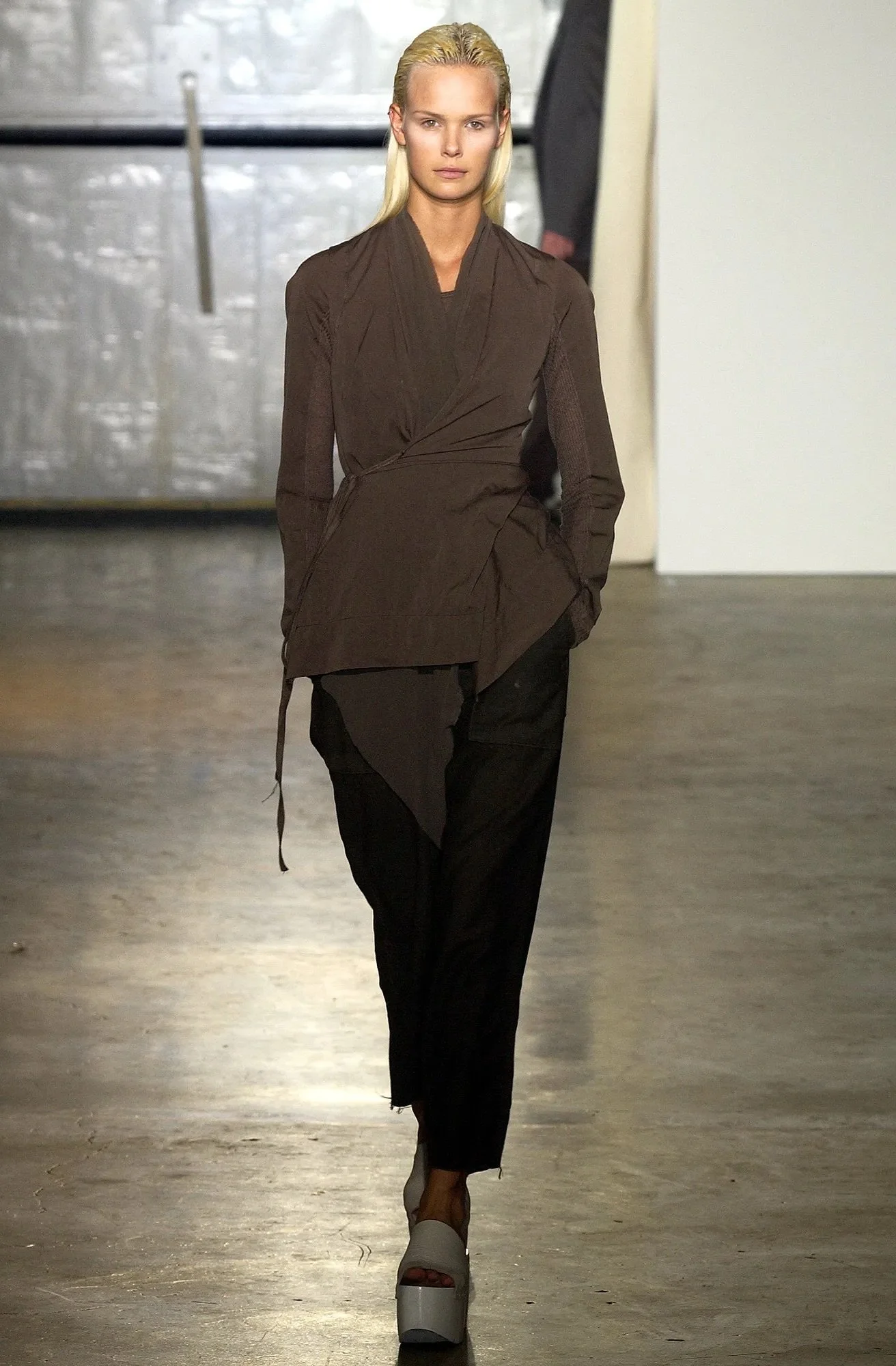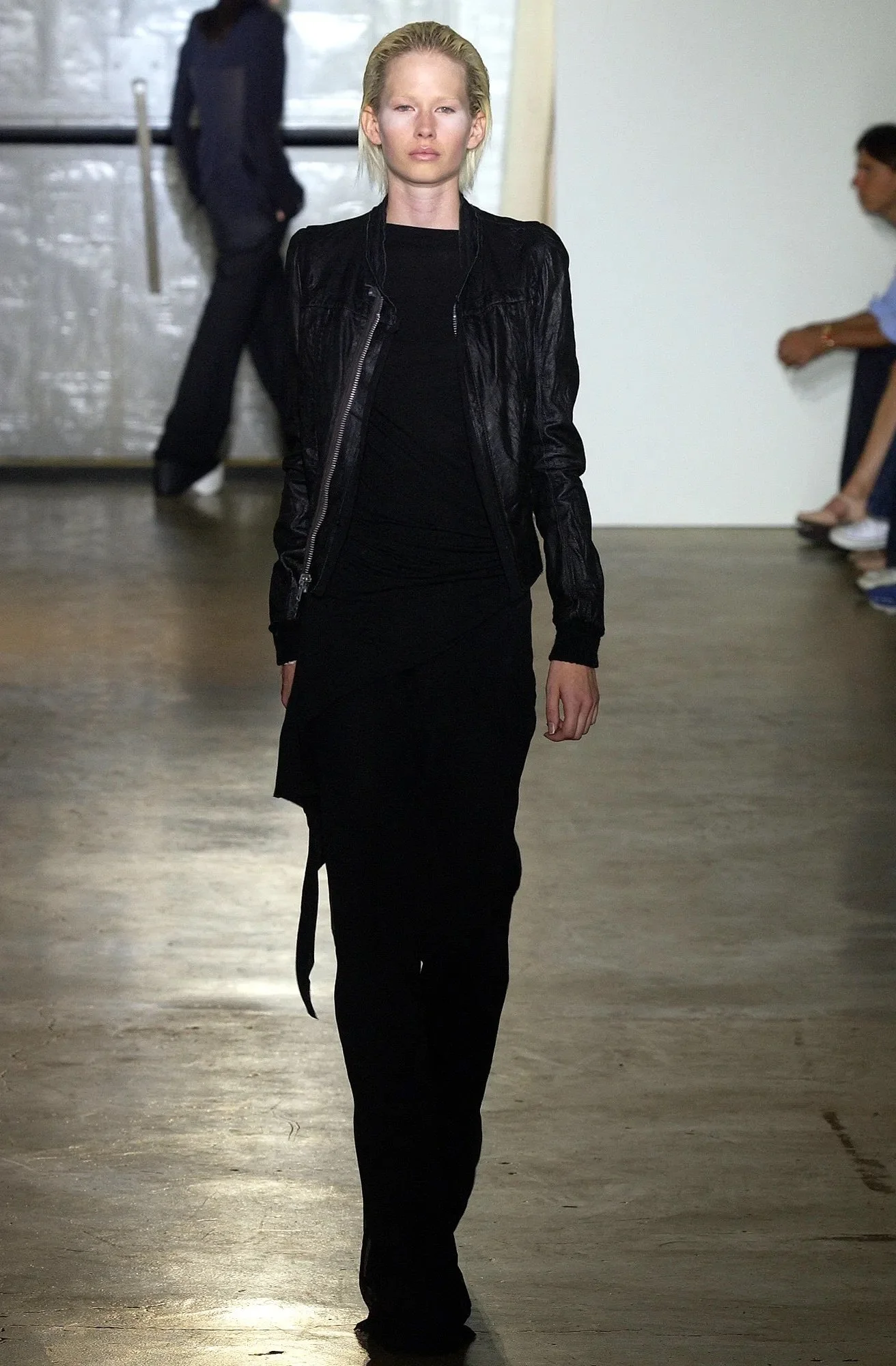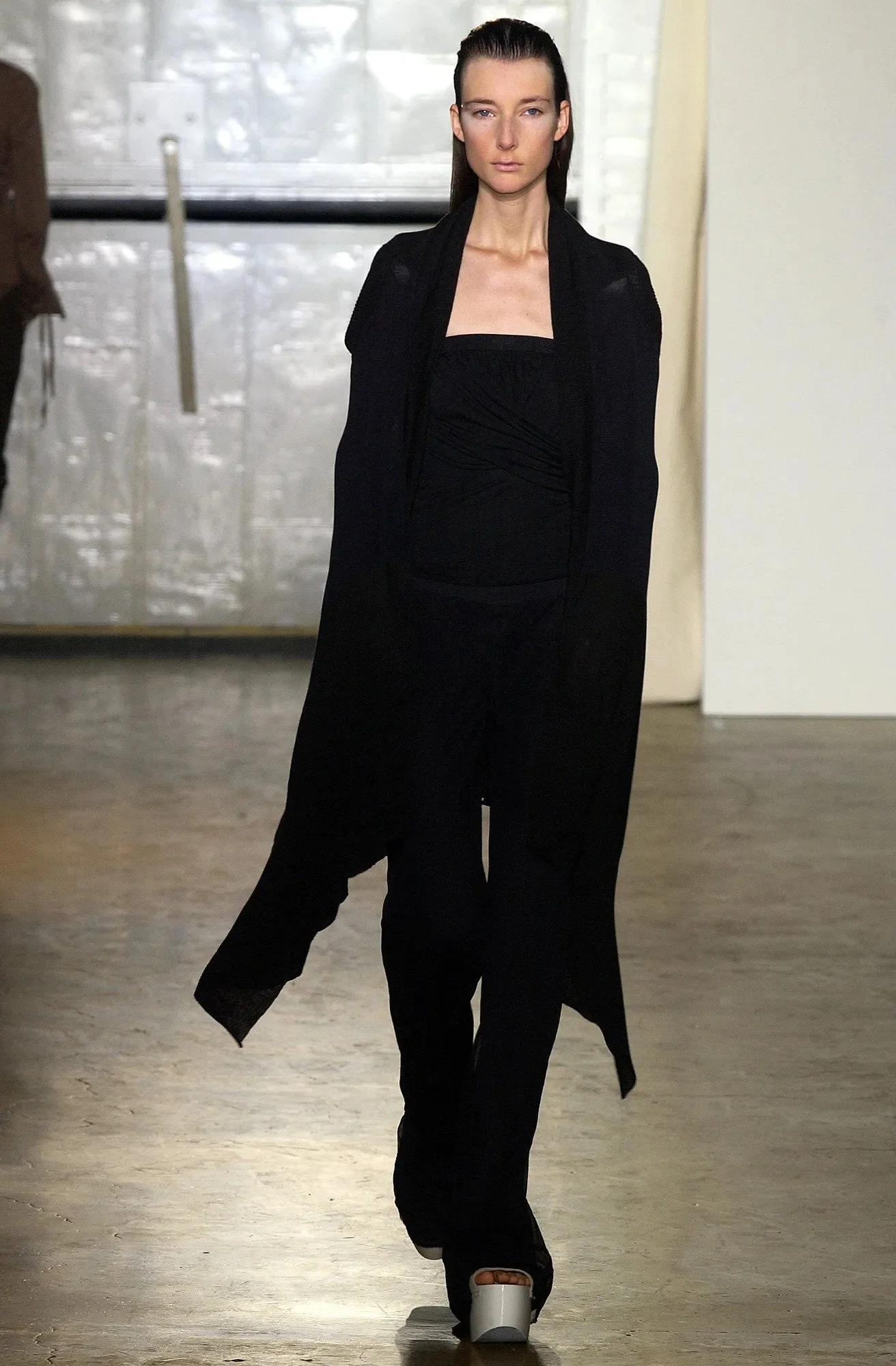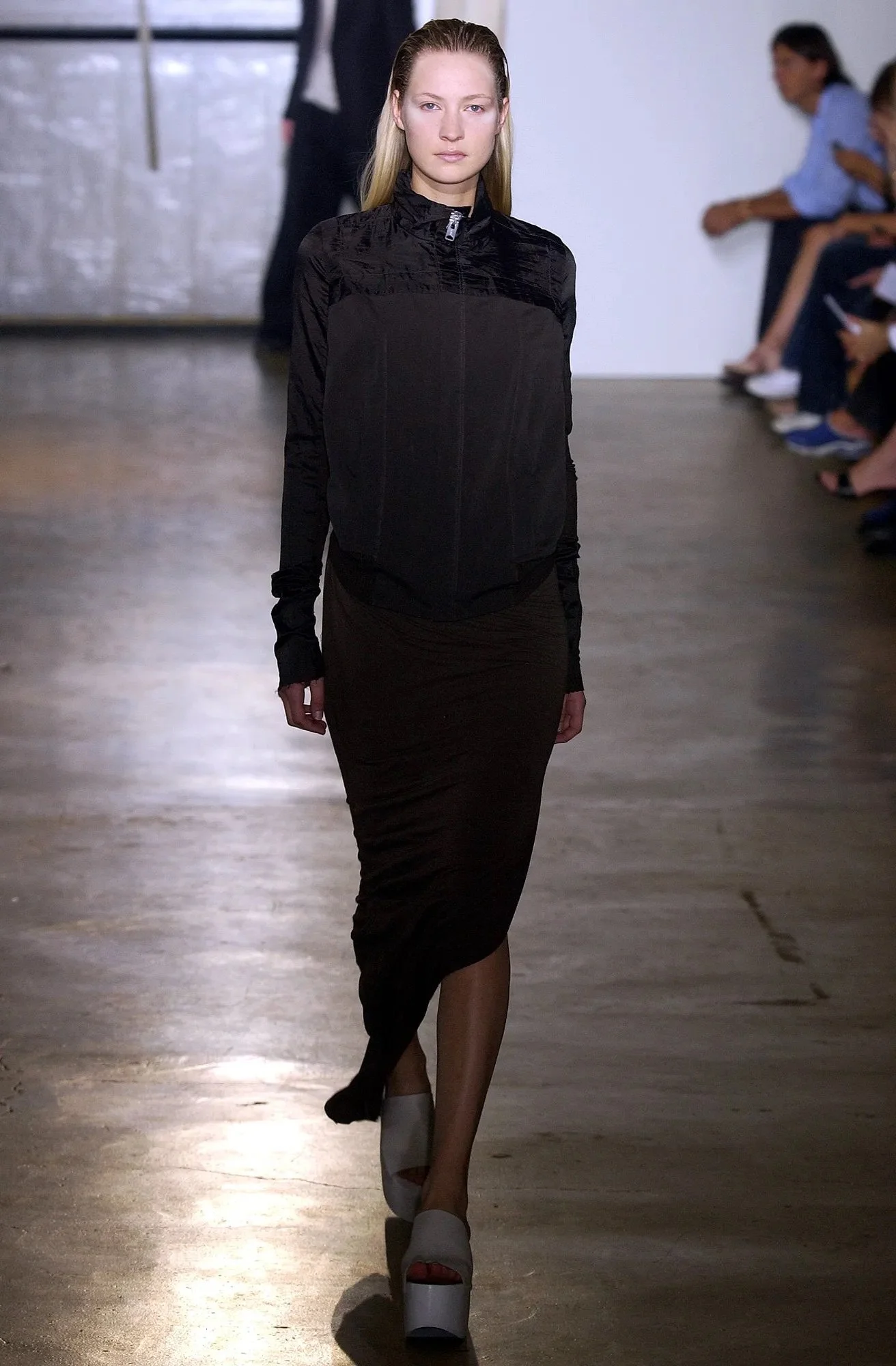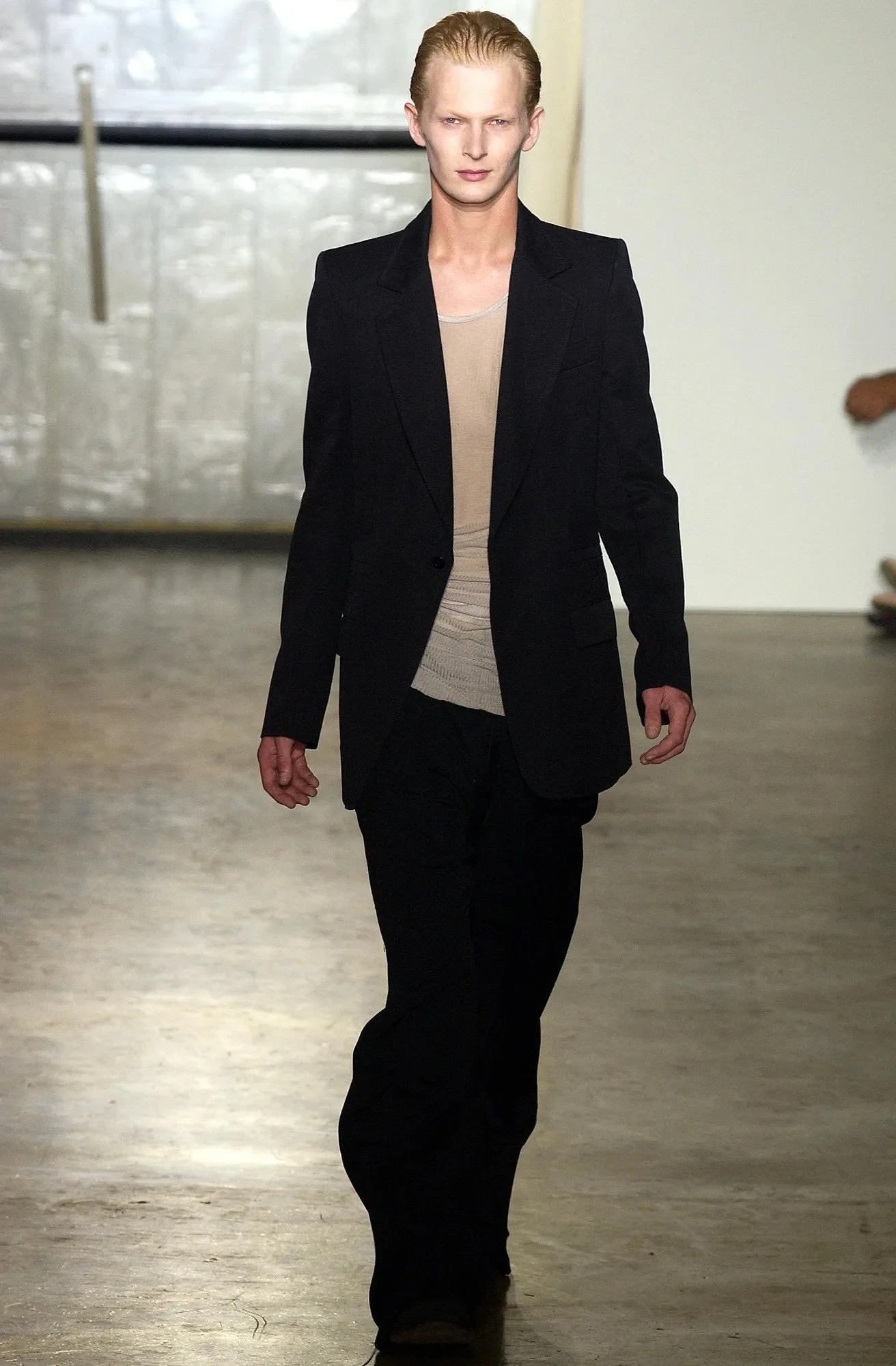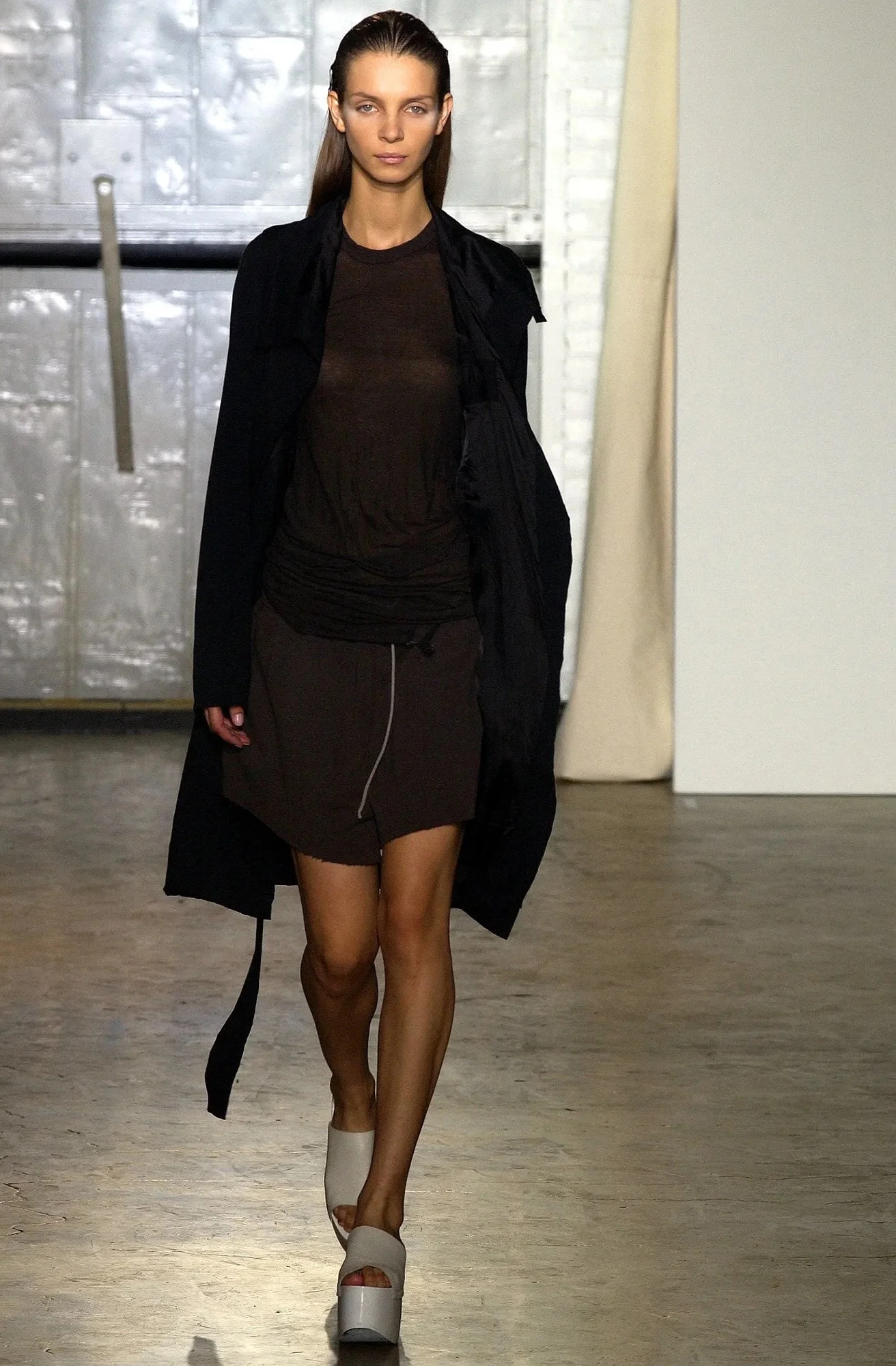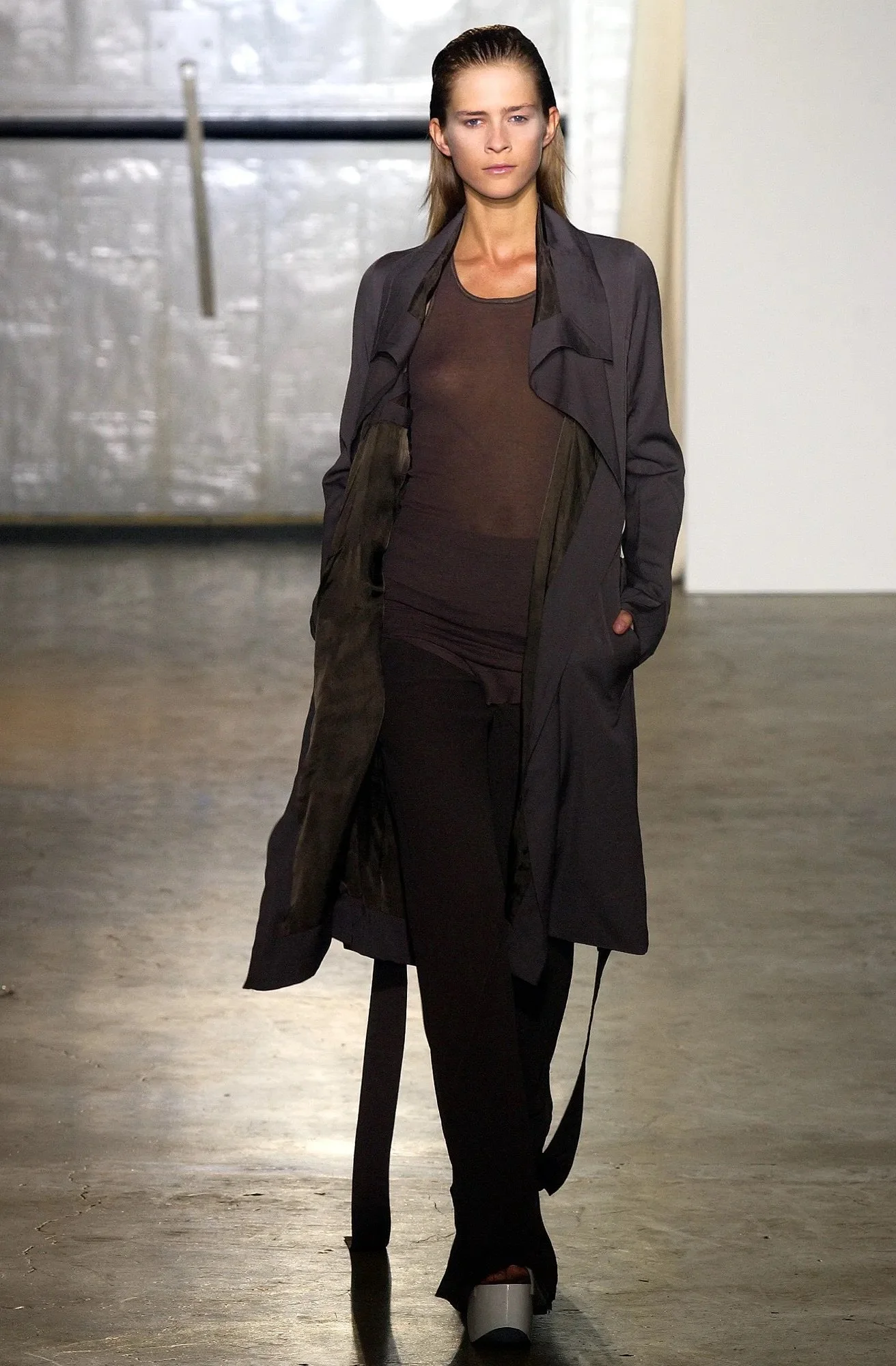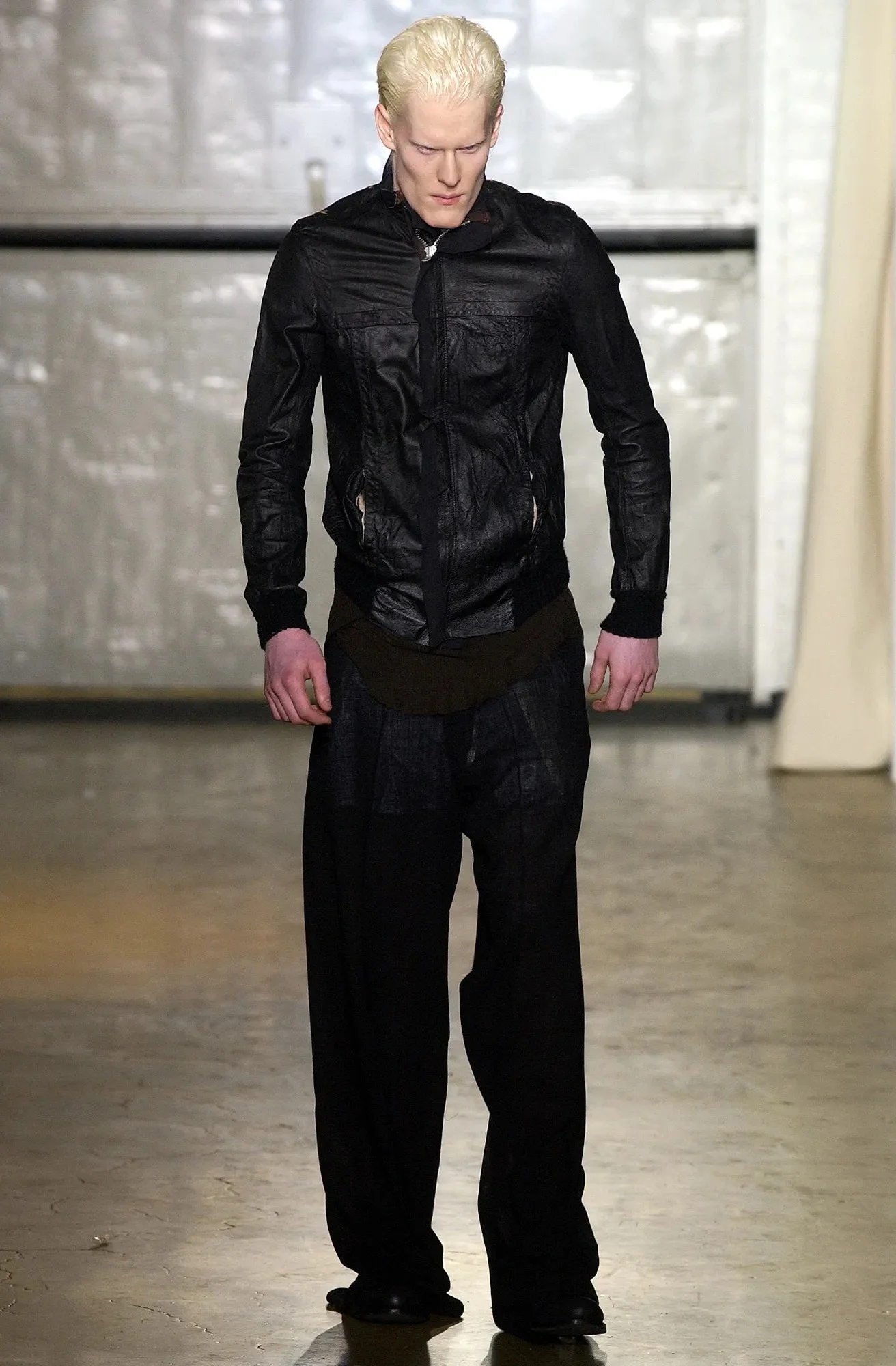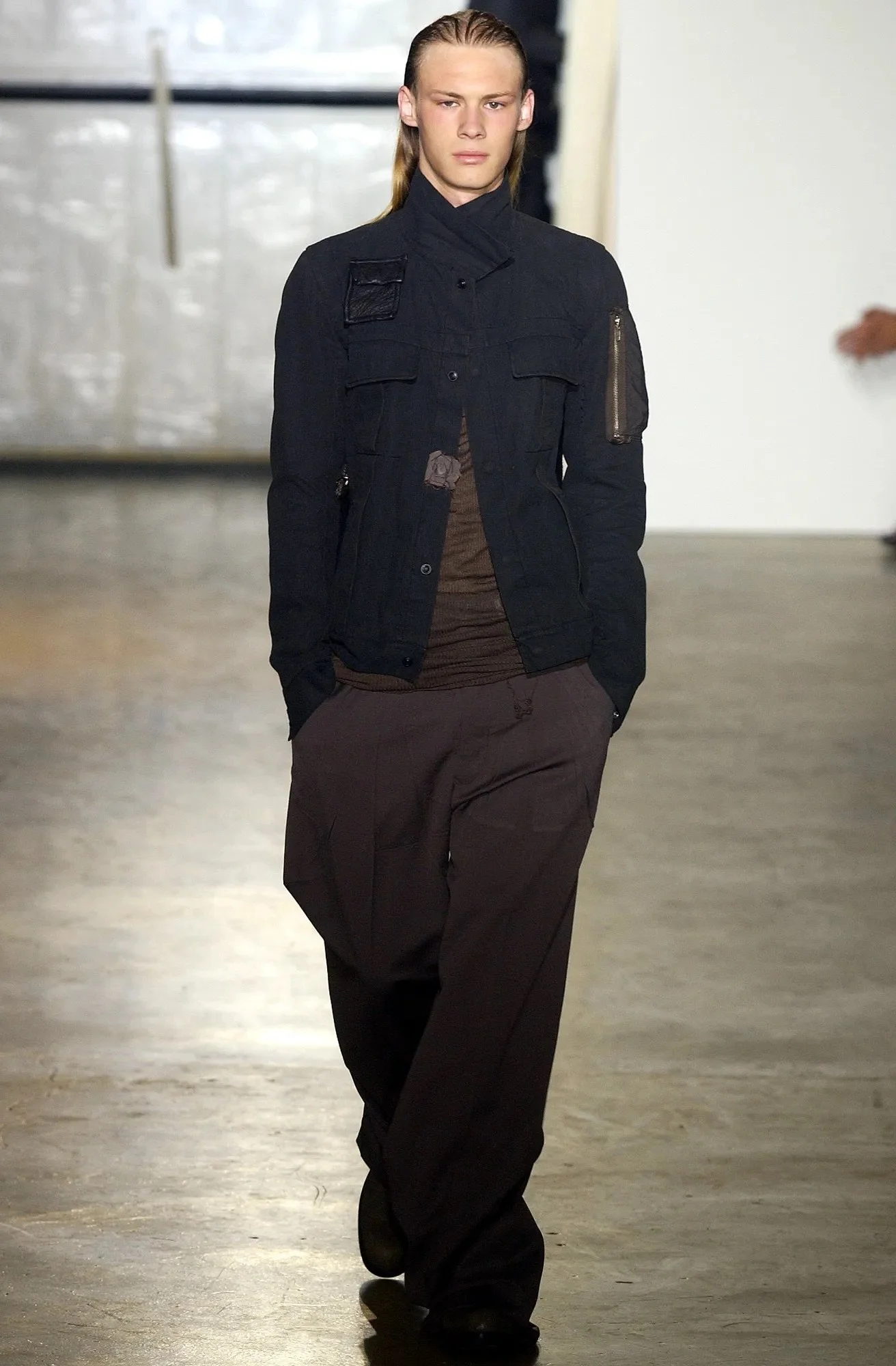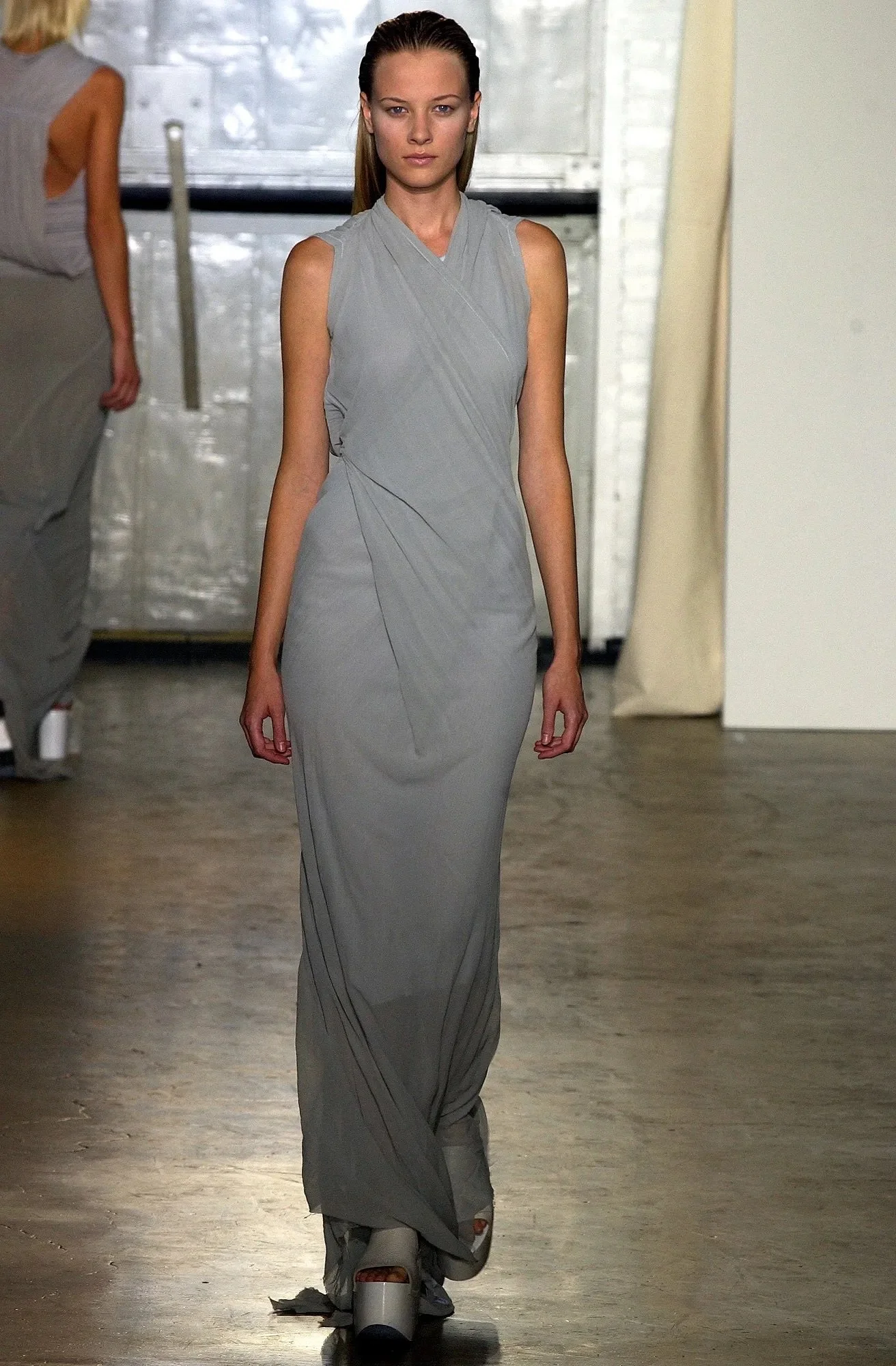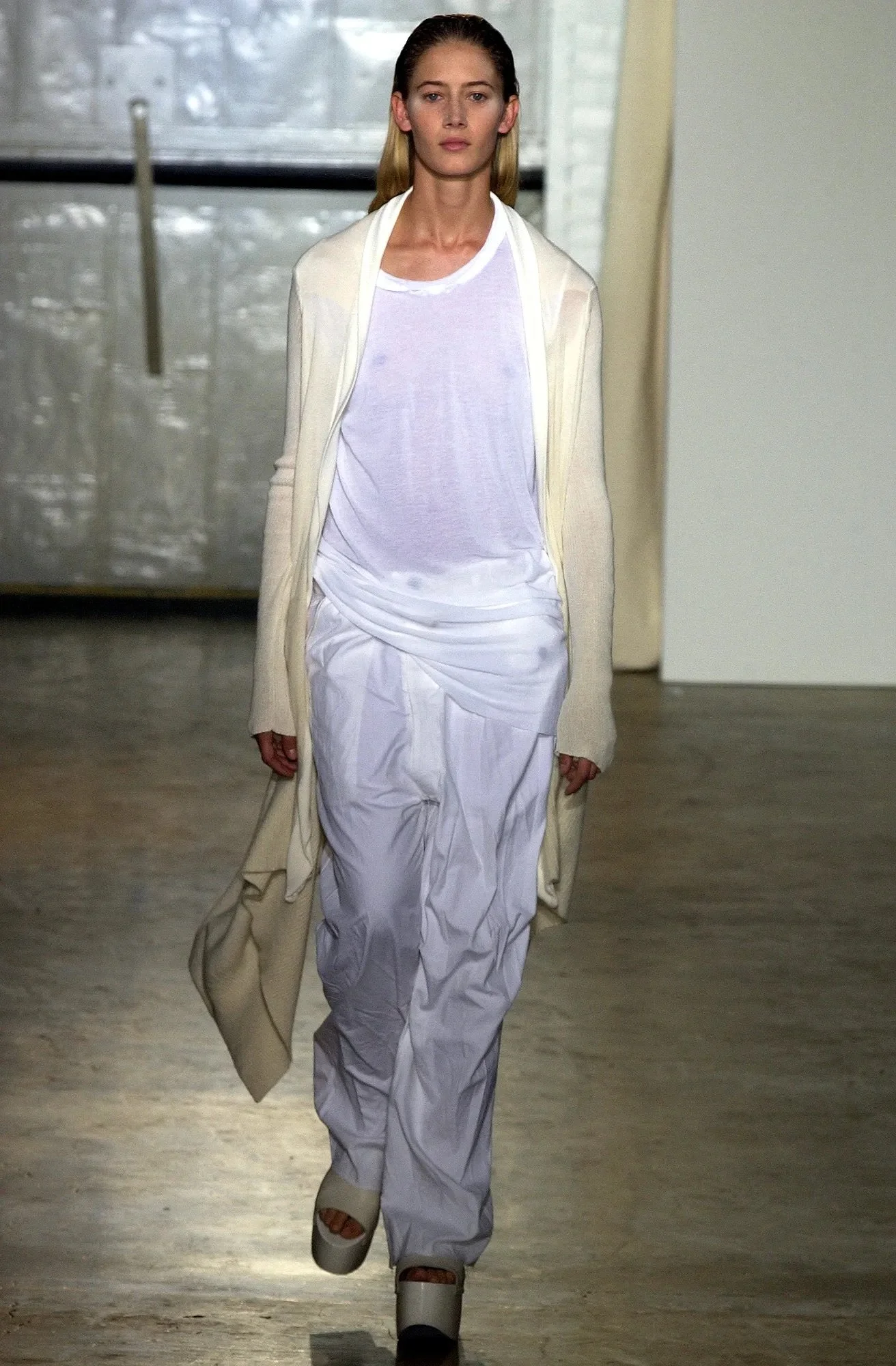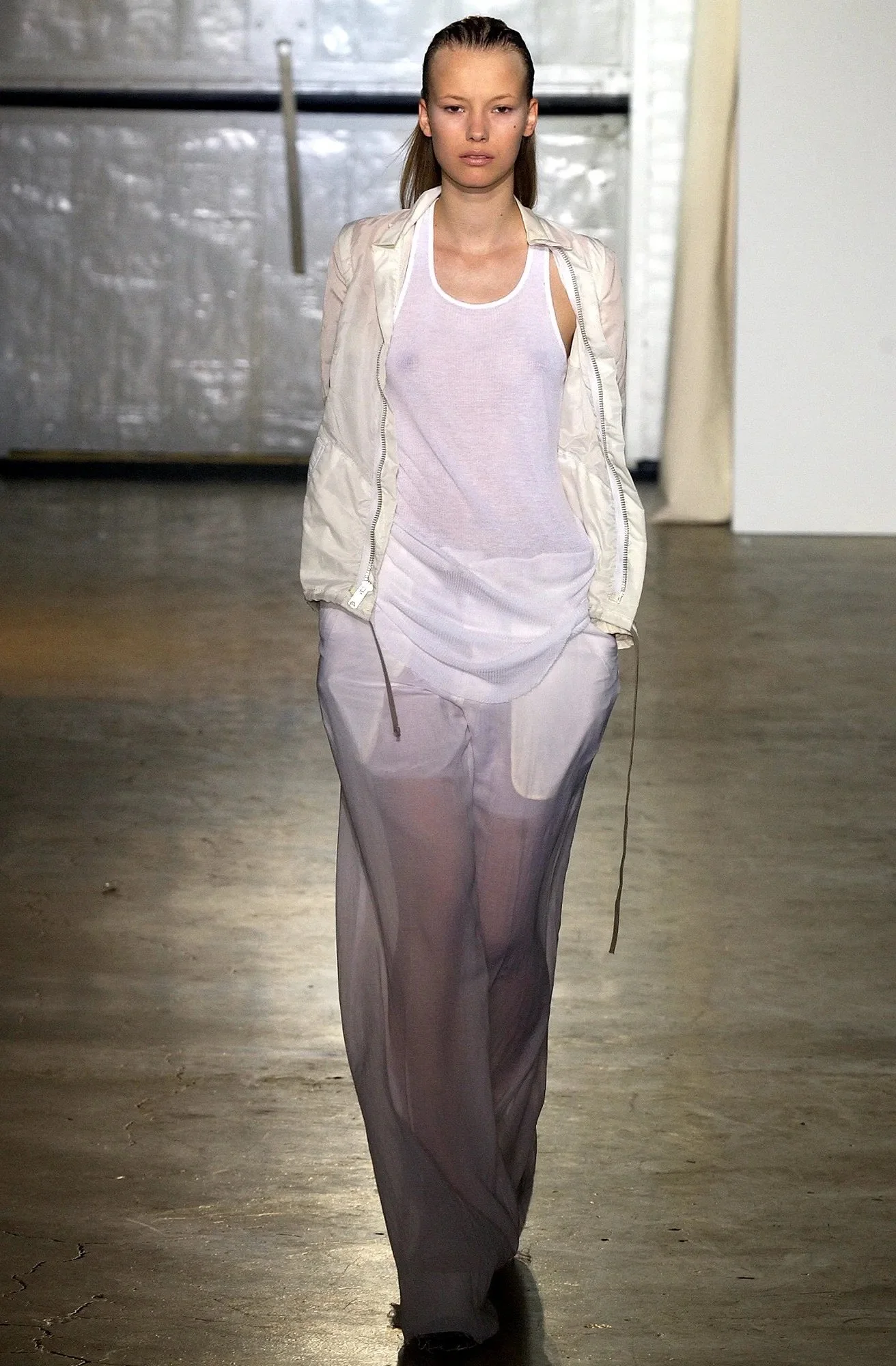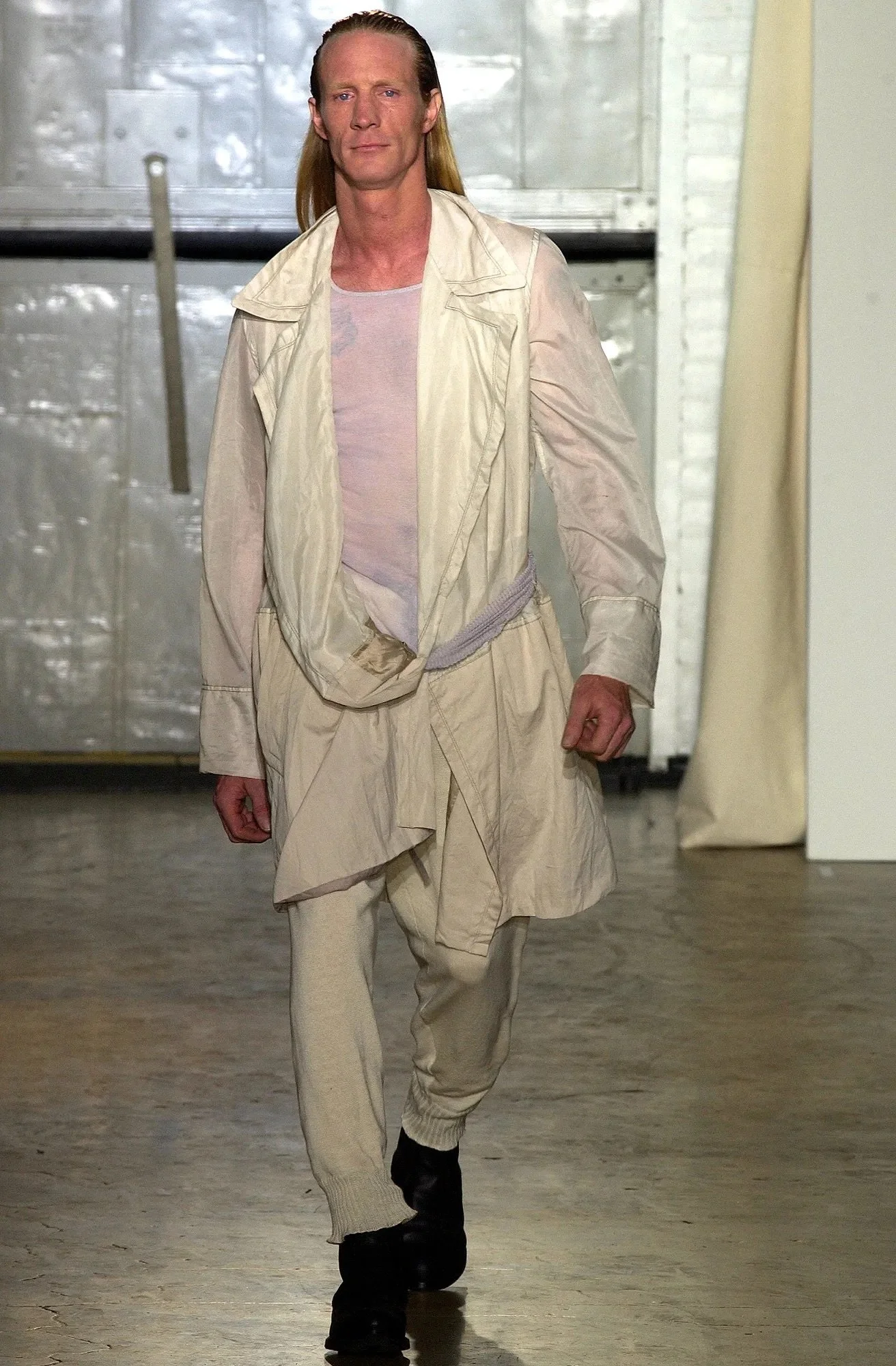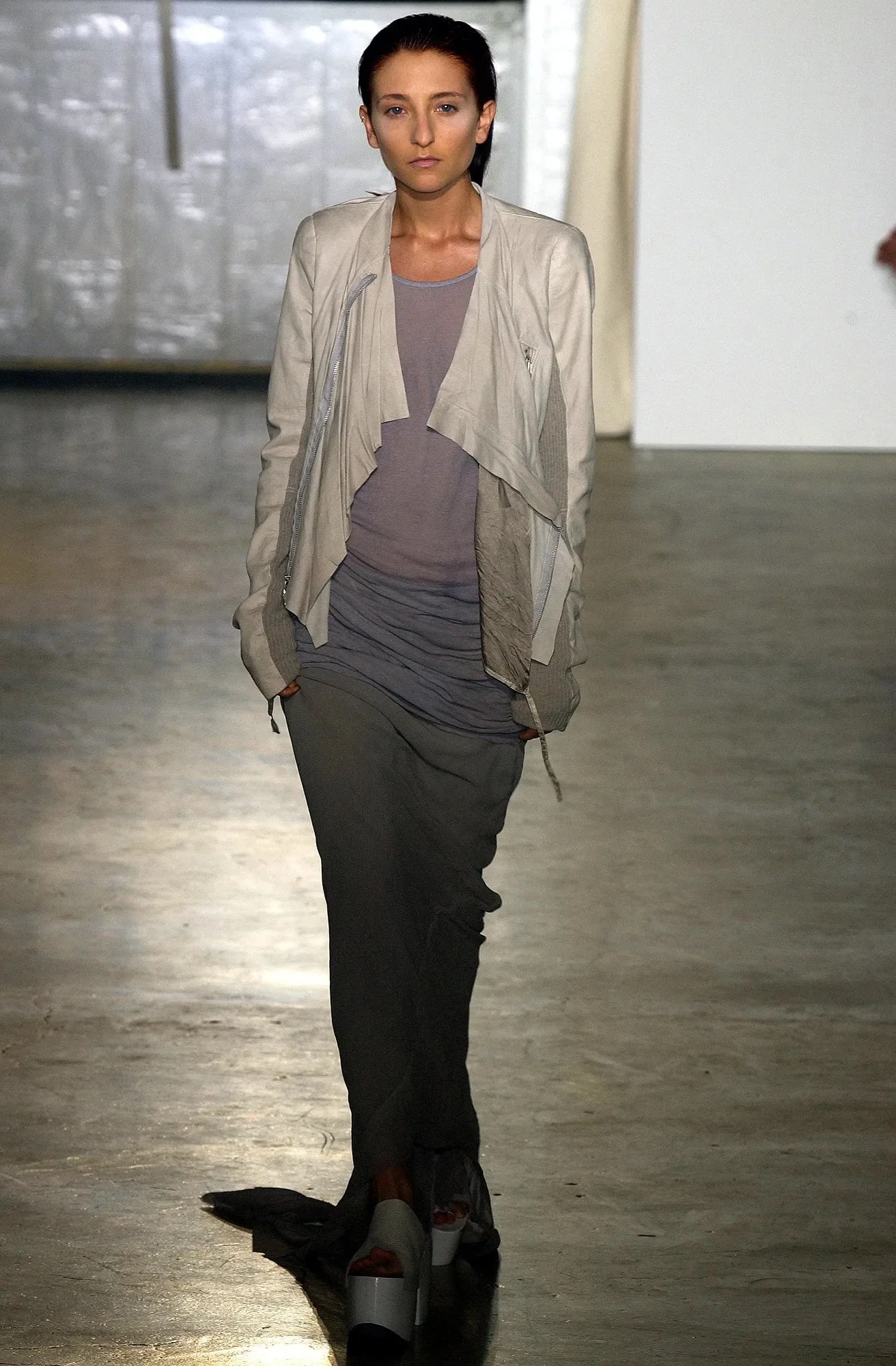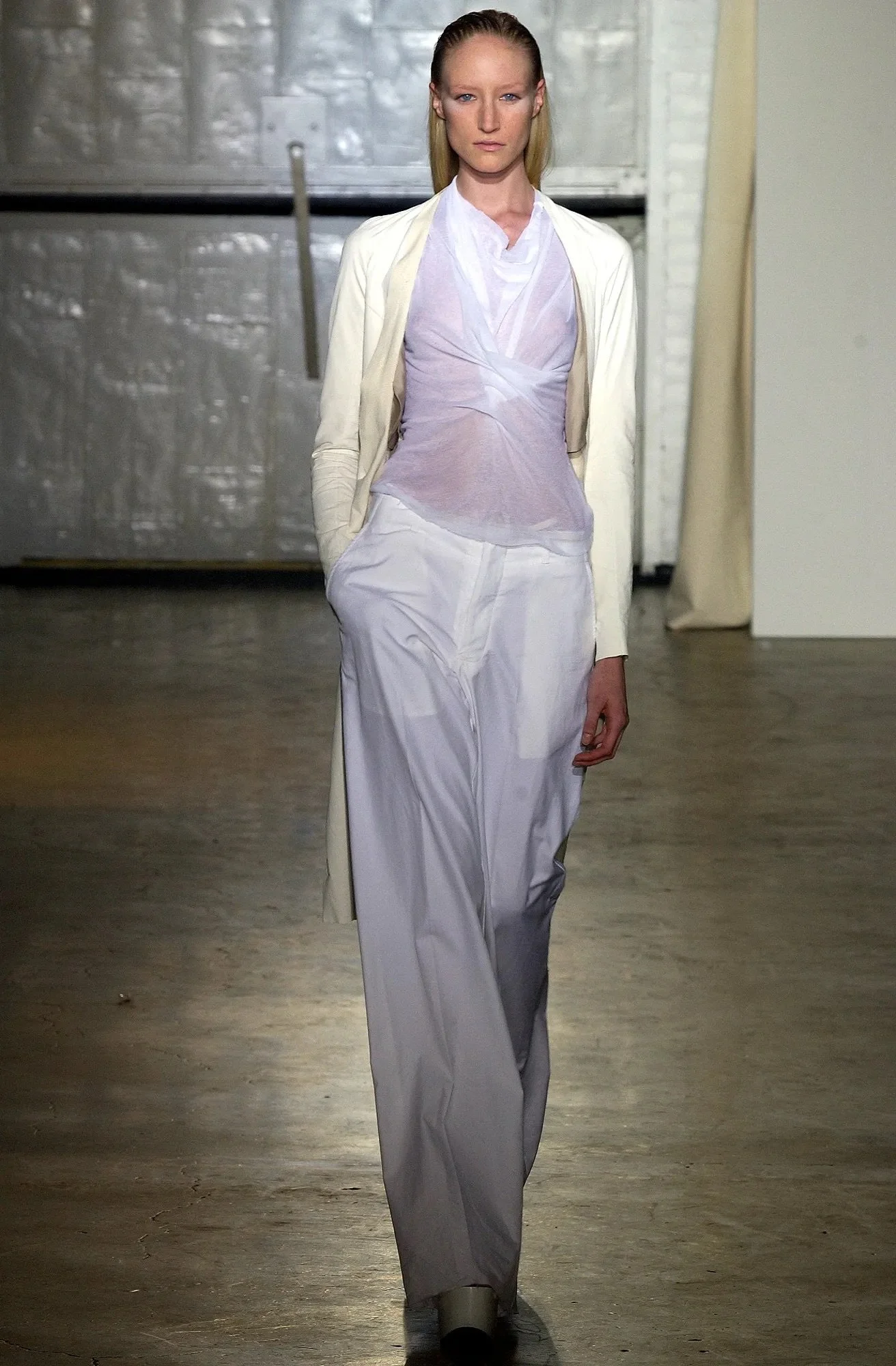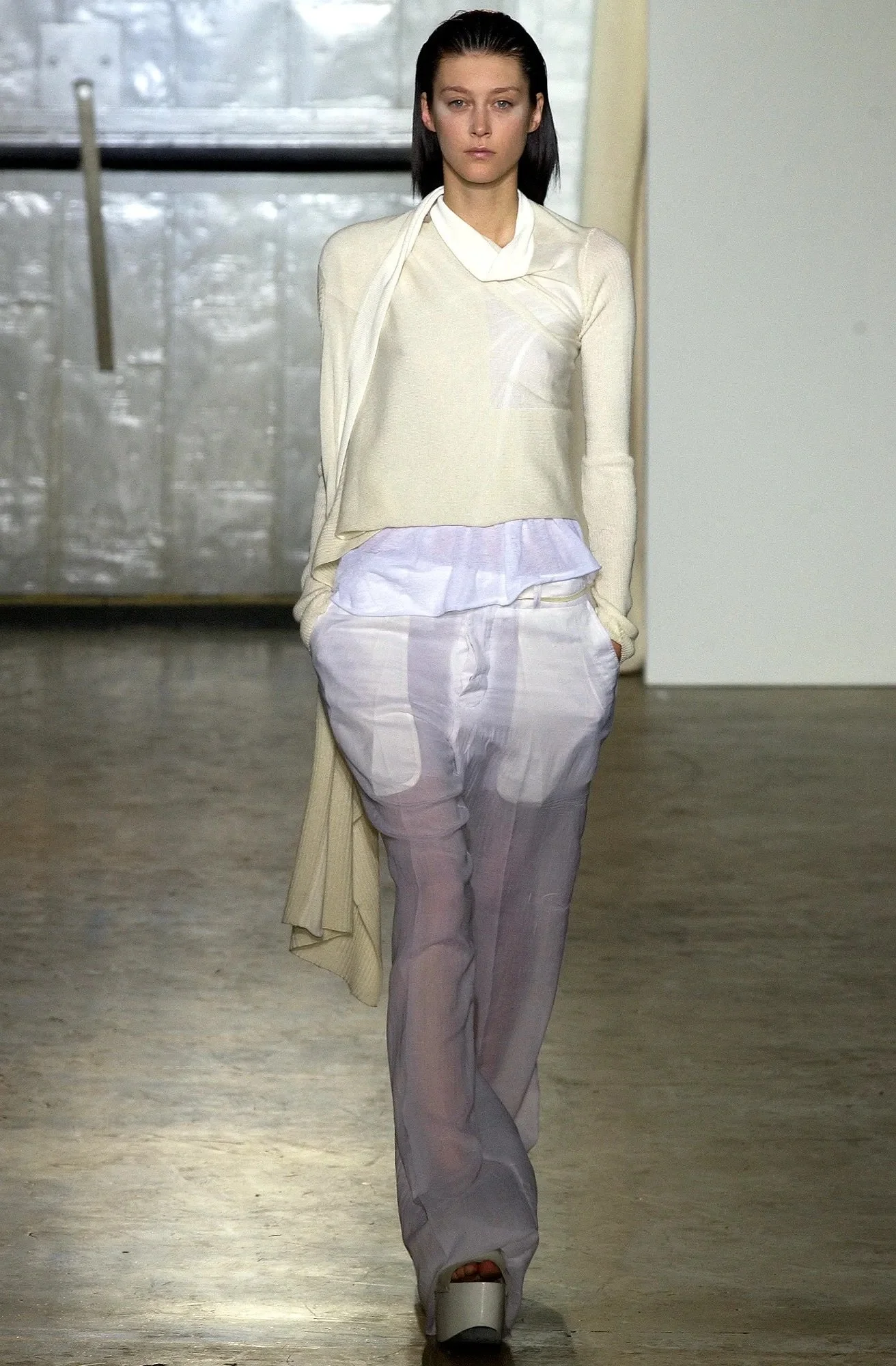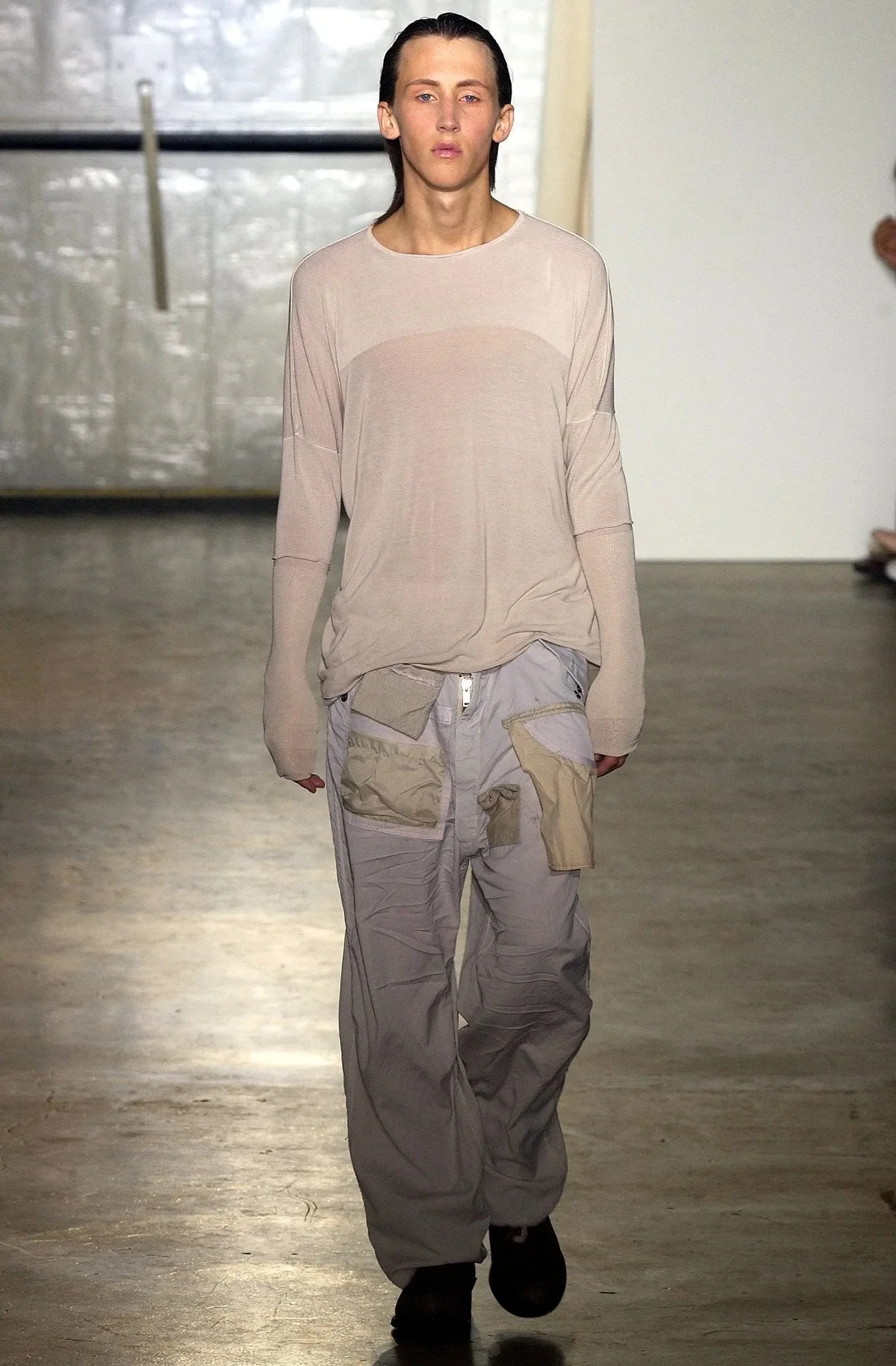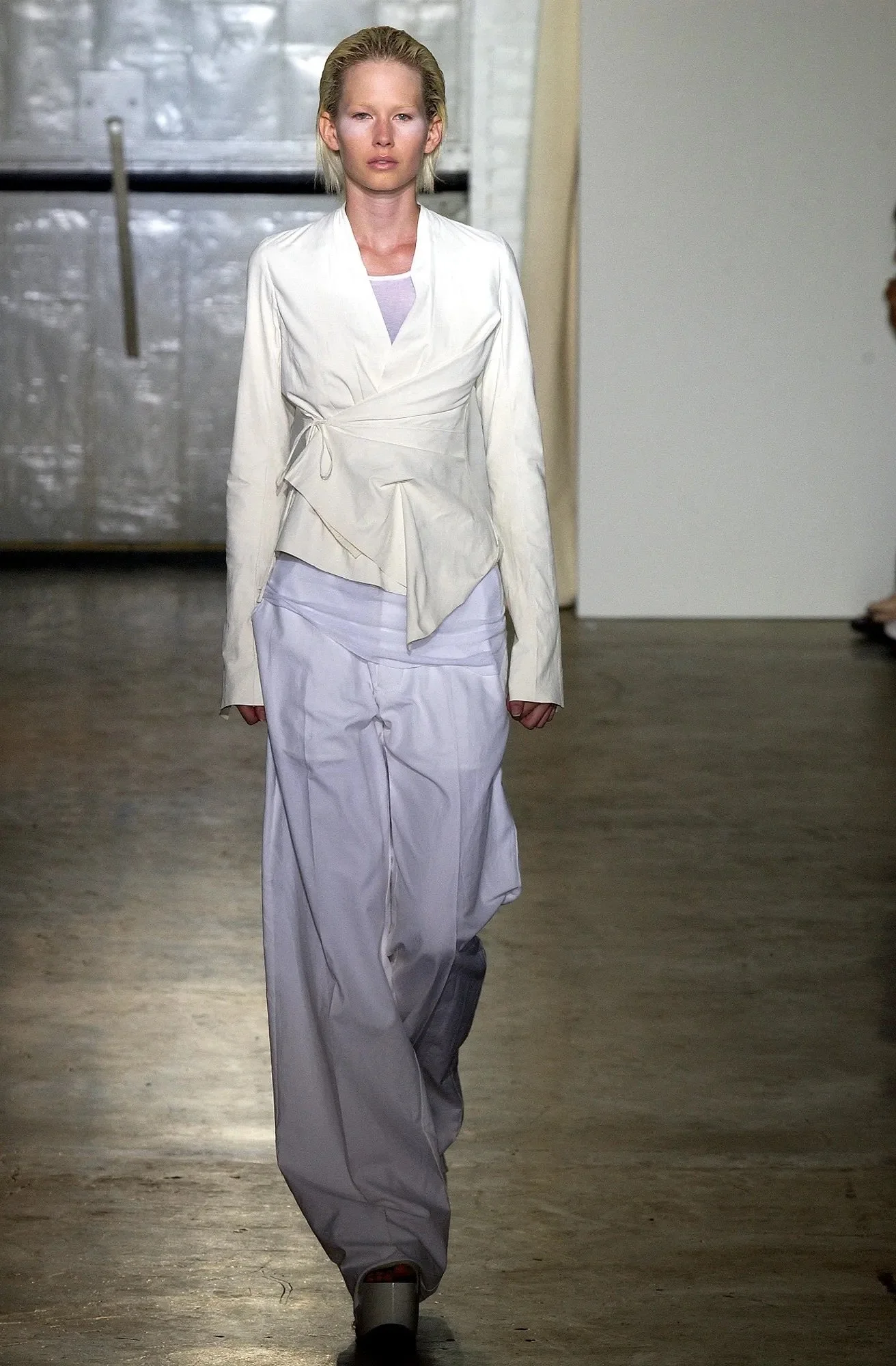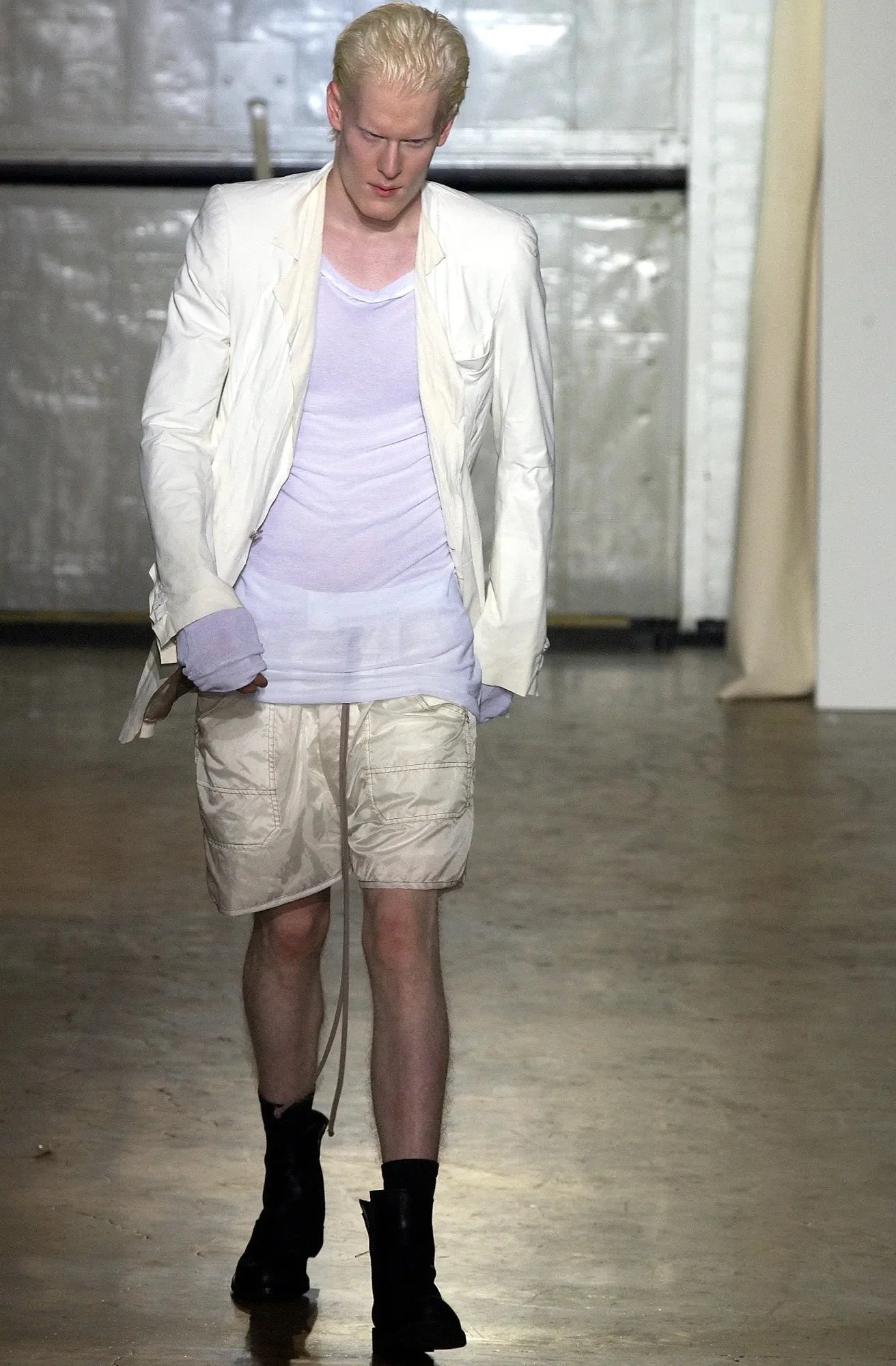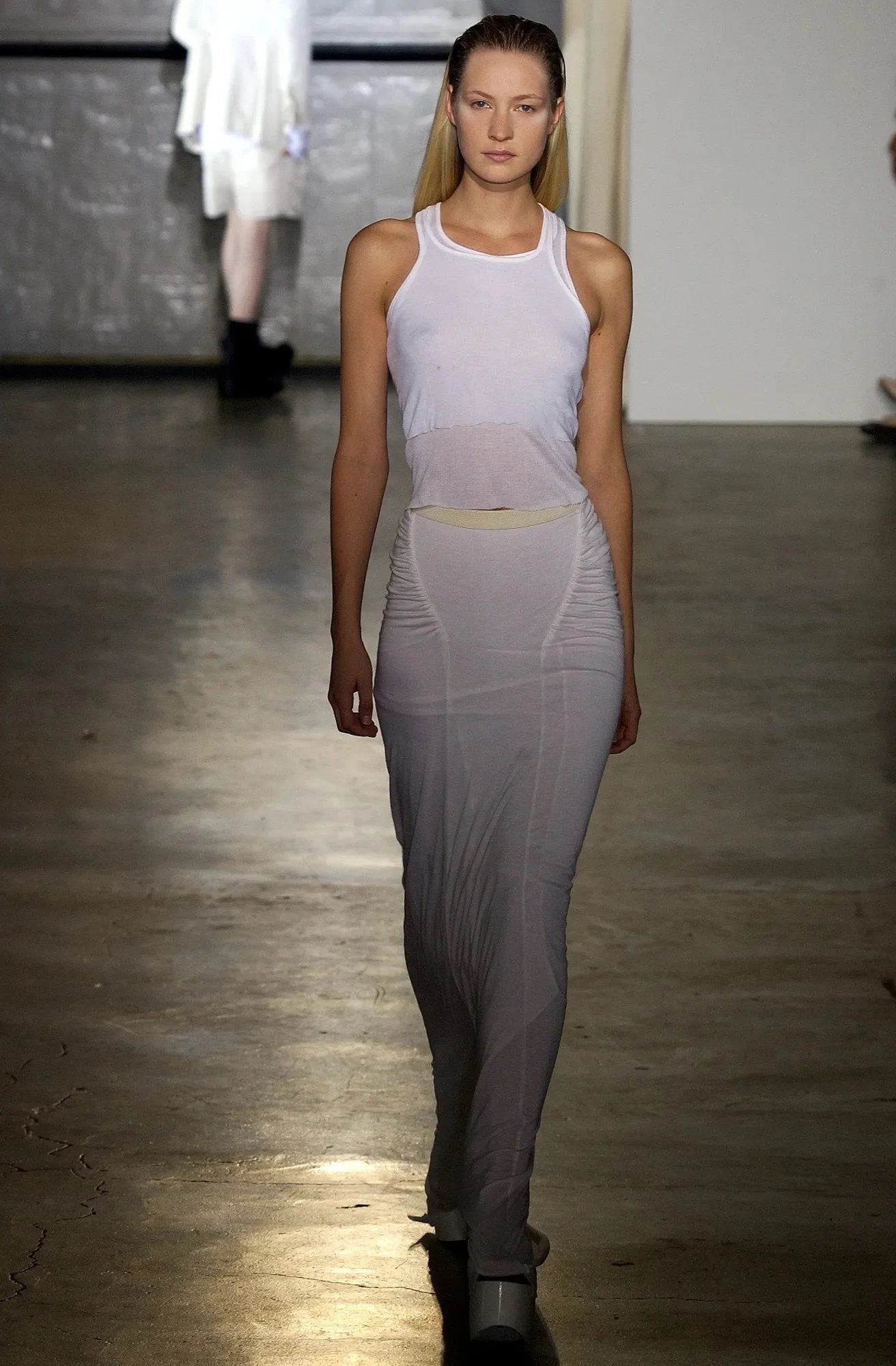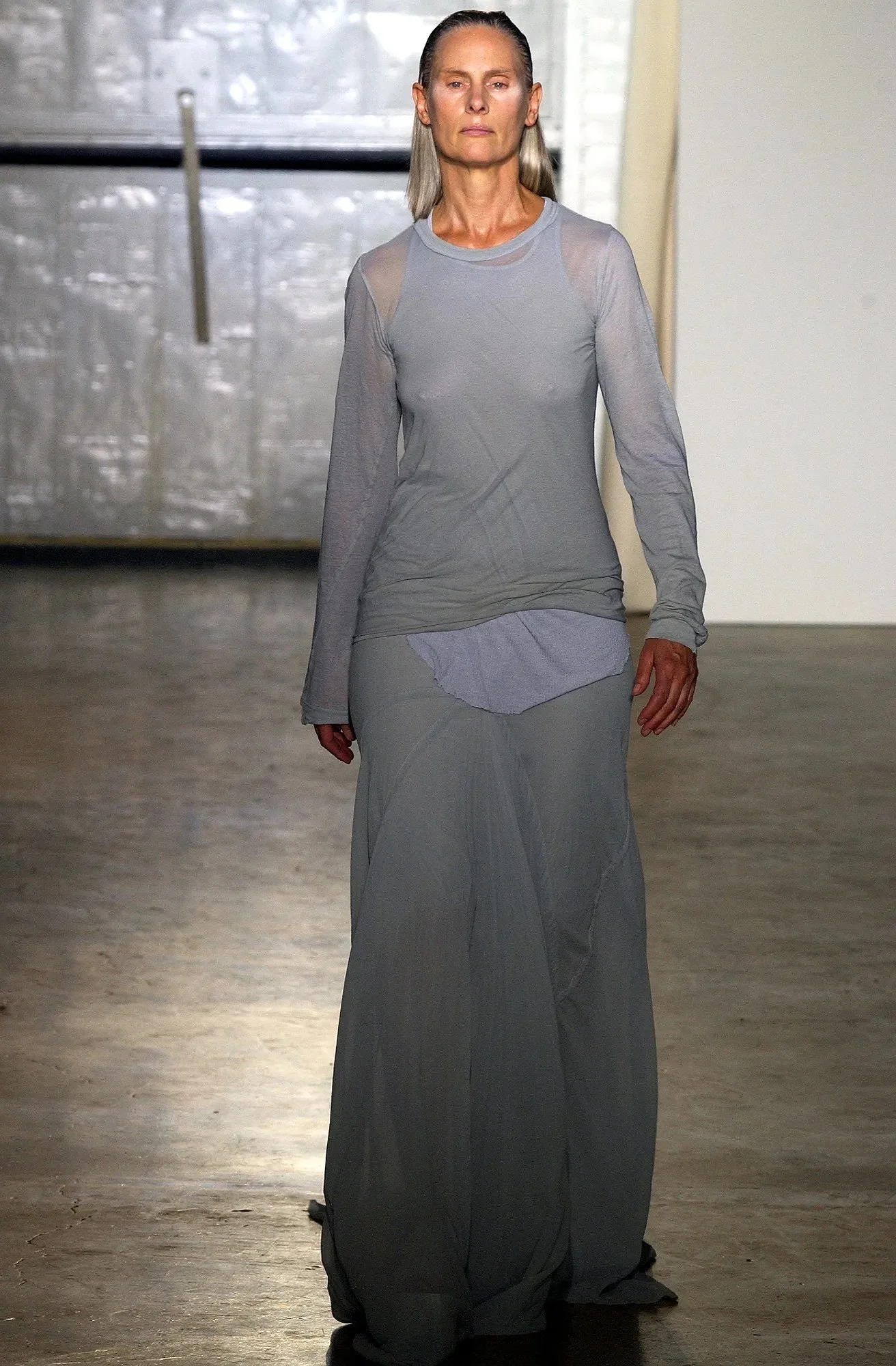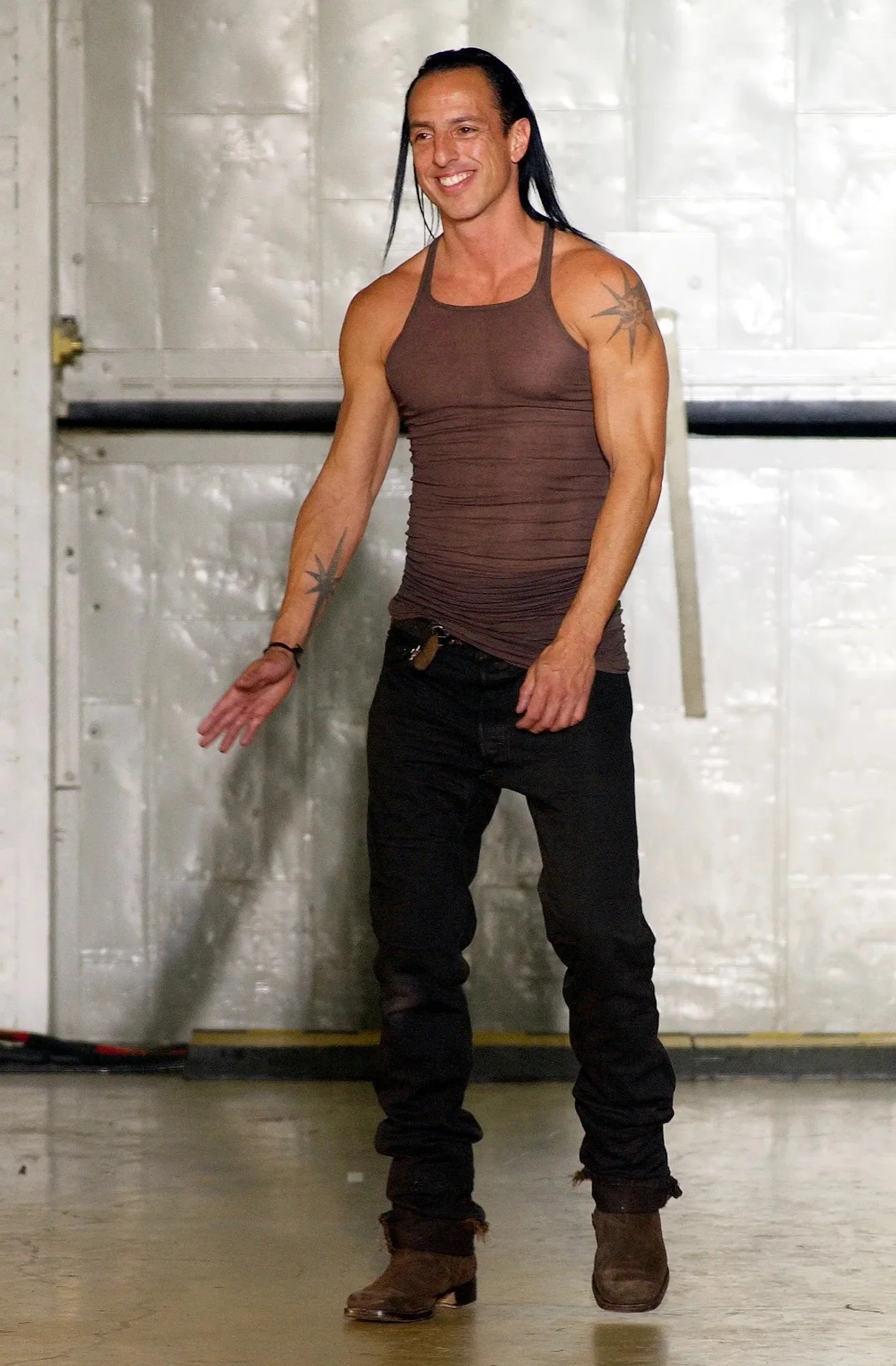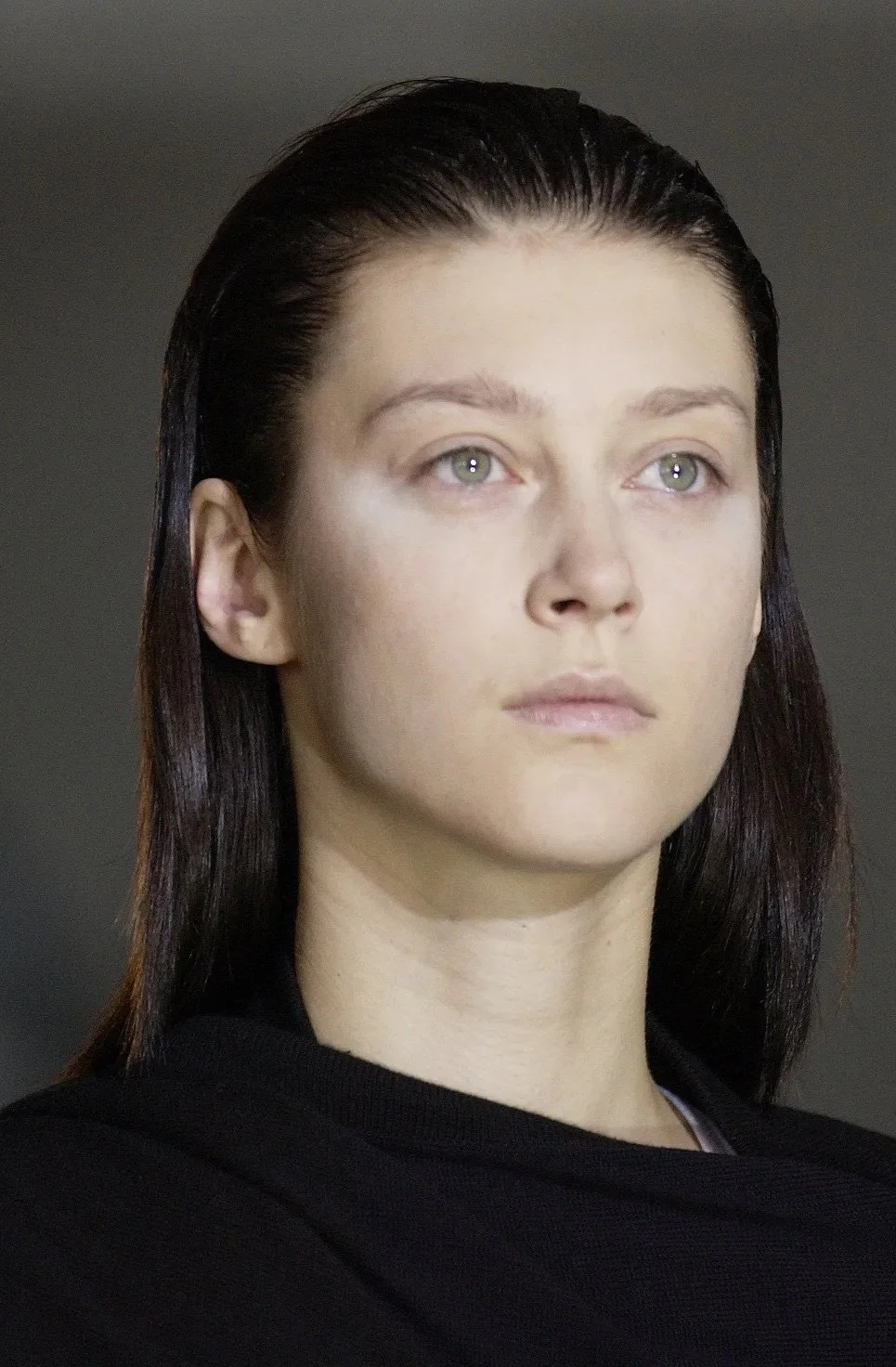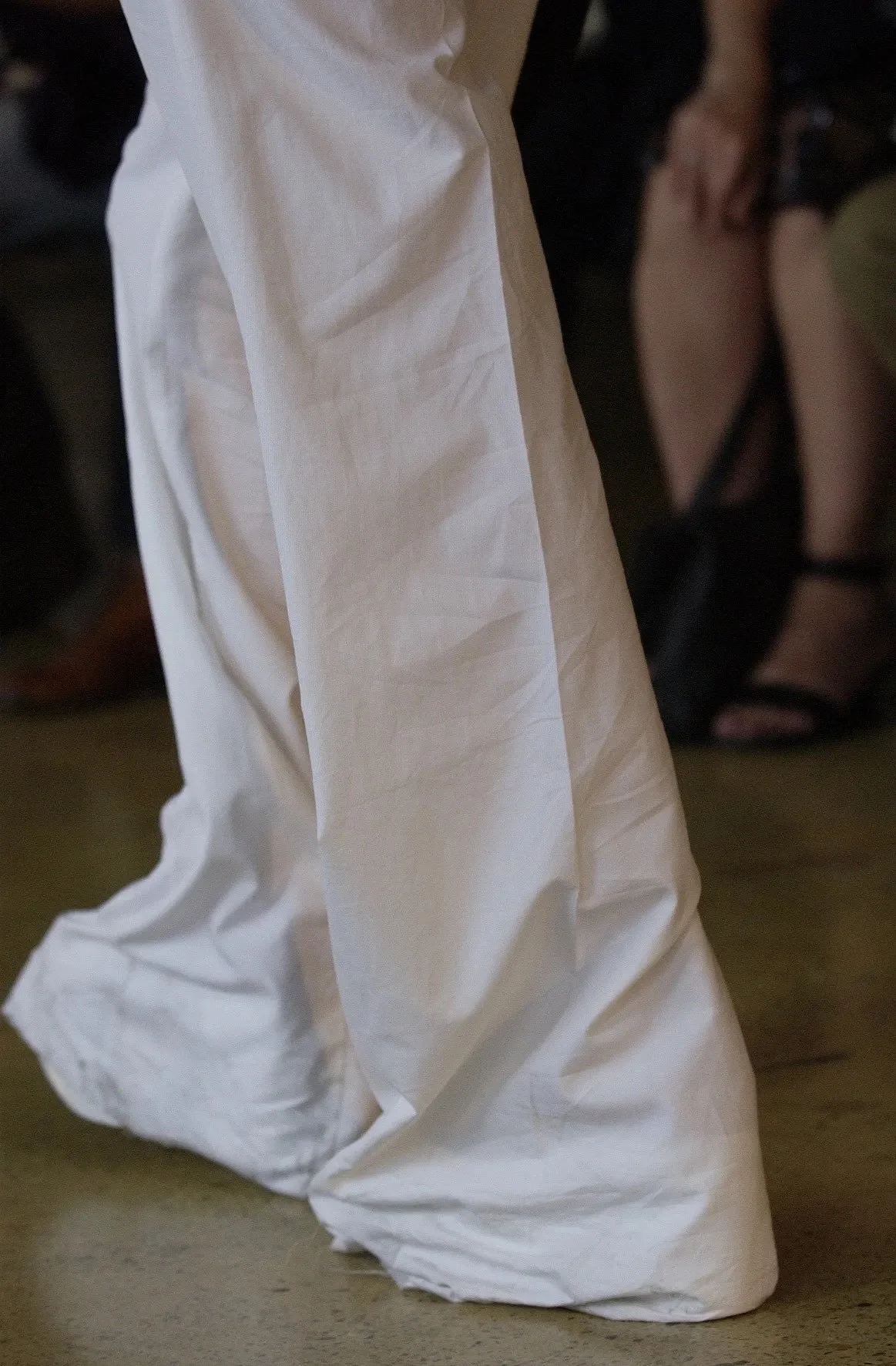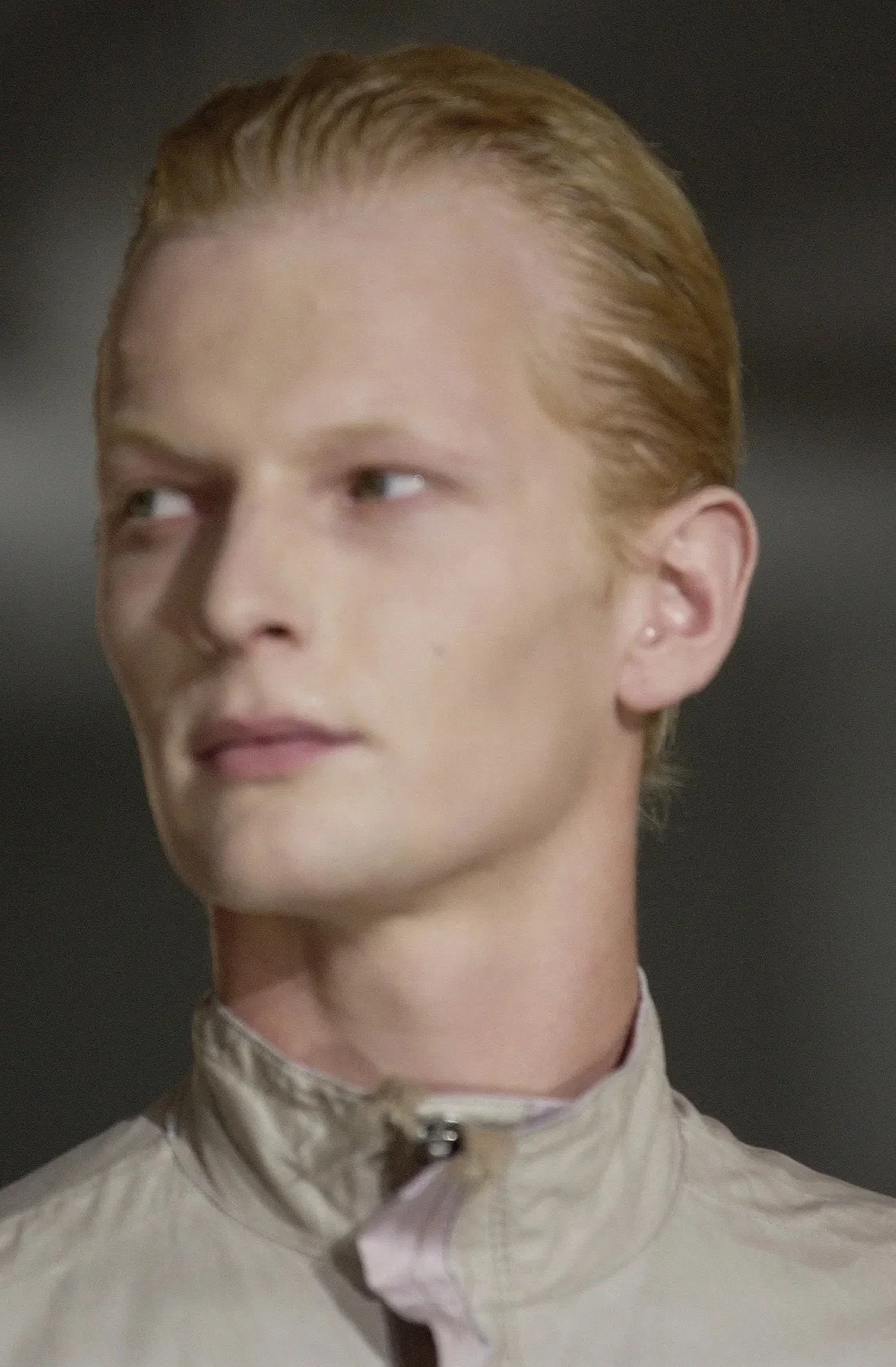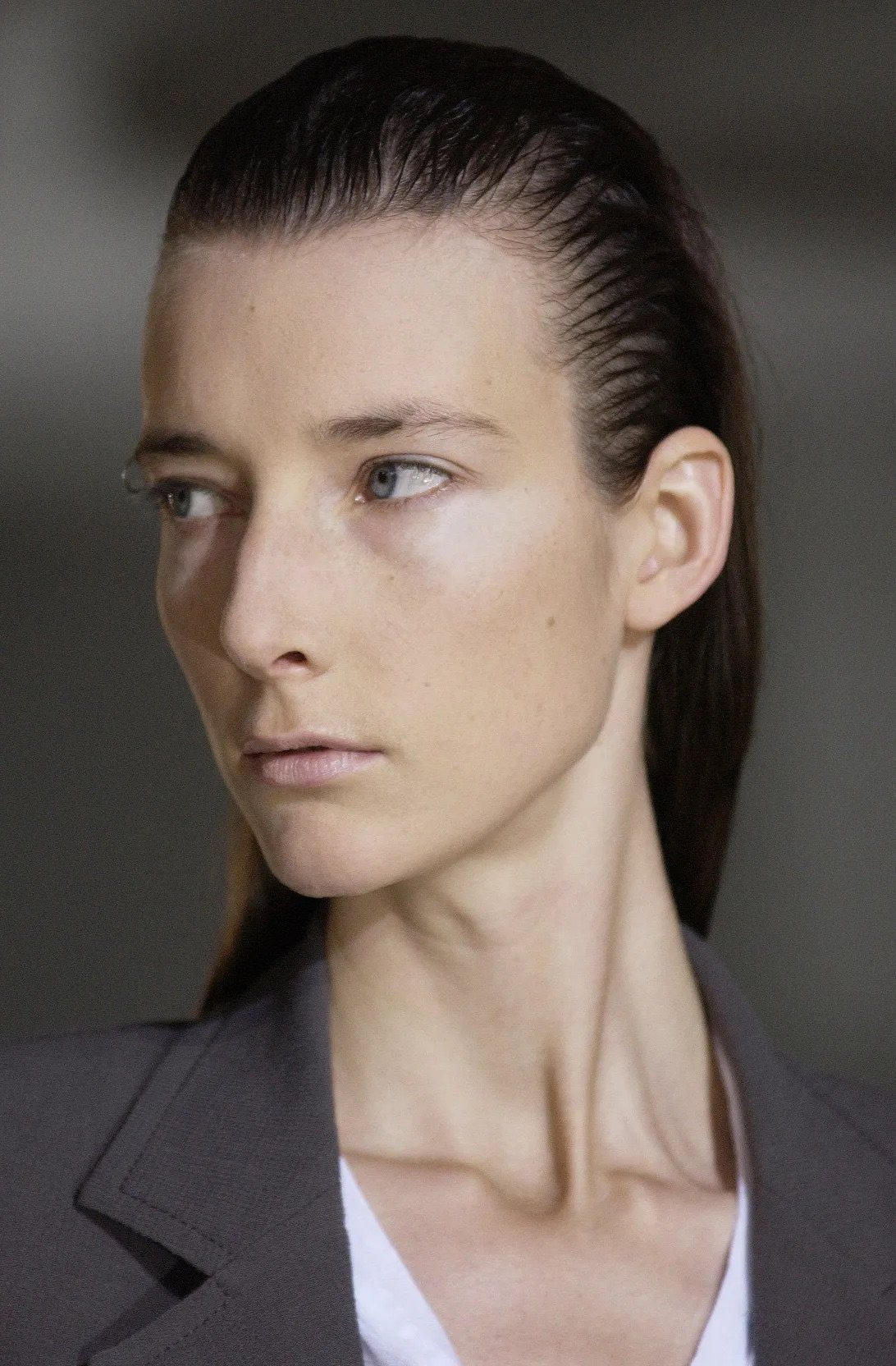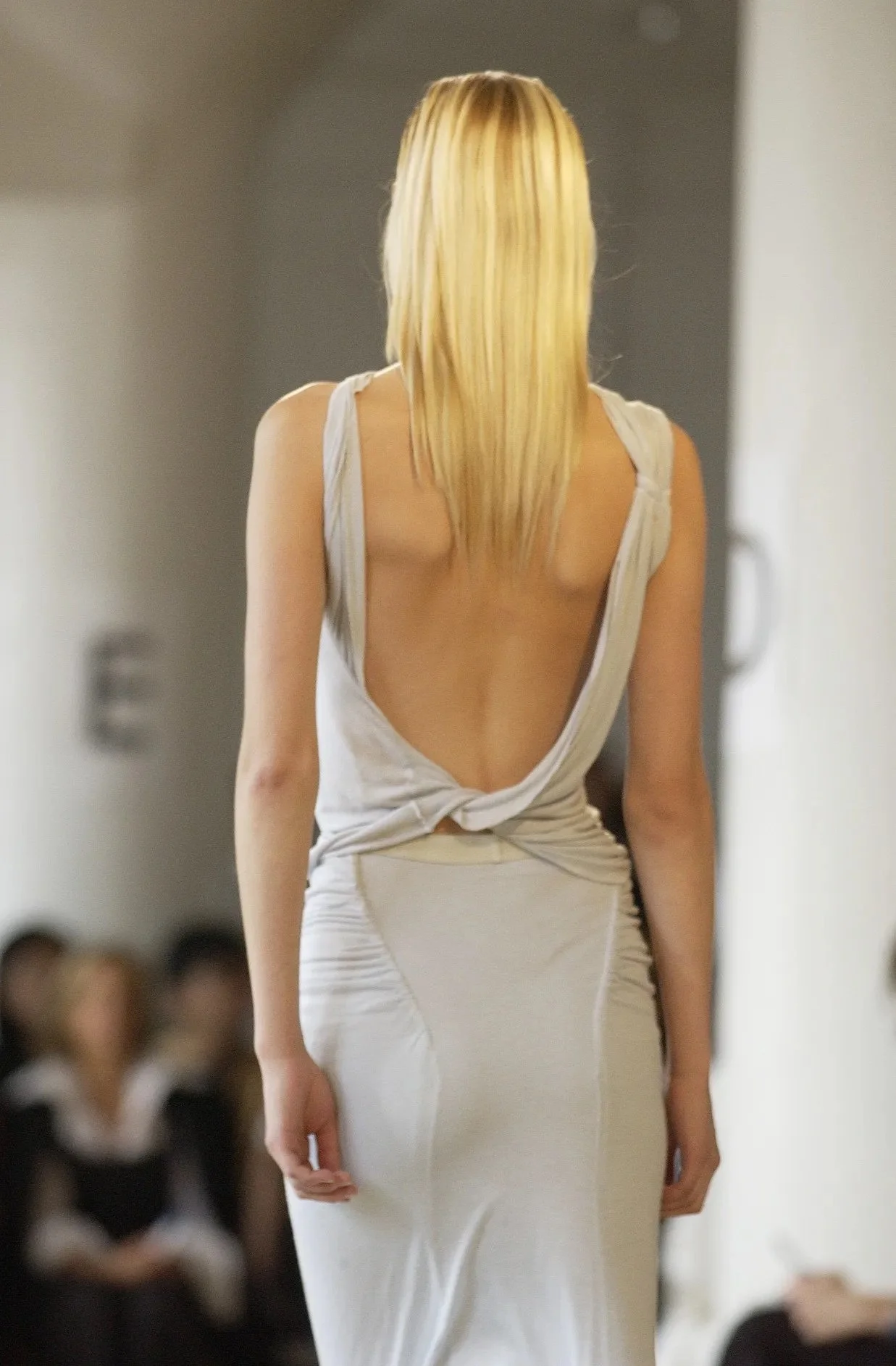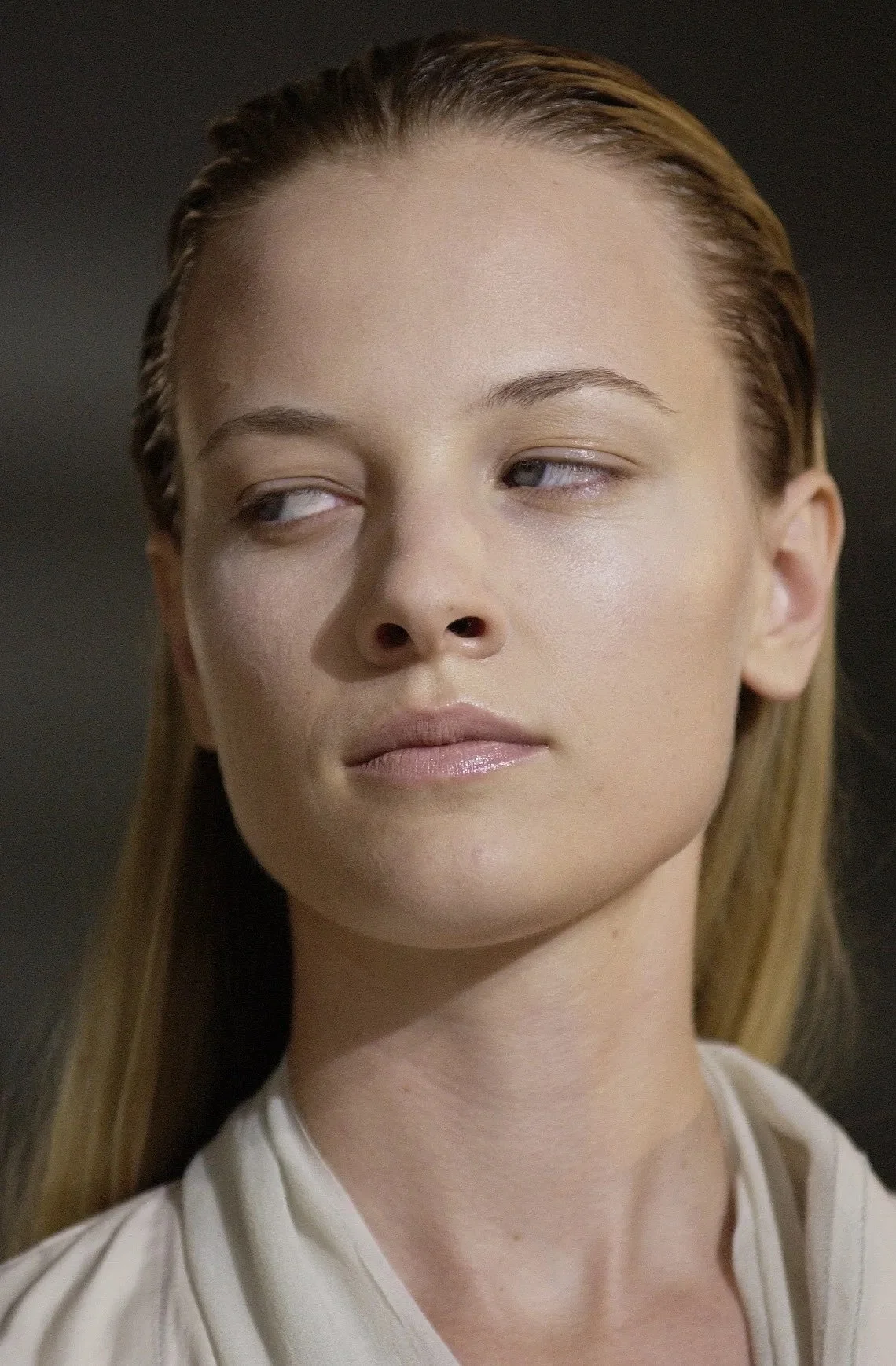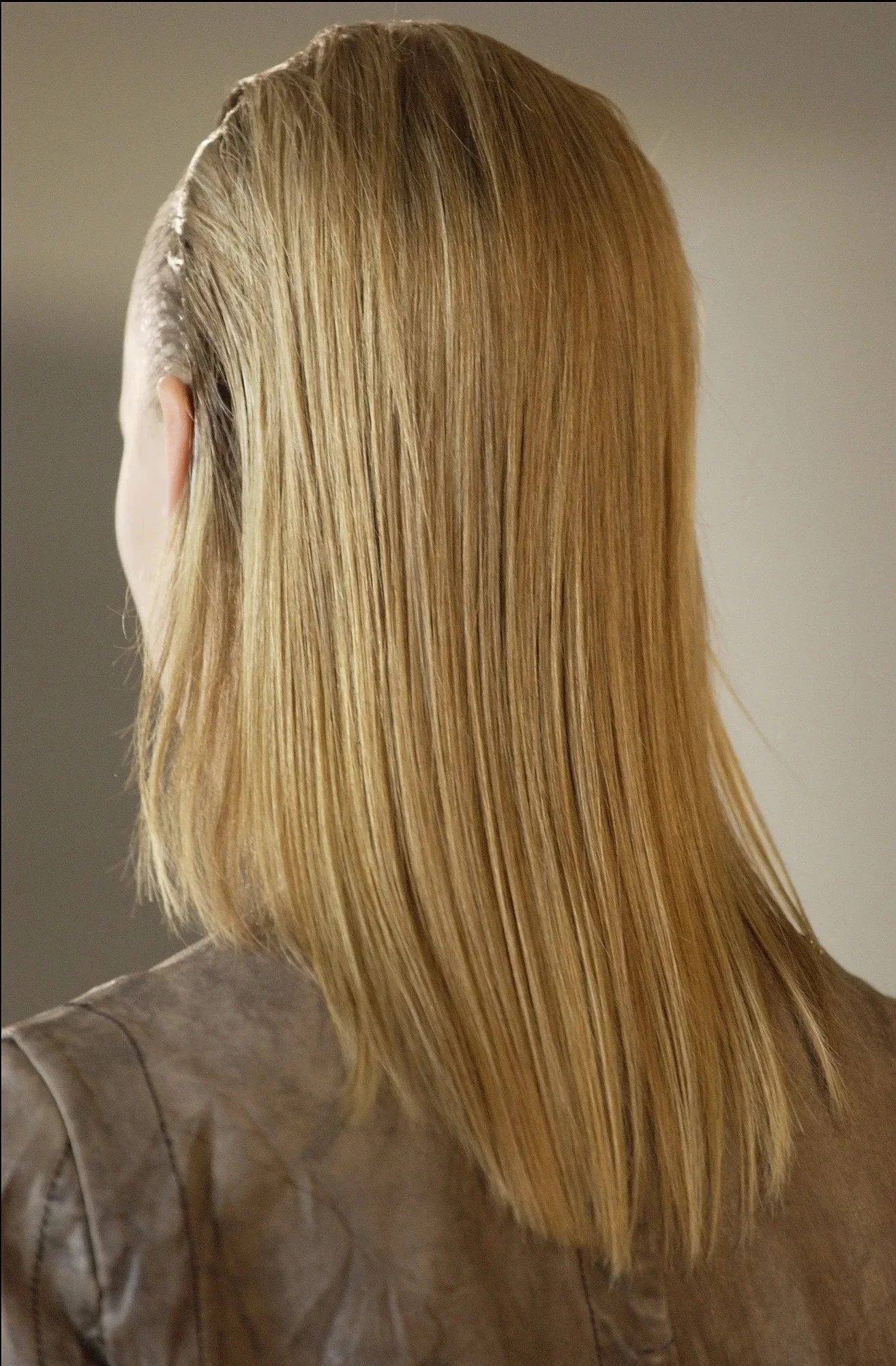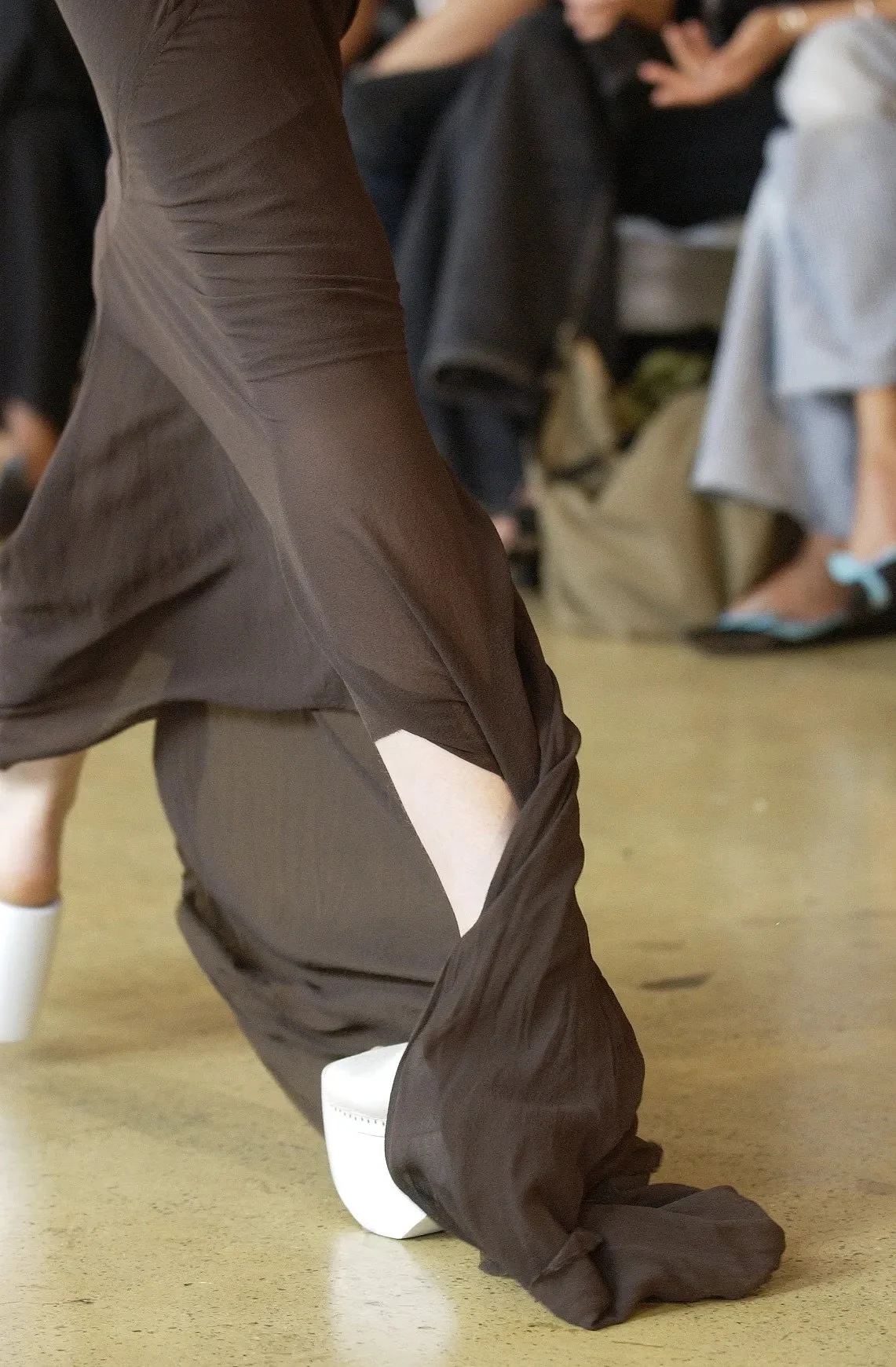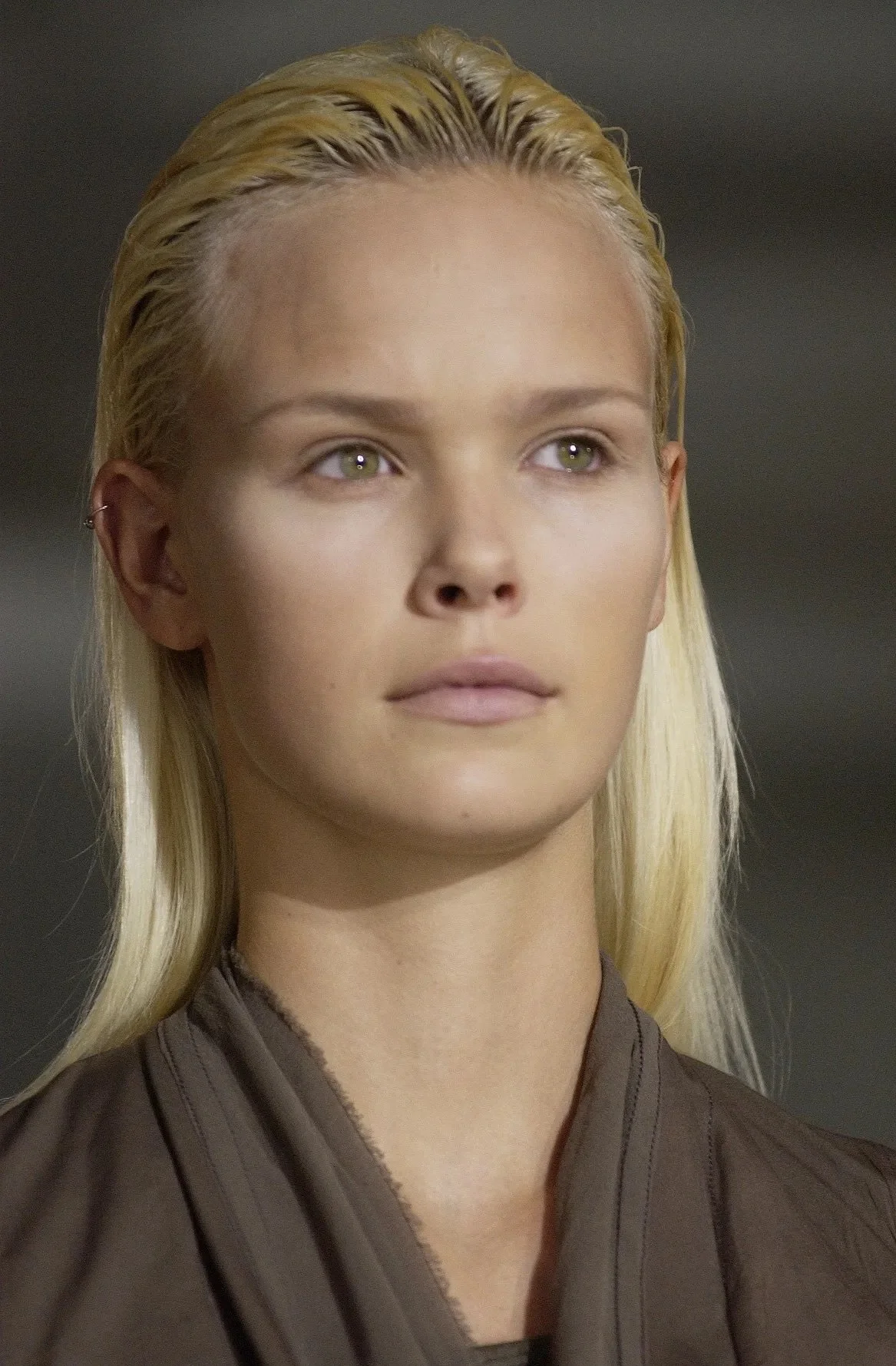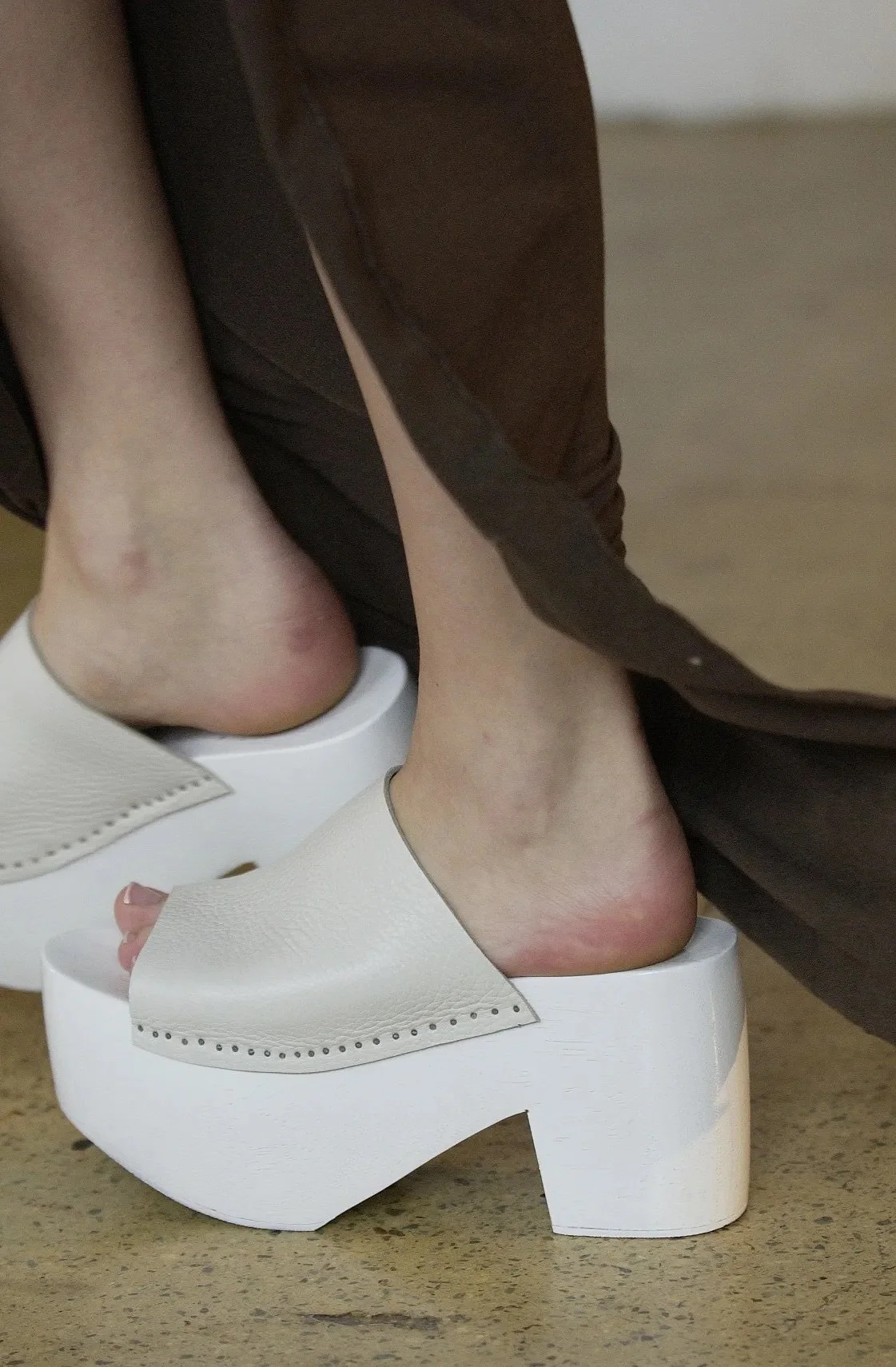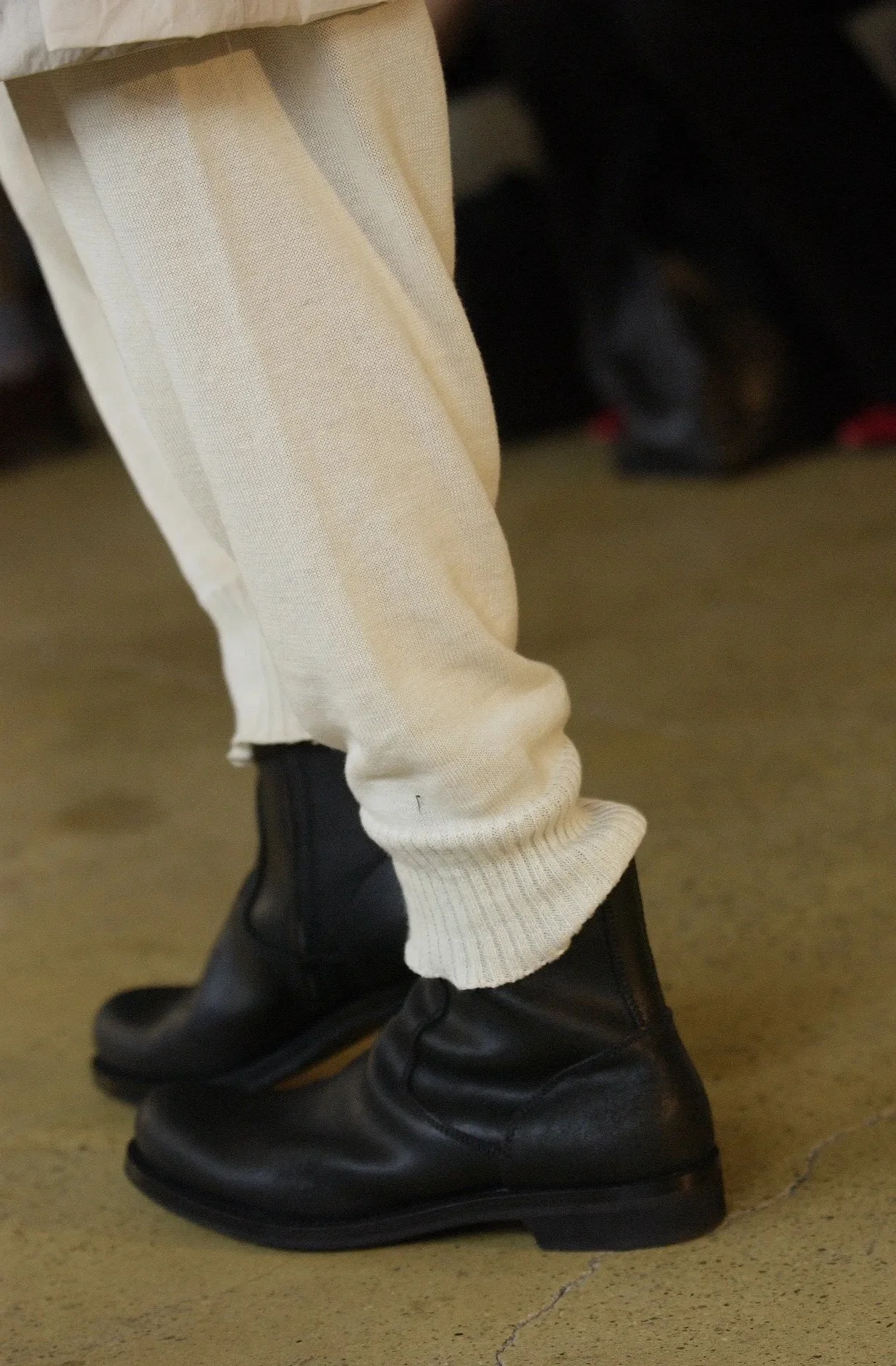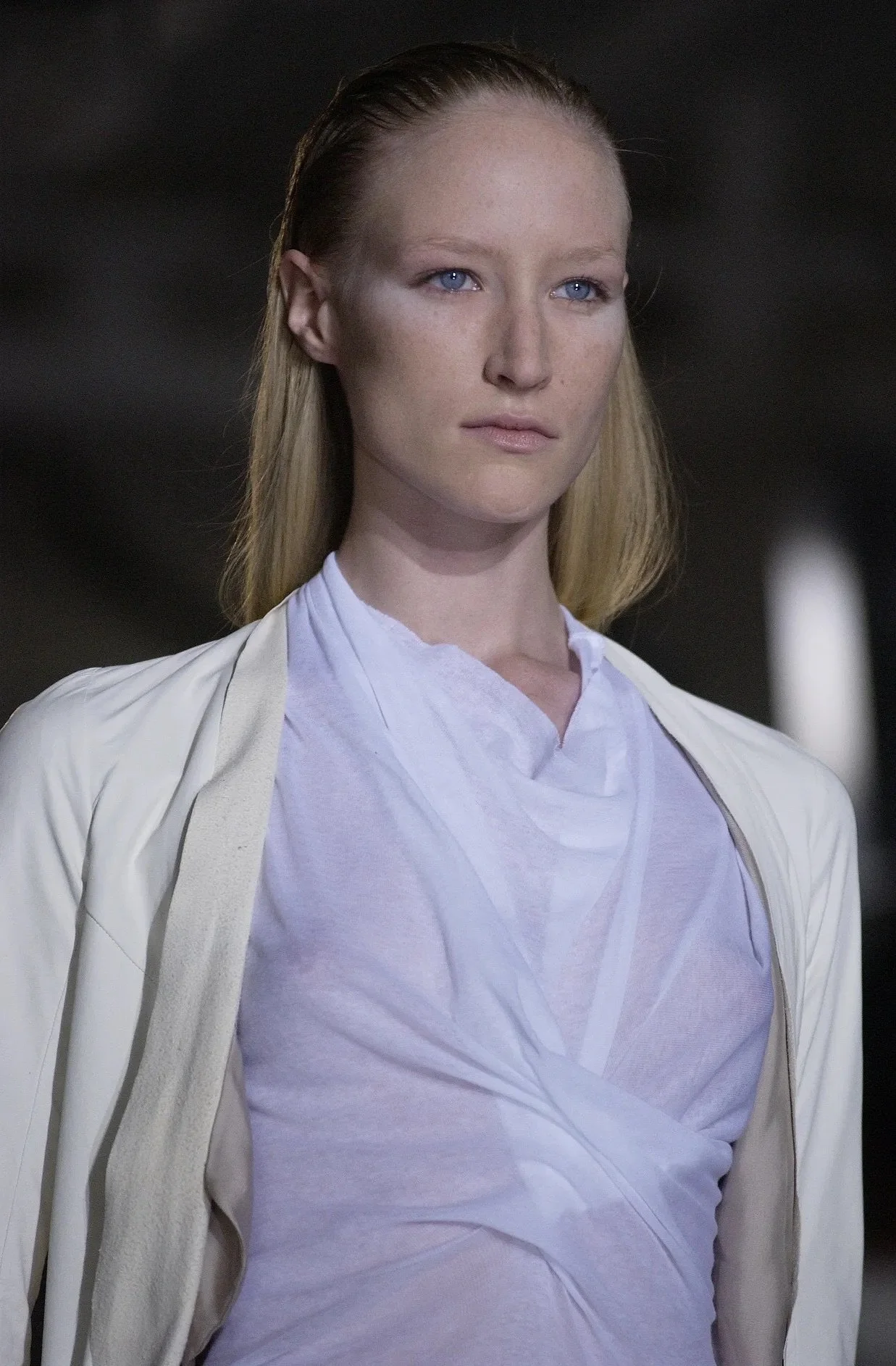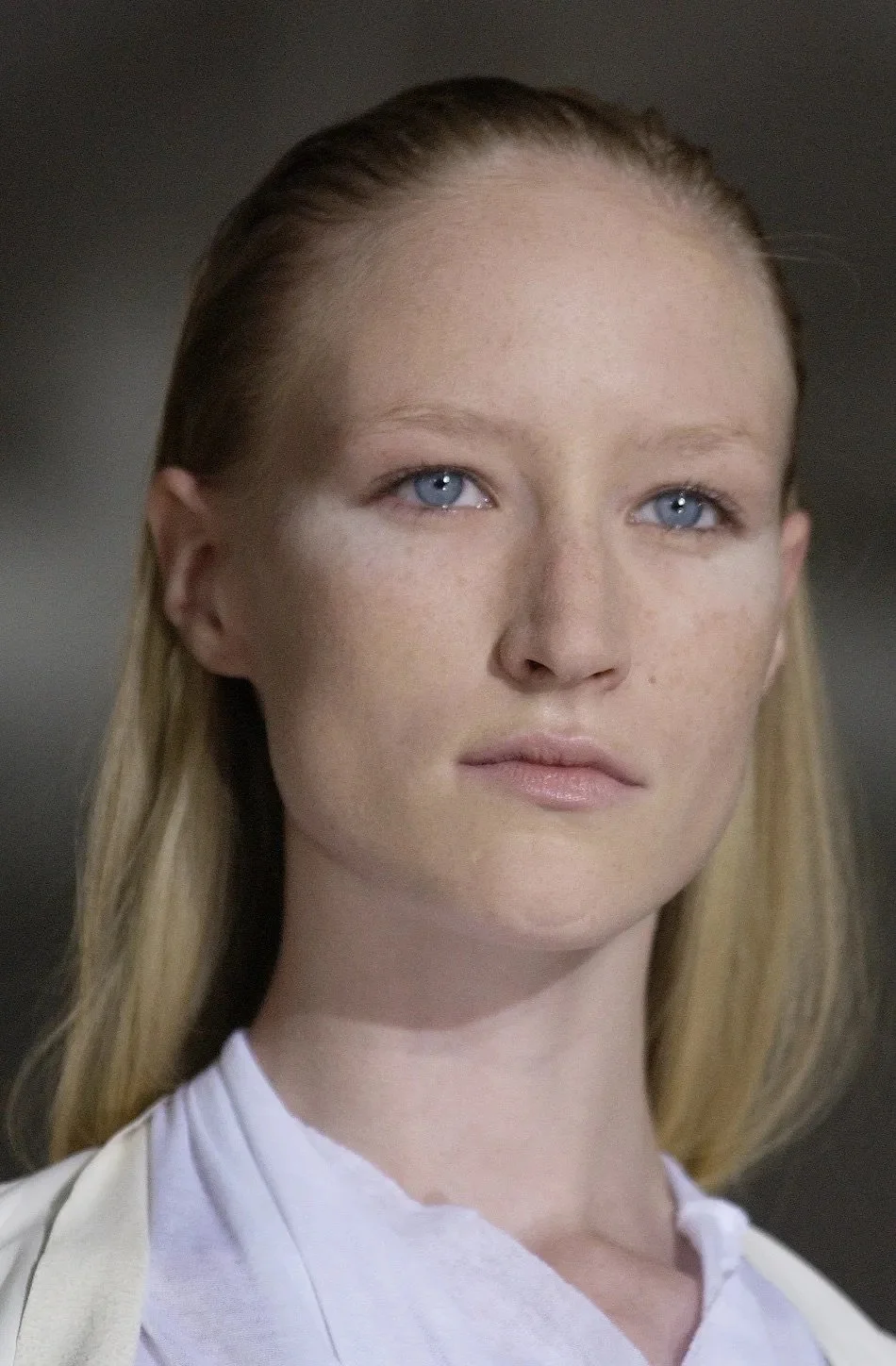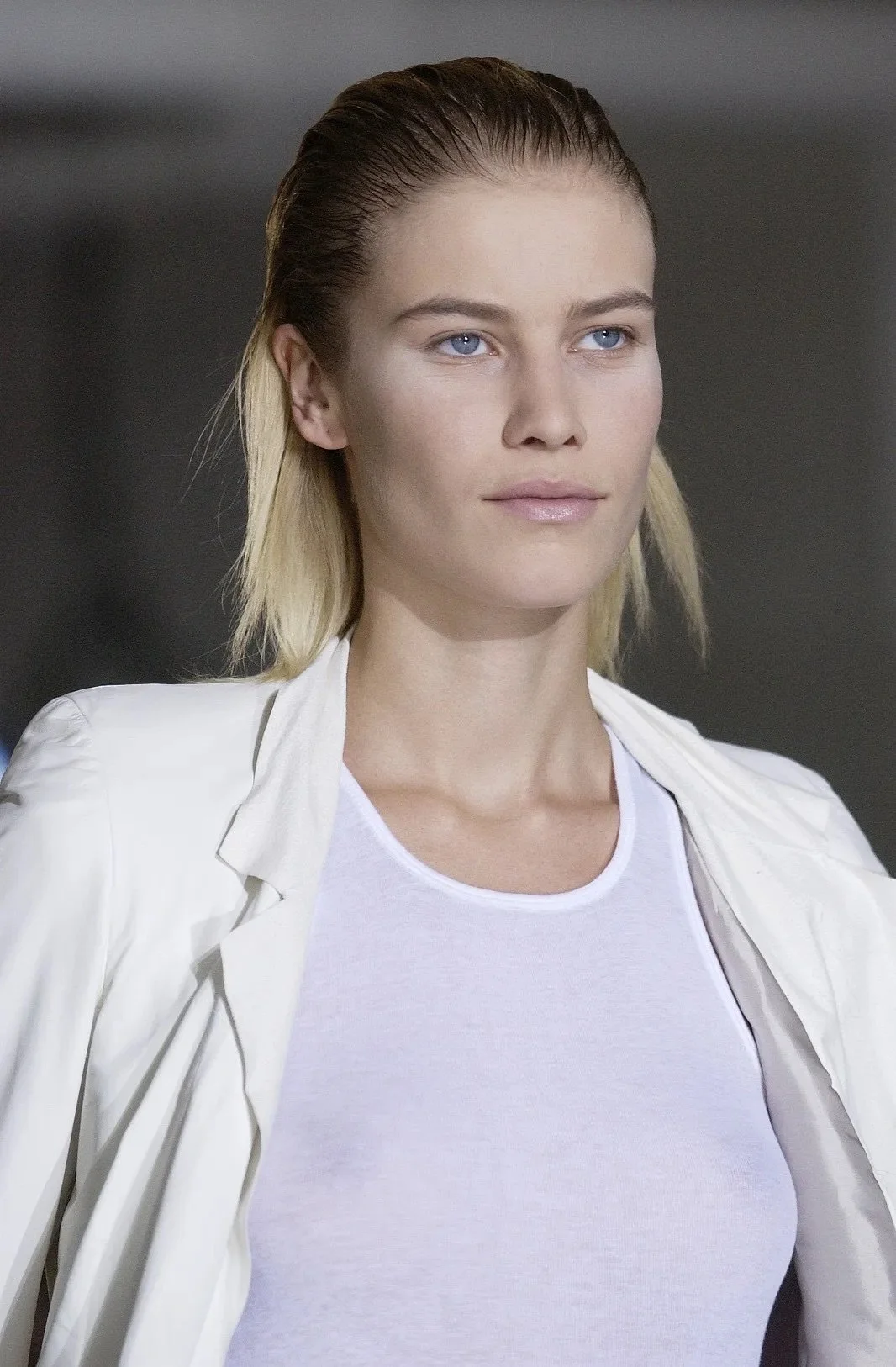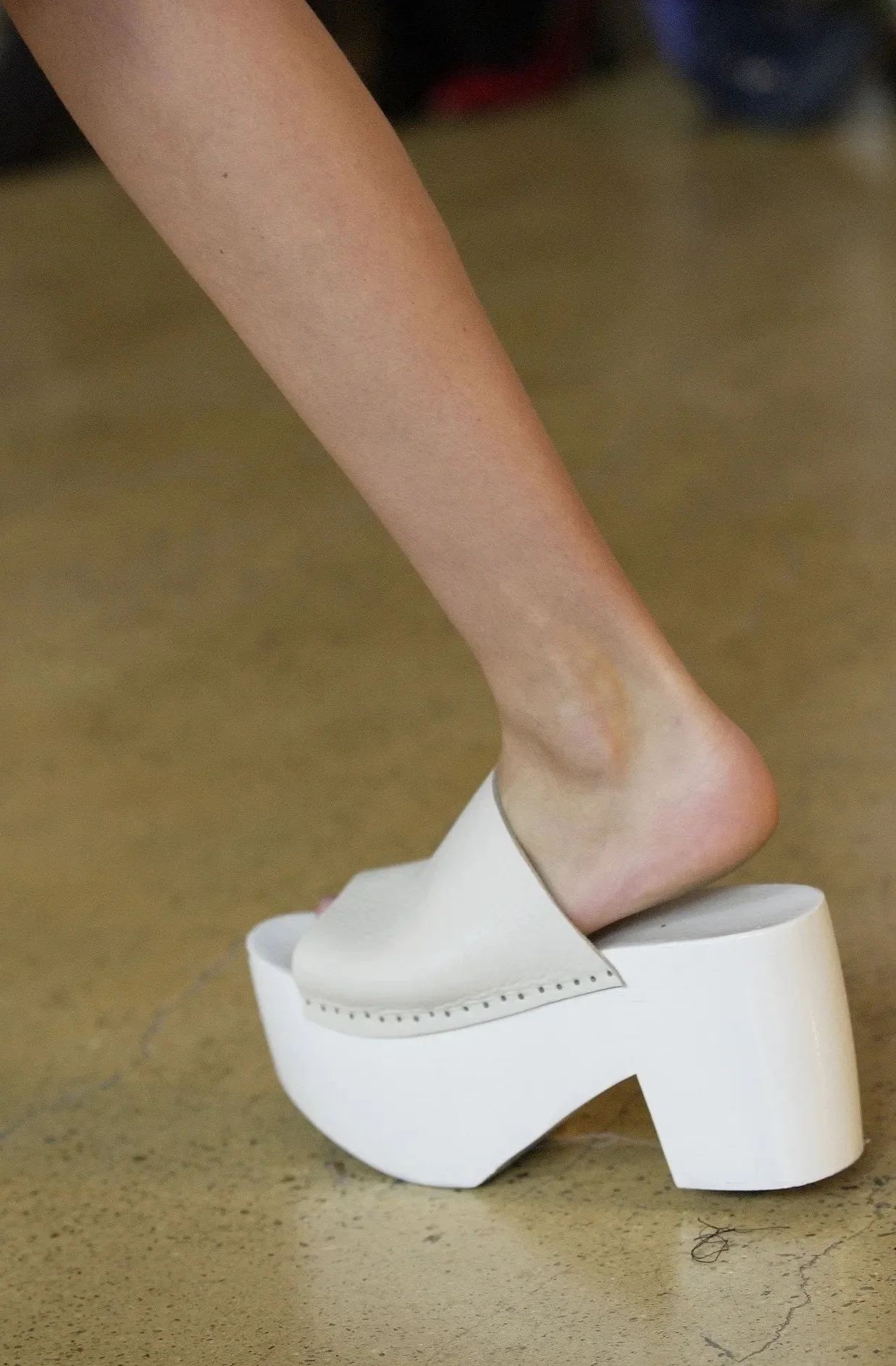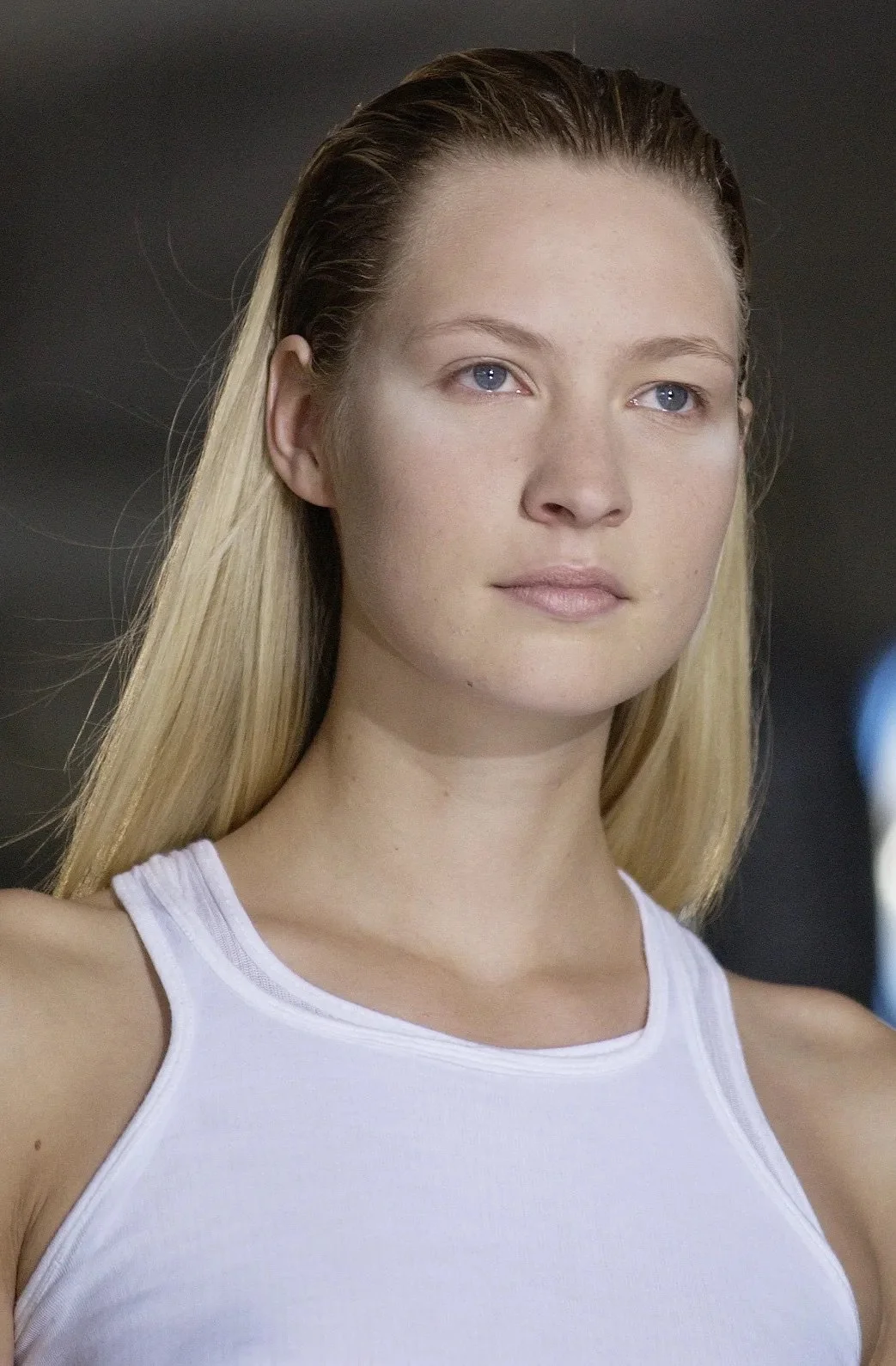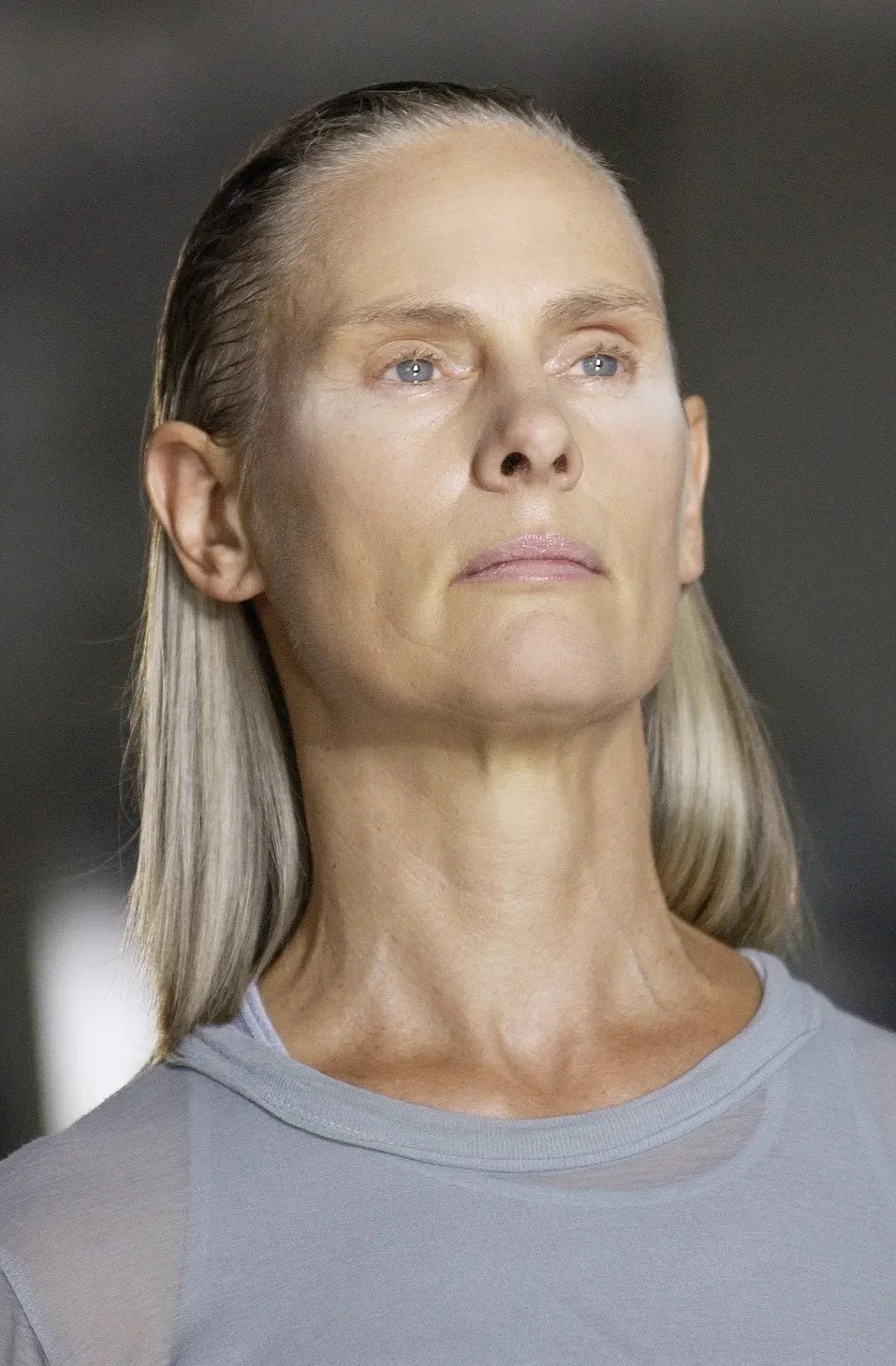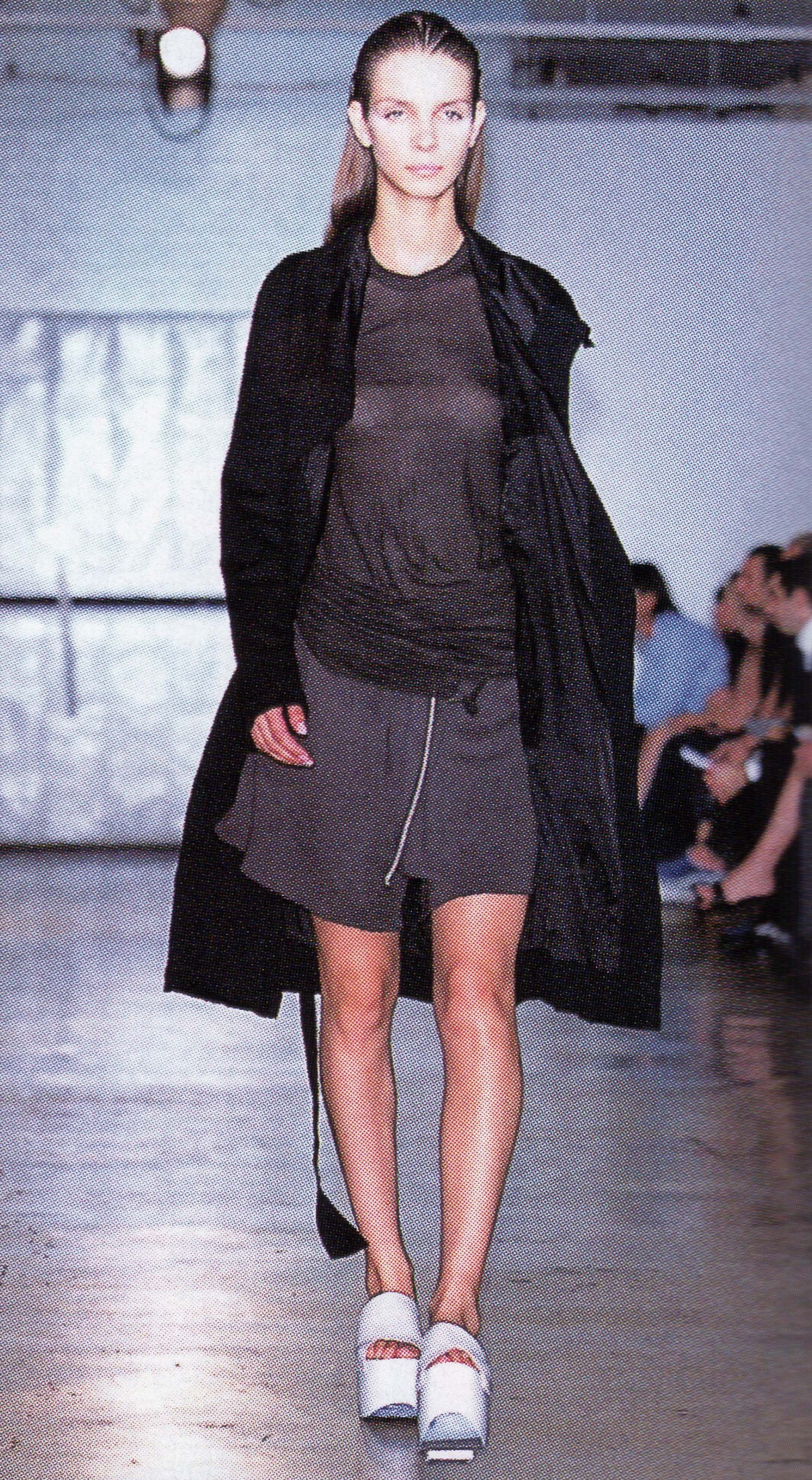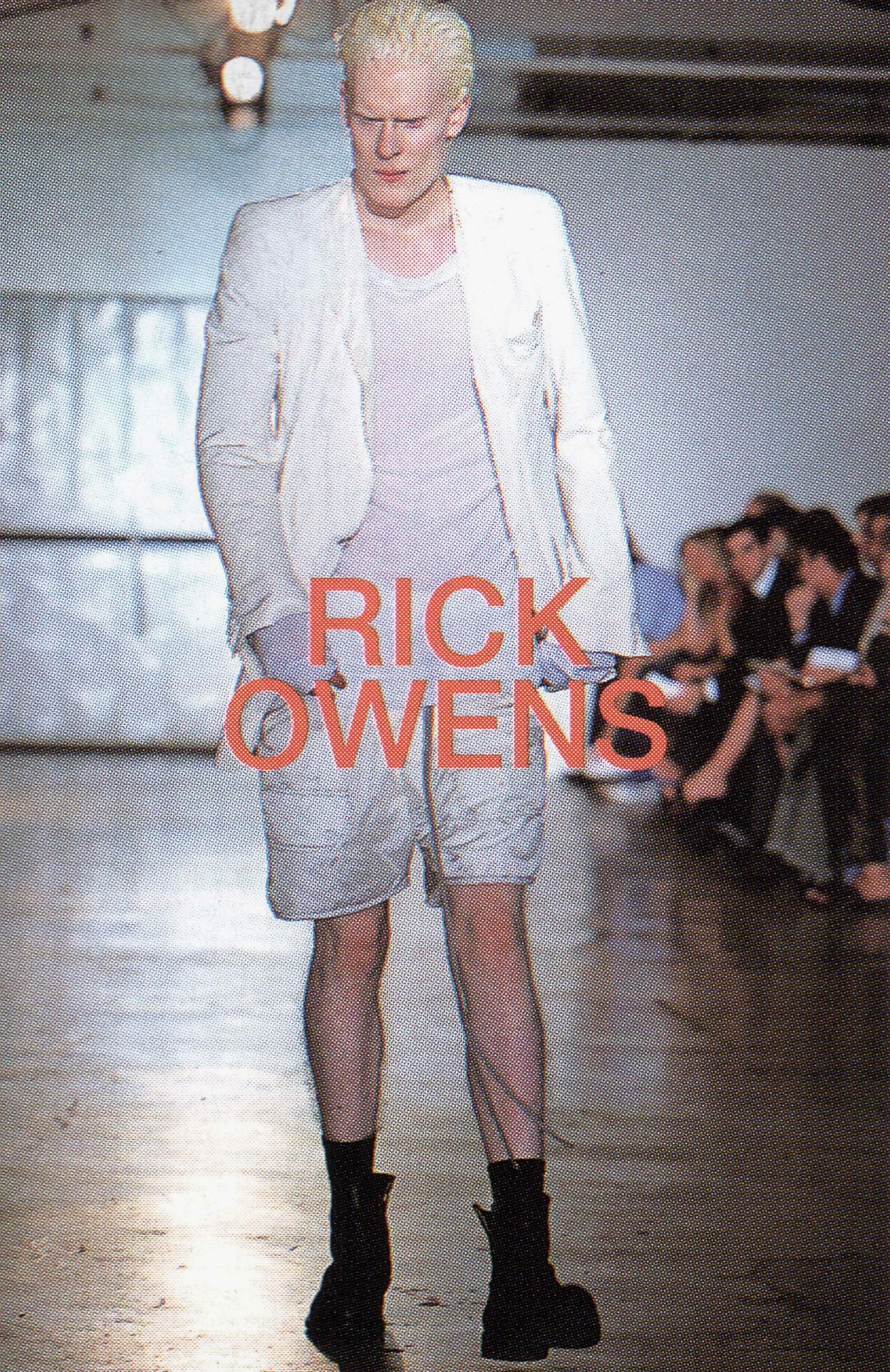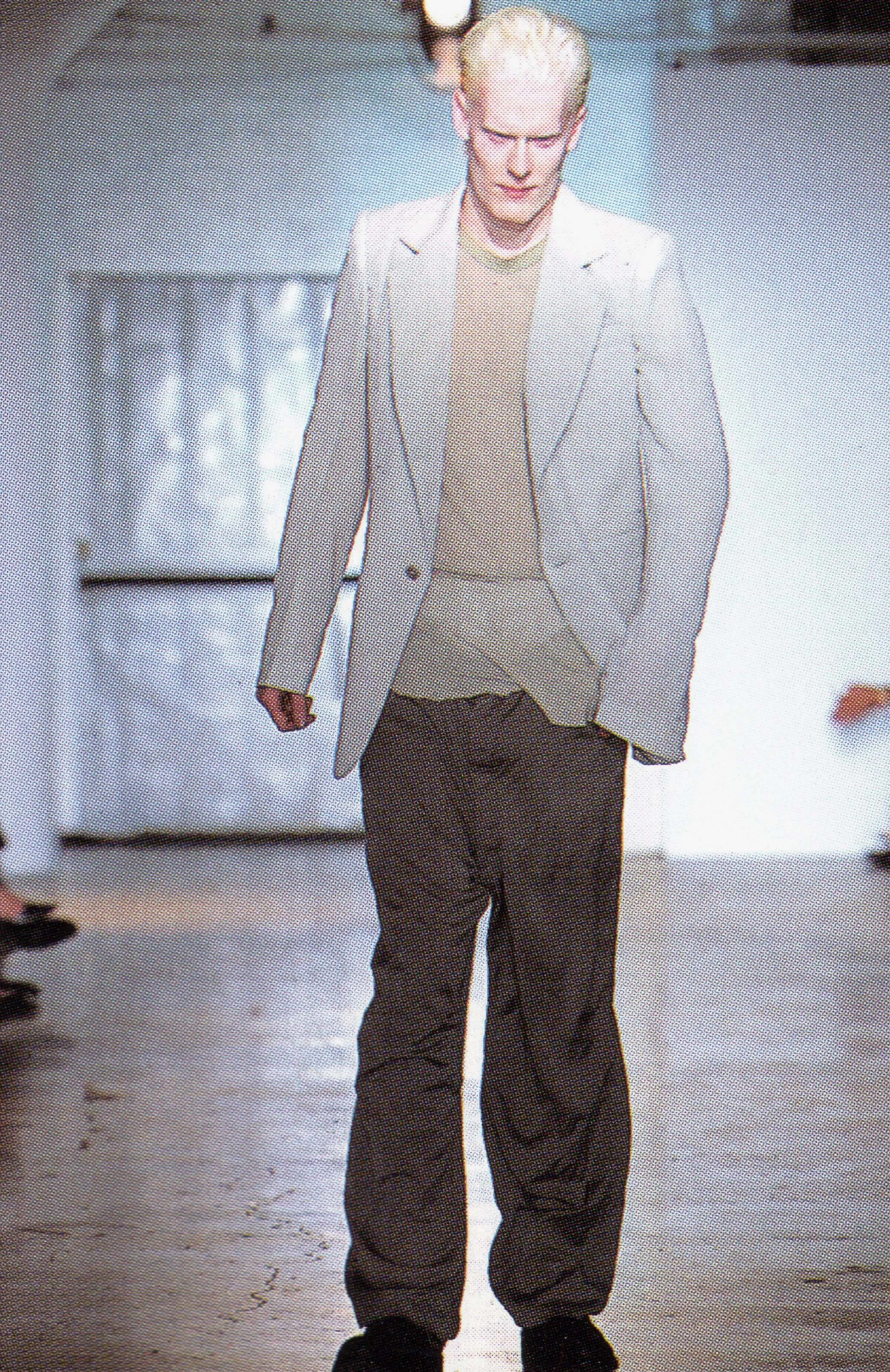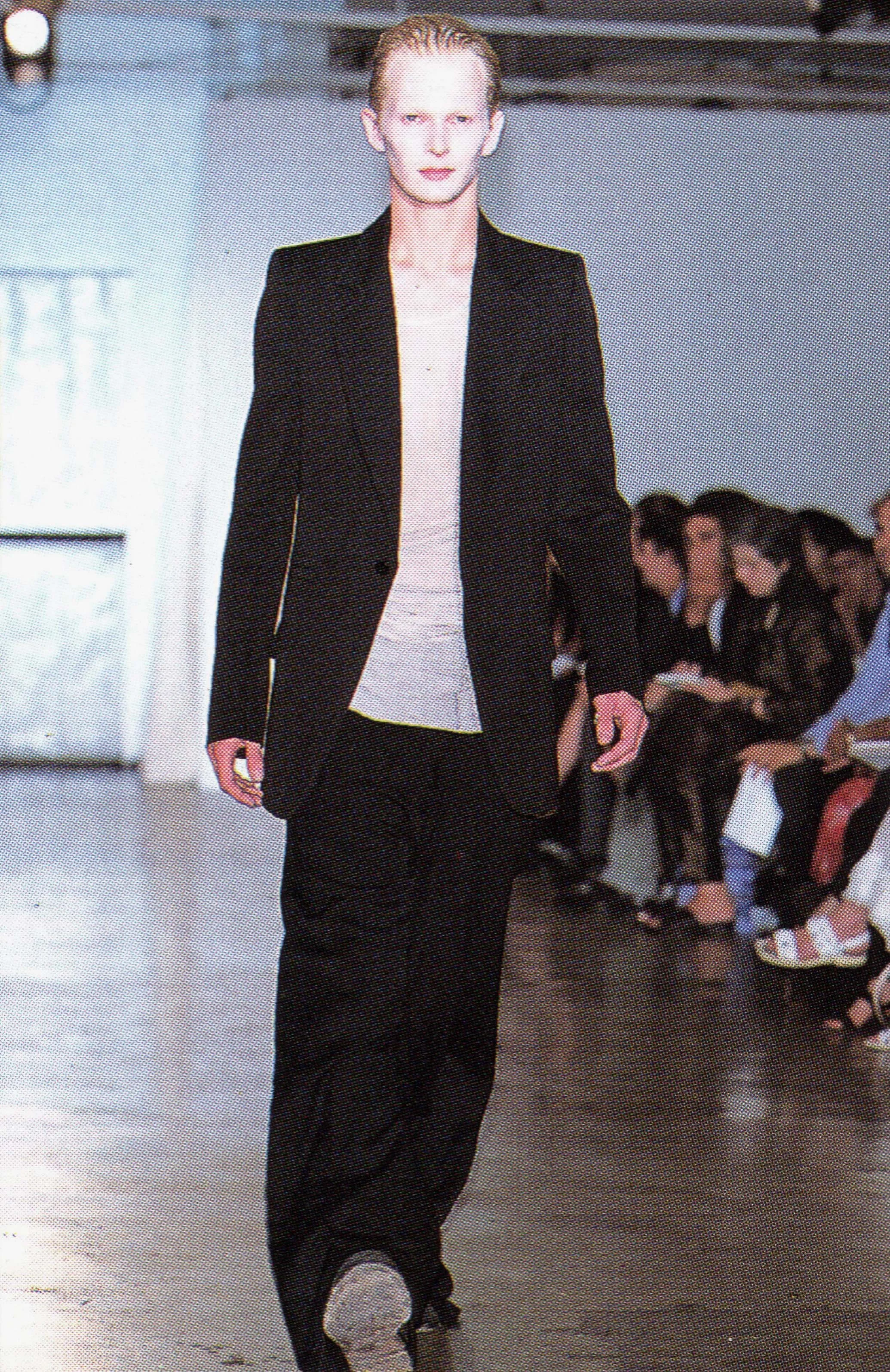Rick Owens
Spring/Summer 2003
SUCKERBALL
MUSIC
Foil, by Autechre
Let's Love, by Peggy Lee
Summer Breeze, by Type O Negative
Set Me On Fire, by Type O Negative
Sometimes, by Peggy Lee
The Heart is a Lonely Hunter, by Peggy Lee
FINALE
Foil, by Autechre
Giving the Body A Frank Embrace
September 21, 2002
The New York Times
Written by Cathy Horyn
[…] Perhaps like all fashion mavericks, Rick Owens enjoys a loyal following without really caring if his drab clothes are accepted. So he just keeps putting them out there -- this season, wafer-thin leather jackets twisting around the body and worn with wide pants in bedsheet cotton that belled over four-inch platform scuffs. They looked as clunky as a Dutchman's shoe, but the effect added up to a weirdly wonderful play of shapes and volume. Little tops. Big pants. Concrete shoes. They made the models walk like lumbering giants, but maybe that was the point: to slow fashion down.
Rick Owens: SPRING 2003 READY-TO-WEAR
September 20, 2002
Vogue
Written by Janet Ozzard
Photography by Brian Edwards
It's hard to believe that Rick Owens lives in the same Los Angeles that people like Sheryl Crow inhabit. His distinctly Gothic vision would appear more at home in a nice damp, dark climate—like, say, Antwerp.
Owens sometimes seems equally disconnected from the rest of the fashion community. Other designers may knuckle under, but rest assured a pencil skirt is never going to show up on his runway. And why should it? His talent is well established, and he has a loyal, bicoastal fan base happy to keep buying his soft wrapped jerseys, lightweight dresses and supple leathers.
That said, the designer’s Spring show was virtually identical to fall, except that the colors and fabrics were lighter, and both the men’s and women’s collections were presented. There are no hard edges to Owens' pieces: tailored pants and jackets are deliberately abraded and roughed-up; body-hugging dresses and skirts are fashioned from swaths of bias-cut, gossamer-light jersey; and his famous leathers are washed and crumpled. In fact, despite their lugubrious styling, Owens' pieces are sexy, beautifully made and supremely comfortable. Maybe he really is from L.A., after all.
Some victory laps for the sporting life
September 24, 2002
International Herald Tribune
Written by Suzy Menkes
[…] Rick Owens played with soft silhouettes by standing his models on high-platform shoes and by mixing textures with skill, so that distressed leather played off chiffon voile. What might have been a simple sportswear line was literally given a twist with graceful draping.
Celebrity stand-off: Who's who in front
September 24, 2002
International Herald Tribune
Written by Suzy Menkes
[…] Flop of the week? Farah Fawcett in Rick Owens's front row — but with a remodeled face that the photographers failed to recognize. […]
World Collections
2003 Spring & Summer: Paris, Milano, London, New York
2003春夏:パリ、ミラノ、ロンドン、ニューヨーク・コレクション。
February 2003
High Fashion No.289
Report and text by Teruyo Mori
Photography by Kei Taniguchi, Sangen, Koji Akita, Seiji Kakizaki
本拠ロサンジェルスからNYコレクションに参加して2度めのショー。子どもたちが着ているごく普通のウィンドブレーカーからインスピレーションを得た。シルエットは柳のように柔らかく細長く、色はモノトーンで、素材は極薄の軽さにこだわった。白ナイロンのウィンドブレーカーをキーアイテムに、シルクやカシミアを織り込んだ贅沢なジャージーのTシャツやドレープ使いのドレス、紙のように薄くなめしてしわをよせたボマージャケットなど、どれも「見かけは貧乏でも気分は贅沢」というコンセプトが貫かれている。
This is the second show participating in the NY collections from his headquarters in Los Angeles. The inspiration came from the ordinary windbreakers worn by children. The silhouettes were soft and slender like a willow, the colors were monotone, and the materials were ultra-thin and light. With the white nylon windbreaker as a key item, the collection includes luxurious jersey T-shirts woven with silk and cashmere, draped dresses, and paper-thin creased bomber jackets, all of which reflect the concept of “looking poor but feeling luxurious.”
Men’s Collections 2003 Spring & Summer: New York, London, Paris, Milan
2003春夏ニューヨーク、ロンドン、パリ、ミラノ・メンズコレクション。
February 2003
MR. High Fashion No.112
Photography by Seiji Kakizaki, Keiichi Taniguchi and Sangen Tanaka
10 Topics Around the Collections: Designers’ Interview
ワールドコレクションをめぐる10の話題。注目デザイナーのインタビュー。
February 2003
High Fashion No.289
Text by Teruyo Mori
洗練のスポーツウェアは アメリカンファッションの新定義。
ボディを柔らかにつつむジャージーのラップ。ドレープを生かしたバイアス裁ちのドレス。紙のように薄くなめしたレザーのトップ。といっても甘ったるさはなく、映画「マッドマックス」のようなタフであら削りな未来的要素が入った独特の世界。ごく普通のスポーツウェアのデザイナーが多いアメリカのファッション界に新風を吹き込むとして2002年6月、CFDAのペリー・エリス賞を受賞したリック。一見、ストリートとはかけ離れたファンタジーの世界のようだが、極めてリアルな服を作っているという。
「僕の服は現代のアメリカンスポーツウェアそのもの。街で歩いている人々を見てごらん?着古したTシャツや袖を引きちぎったシャツに裾を切り裂いたり、しみのついたジーンズをはいているでしょう。僕の服と同じ感覚。だから21世紀のアメリカンファッションだと思ってる」
といっても素材は一見、着古して破れそうなのだが、実はカシミアやシルクを織り込んで特別に開発したジャージー。テクニックは彼が尊敬しているクチュリエのヴィオネやグレを手本にしているから、彼の服は手に取るとそのクオリティと洗練度がよくわかる。
「僕が考えるファッションとは、見るからに高級そうな服を着て、私は金持ちなんですっていって歩くようなものじゃない。貧相に見えても自分自身は高級感や贅沢感を感じていられる服を作っている。僕自身、ものすごく高級なものも好きだけど、ガラクタのようなものも大好き。音楽ならリヒャルト・シュトラウスやワーグナーが好きだけど、同時にパンクも聴く。絵ならフランシス・ベーコンの世界が好き。この世の中、生きていておもしろいのは、ベストとワーストがあること。だから人生がおもしろい」
ファッションとは程遠い、南カリフォルニアの田舎町で生まれ育ったリック。高校時代の楽しみは友達とヘビーメタルを聴きながら川で泳いで隠れてビールを飲むくらい。それがある時、偶然「フレンチ・ヴォーグ」を見つけた。子どものころから絵が好きで画家になりたいと思っていたリックにとって、そのフレンチ・ヴォーグの洗練された世界は衝撃的だったという。ラフな田舎町とヴォーグの世界。この相反する二つの世界が服作りを始めたリックのコンセプトのベースになった。
「服はアートではないけれど、アートと同じように服を通して、着る人と僕が感情的につながりを持つことができると思っている。人人がデザイナーの服を買う意味というのは、そのあたりにあると思うよ」
Sophisticated sportswear is the new definition of American fashion.
A jersey wrap that softly wraps the body. A bias-cut dress making the most of its drape. Paper-thin leather tops. Yet there is nothing sweet about this unique world, which incorporates futuristic elements that are tough and rough, like the movie Mad Max. In June 2002, Rick received the Perry Ellis Award from the CFDA for bringing a breath of fresh air to the American fashion world, which is dominated by ordinary sportswear designers. At first glance, it seems like a fantasy world far removed from the street, but he says he makes extremely realistic clothes.
“My clothes are modern American sportswear itself. See the people walking around on the street? They are wearing worn-out T-shirts, shirts with the sleeves torn off, and stained jeans with the hems ripped off. It's the same feeling as my clothes. That's why I think of it as American fashion for the 21st century.”
At first glance, however, the material may look worn and torn, but it is actually a jersey specially developed by weaving cashmere and silk into the fabric. His techniques are modeled on those of couturiers Vionnet and Grès, whom he admires, so you can see the quality and sophistication of his clothes when you hold them in your hands.
“In my opinion, fashion is not about walking around wearing obviously expensive clothes and saying saying you’re rich. I make clothes that make me feel luxurious and expensive even though I look like a poor person. I personally like extremely high-class things, but I also love junk-like things. For music, I like Richard Strauss and Wagner, but I also listen to punk. For painting, I like the world of Francis Bacon. What's interesting about living in this world is that there are the best and the worst. That's why life is interesting.”
Rick was born and raised in a rural town in Southern California, far from fashion. The only fun he had in high school was listening to heavy metal with his friends, swimming in the river, hiding out, and drinking beer. Then one day, he stumbled upon French Vogue. The sophisticated world of French Vogue was a shock to Rick, who had loved drawing since childhood and wanted to be a painter. The rough countryside and the world of Vogue: these two contradictory worlds became the basis of Rick's concept when he started making clothes.
“Clothing is not art, but like art, I believe that through clothing, I can connect emotionally with the wearer. I think that is what it means for people to buy designer clothes.”


